







































































































































































DIVERSIFICATION IS HARD WORK BUT CAN PAY OFF, AS NIGEL AKEHURST DISCOVERS ON A VISIT TO MOUSEHALL IN THE HIGH WEALD, NOW TRANSFORMED INTO A FAMILY RUN, SUSTAINABLE DISTILLERY AND WINERY



Cladco Steel Roofing Sheets are suitable for agricultural, industrial and domestic applications, available in up to 14 colours. Speak to our expert Sales team to find out more.

Corrugated, Box Profile, Tile Form and Standing Seam Roofing Sheets Available Cut To Custom Lengths
Polyester Paint, PVC Or Prelaq Mica Coatings

Pictured: 13/3 Corrugated Roof Sheets Nationwide Delivery Or Collection
Andover Branch 55 Reith Way, Andover, Hampshire SP10 3TY
Mon-Fri 8am to 5pm, Sat 8am to 1pm
Head Office Beardown Road, Exeter Road
Industrial Estate, Okehampton, Devon EX20 1UA
Mon-Fri 8am to 5pm, Sat 8am to 1pm

www.southeastfarmer.net
SOUTH EAST FARMER
Kelsey Media, The Granary, Downs Court Yalding Hill, Yalding, Maidstone, Kent, ME18 6AL 01959 541444
EDITORIAL
Editor: Malcolm Triggs
Email: sef.ed@kelsey.co.uk
Photography: Martin Apps, Countrywide Photographic
ADVERTISING & MARKETING
Jamie McGrorty 01303 233883 jamie.mcgrorty@kelsey.co.uk
GRAPHIC DESIGN
Jo Legg 07306 482166 jo.legg@flair-design.co.uk
MANAGEMENT
DIVISIONAL MANAGING DIRECTOR: Steve Kendall
PUBLISHER: Jamie McGrorty
RETAIL DIRECTOR: Steve Brown
SUBSCRIPTION MARKETING MANAGER: Claire Aspinall
PRINT PRODUCTION MANAGER: Kelly Orriss
DISTRIBUTION
Distribution in Great Britain: Seymour Distribution Limited 2 East Poultry Avenue, London EC1A 9PT Tel: 020 7429 4000 www.seymour.co.uk
Distribution in Northern Ireland and the Republic of Ireland: Newspread Tel: +353 23 886 3850
Kelsey Media 2024 © all rights reserved. Kelsey Media is a trading name of Kelsey Publishing Ltd. Reproduction in whole or in part is forbidden except with permission in writing from the publishers. Note to contributors: articles submitted for consideration by the editor must be the original work of the author and not previously published. Where photographs are included, which are not the property of the contributor, permission to reproduce them must have been obtained from the owner of the copyright. The editor cannot guarantee a personal response to all letters and emails received. The views expressed in the magazine are not necessarily those of the Editor or the Publisher. Kelsey Publishing Ltd accepts no liability for products and services offered by third parties.
Kelsey Media takes your personal data very seriously. For more information on our privacy policy, please visit www.kelsey.co.uk/privacy-policy/
If at any point you have any queries regarding Kelsey’s data policy you can email our Data Protection Officer at dpo@kelsey.co.uk www.kelsey.co.uk
Cover picture: Mousehall


04 Plans to eradicate Bovine TB have failed to impress.
05 Blow to livestock farmers as bluetongue restricted zones introduced.
06 College graduate and would-be firstgeneration farmer Noah Smith has hit on an innovative way of pursuing his dream career in agriculture.
14 MONICA AKEHURST
Rats cause carnage, creating a mountain of nuts, paper, shredded pallet and plastic.
18 NIGEL AKEHURST VISITS...
Mousehall, a family-run, sustainable distillery and winery nestled in the scenic High Weald National Landscape to discover how the Jordan family has transformed the historic country estate into an awardwinning wine and spirits business. 22 MIKE KETTLEWELL Connemara farming.


Government plans to eradicate bovine tuberculosis (bTB) and phase out badger culling by the end of this Parliament have failed to impress either side in the fierce, ongoing debate.
While the Badger Trust was quick to protest about the fact that the cull would continue while efforts to find an alternative solution to the problem were progressed, the Country Land and Business Association (CLA) stressed that culling needed to be retained as part of the fight against the disease.
The debate was re-ignited by the announcement of the Government’s new TB eradication strategy aimed at ending the cull while driving down rates of infection “to save cattle and farmers’ livelihoods”.
The announcement pointed out: “Over the past decade, TB has had a devastating impact on British livestock and wildlife. Over 278,000 cattle have been compulsorily slaughtered and over 230,000 badgers have been killed in efforts to control the disease, costing taxpayers more than £100 million every year.
“For the first time in over a decade, the Government will introduce a new bovine TB eradication strategy working with farmers, vets, scientists and conservationists to rapidly strengthen and deploy a range of
disease control measures.
“The new strategy will mark a significant step-change in approach to tackle this devastating disease, driving down TB rates and saving farmers’ livelihoods and businesses. It will use a data-led and scientific approach to end the badger cull by the end of this parliament.”
Work will start immediately and include the first badger population survey in over a decade, with the Government admitting that policy makers currently have “no clear idea of the impact culling techniques have on our badger populations”. The new survey will be launched this winter to “illustrate the impact of widespread culling over the past decade”.
Also planned is a new national wildlife surveillance programme to look at the prevalence of TB in remaining badger populations and other wildlife such as deer.
“Together with updated estimates of badger abundance, this will unlock a data-driven approach to inform how and where TB vaccines and other eradication measures are rapidly deployed to drive down TB rates and protect farmers’ livelihoods,” the announcement went on.
The strategy also includes establishing a new “badger vaccinator field force” to increase badger vaccination and a study
aimed at rapidly analysing the effect of badger vaccination on the incidence of TB in cattle. “In addition, we will accelerate work on the development of a cattle vaccine, which is at the forefront of innovative solutions to help eradicate this disease,” the Government said, adding: “The next stage of field trials will commence in the coming months. Our aim is to deliver an effective cattle TB vaccination strategy within the next few years to accelerate progress towards achieving officially TB free (OTF) status for England.” Minister for Food Security and Rural Affairs Daniel Zeichner said the disease had “devastated British farmers and wildlife for far too long” and had “placed dreadful hardship and stress on farmers who continue to suffer the loss of valued herds”, before stressing: “No more. Our comprehensive TB eradication package will allow us to end the badger cull by the end of this parliament and stop the spread of this horrific disease.”
In response, the CLA’s President, Victoria Vyvyan, said scientific evidence “shows that badger culling is an effective means of controlling bTB” and added: “Livestock farmers have to protect the health of their cattle and any alternative to culling has to be proven before the Government begins
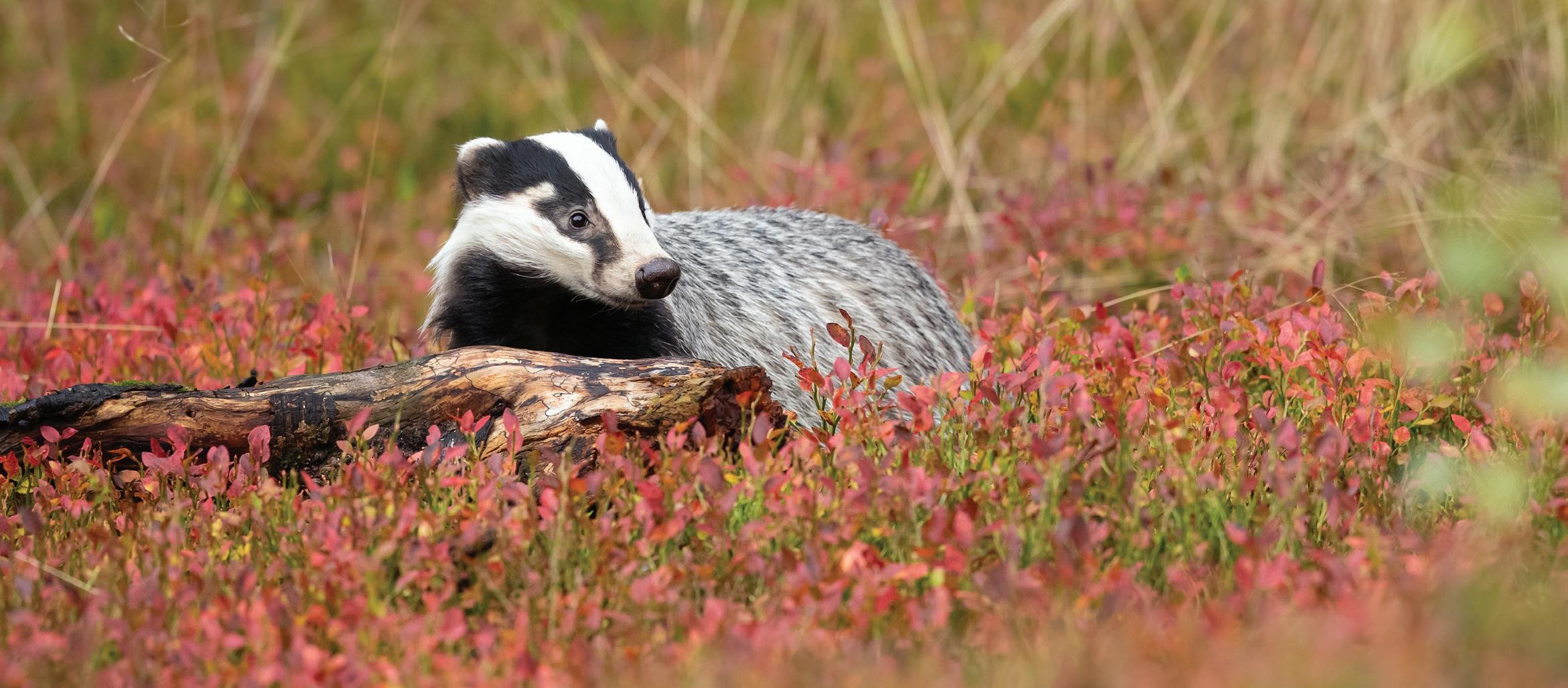
phasing out the existing means of control.
“The disease poses a significant threat to the livestock industry, with more than 20,000 cattle slaughtered in 2023. With the help of the culls the statistics show an improving picture, but this hard-fought progress cannot be put in jeopardy.
“Effective control of bTB and realisation of the government’s ambition to eradicate it requires every effective tool, including culling, to be on the table.”
Meanwhile the Badger Trust and allied wildlife and nature groups held a demonstration and lobby of Parliament in what they said was “a powerful display of unity to call for the new Government to end the cull immediately as intensive badger killing begins again”.
Broadcaster and campaigner Chris Packham branded the cull “completely unscientific, brutally inhumane, wholly ineffective, incalculably shameful” and added that “the blood of two hundred and thirty thousand badgers drips from the hands of cruel politicians, inept agencies and the abject mischief of the farming lobby”.
The trust’s concern stems from the fact that while launching the new strategy aimed at ending the cull over the next five years, incoming DEFRA Secretary of State Steve Reed has granted the licences that will allow it to continue in the meantime. The trust said the licences would allow around 50,000 badgers to be killed in 2024 alone and said the policy would put the animal “at threat of local extinction in parts of England”.
Badger Trust Chief Executive Peter Hambly said: “This new Government continues the old Government’s policy of targeting and scapegoating badgers. They condemn them to death with a relentless focus on misinformation and a failure to deal with the ignorance about the true causes of bTB spread from cattle to cattle.”
He added: “In its election manifesto, Labour described badger culling as ‘ineffective’; so why did the intensive badger cull start again this weekend under their watch?
“Government figures show that 94% of bTB spreads from cattle to cattle, and that badgers are 800 times more likely to be infected with bovine tuberculosis by cattle than to infect cattle themselves.”
A bluetongue restricted zone (RZ) has been introduced across much of the east of the country, including Essex, Kent and East Sussex, after cases of BTV-3 were identified.
The news has come as a blow to livestock farmers and markets in the affected areas, although, in better news, DEFRA has permitted the use of three unauthorised bluetongue serotype 3 (BTV-3) vaccines within the UK.
The DEFRA announcement pointed out: “Following suspicion of clinical disease in cattle and sheep at premises in East Sussex, Kent, Norfolk and Suffolk, the UK CVO [Chief Veterinary Officer] has confirmed five new cases of BTV-3.”
As a result, The RZ covering Norfolk and Suffolk and Essex, declared on 30 August, was extended to include Kent and East Sussex as well as part of Greater London. An earlier temporary control zone (TCZ) around Faversham was revoked, with the area now included in the restricted zone.
The NFU’s online advice on bluetongue points out that farmers should only move animals within the RZ “where this is absolutely necessary”. It warns: “Any movement carries risk of disease spread.”
The guidance goes on: “Animals may be moved into a market within the zone, but on leaving the market cannot be moved to premises out of the zone. Moves to markets outside the zones are not currently allowed.”
Meanwhile the Secretary of State has granted licences for the use of three ‘unauthorised’ BTV-3 vaccines but has pointed out that they are designed to reduce the effect of bluetongue rather than preventing it.
The NFU explained: “This means they may not prevent your animals from being infected or infectious, but (depending on the vaccine) their claims include reduction
or prevention of clinical signs experienced or mortality.” The advice adds: “For this reason, all movement controls and trade restrictions still apply to vaccinated animals.”
The vaccines, Bultavo-3, Bluevac-3 and Sylvazul-3, have been approved in the EU for emergency use and, in the NFU’s words, “could provide a benefit in terms of individual animal health and welfare”.
The manufacturer of Bultavo-3, Boehringer Ingelheim, has said that the vaccine will initially be restricted to high-risk counties in England, including Essex, Kent and East Sussex, “to manage supply and demand”.
It said its inactivated injectable vaccine “has been shown to significantly reduce viraemia and prevent mortality and clinical signs associated with BTV-3 infection”, with immunity in sheep beginning three weeks after a single 1ml subcutaneous dose. In cattle, two 1ml intramuscular doses are required at a three-week interval.
South East Farmer correspondent Alan West described the vaccines as “not perfect but very much better than nothing” and said they would “help no end, depending on availability”.
Alan added that while the initial cases picked up through routine blood testing had not been active or infectious, the recent cases seemed to relate to animals with active symptoms, pointing to the fact that BTV-3 was now circulating.



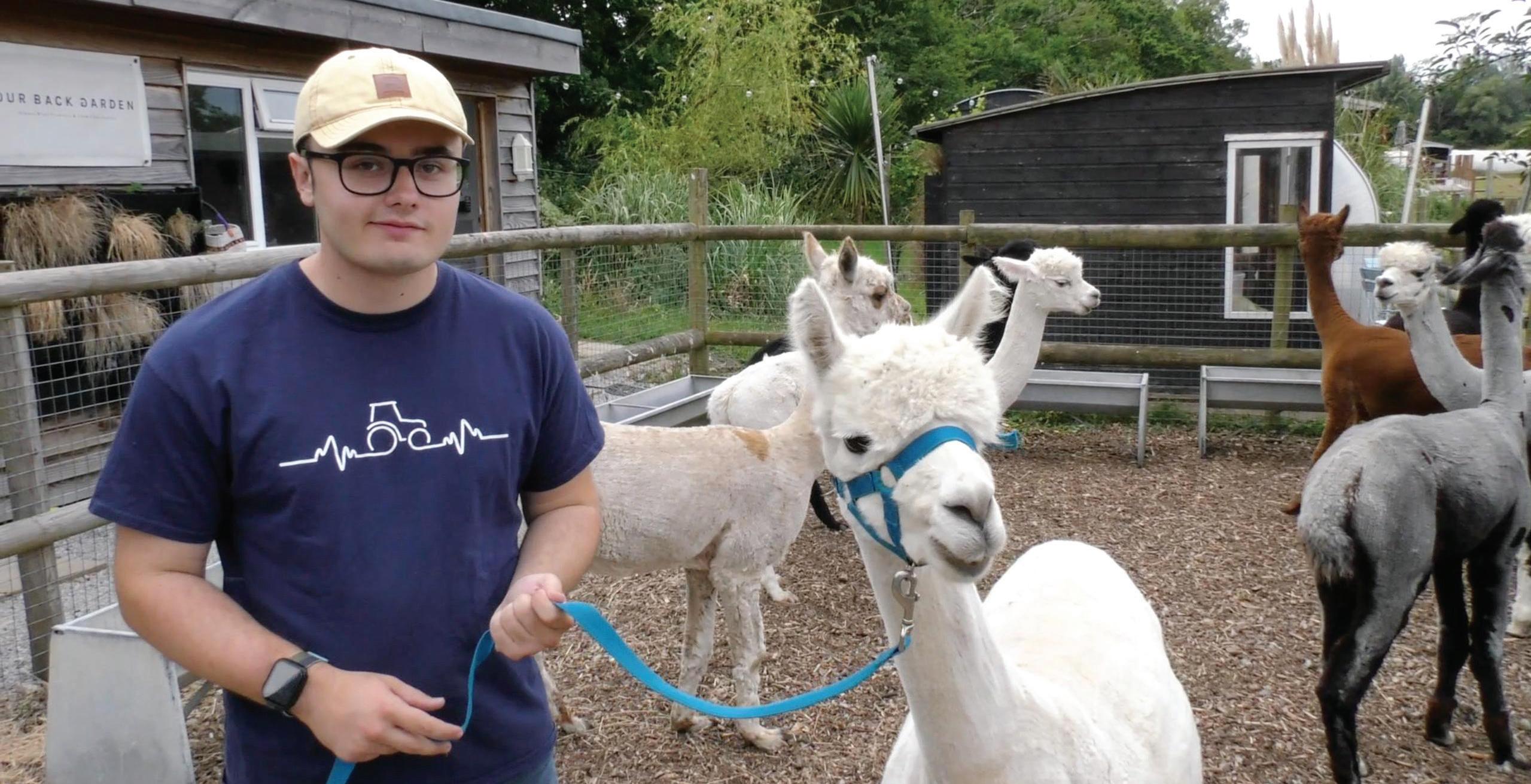
College graduate and would-be first-generation farmer Noah Smith has hit on an innovative way to pursue his dream career in agriculture.
Noah, from Horndean in Hampshire, has produced a lively, short YouTube video highlighting his skills and underlining his determination to succeed.
In the video he explains that he made the video because he suffers from autism and “may not express myself brilliantly in an interview”.
He goes on to point out the positive side of his autism, telling potential employers: “If you show me how to do something I will always do it that way because I want to be safe.” He then jokes that when developing his skills at operating agricultural machinery: “I find reading the manual is a good way for me to do that”.

Noah has just finished a two-year course at Sparsholt College, where he passed his level 3 agriculture course in the first year and specialised in arable farming in the second. He has tractor, telehandler and ATV licences and received an award from the Worshipful Company of Farmers as Student of the Year.
A former head prefect at Horndean Technology College, Noah has also been published twice, having his work on increasing understanding of autism featured in academic textbooks.
At the start of his second year at Sparsholt College, Noah took the opportunity to travel to Costa Rica on an agricultural study tour to visit farms and learn about their practices. His ambition is to work on an arable farm, perhaps with sheep, but he admits to not liking cattle.
Watch the video at https://bit.ly/3XEthEE
At the pinnacle of a career spanning nearly 70 years, Peter Simpson is continuing to advise growers across Hampshire, Wiltshire and Devon, despite being just a month or so short of his 88th birthday.
Born in November 1936, Peter has been selling agricultural feed and seeds since 1957 and still makes farm visits, although fewer than in the past.
During his career he saw oilseed rape
become a significant break crop in the UK, with a record 744,000 hectares of the crop planted in 2012 before the more recent decline, in part because of the impact of cabbage stem flea beetle.
Peter, a self-employed agent since the early 1990s, now sells oilseed rape varieties such as Pinnacle – the highest-yielding conventional rape variety on the AHDB’s recommended list for the past two years –on behalf of Grainseed.
A new foundation has been launched to support and improve the mental health of those living and working in rural and agricultural communities and try to reduce the number of suicides across the industry.
Although focusing on supporting people in Buckinghamshire, Northamptonshire and Bedfordshire, the founders of The Rural Communities Mental Health Foundation have said it will extend its services to people from other counties who reach out for help.
The co-founders of the charity, Kate Scott and Lewis Hunter, are from farming backgrounds and have been directly affected by suicide, giving them an understanding of the impact of losing a loved one in such circumstances.
They were inspired in part by statistics that show the suicide rate for male farm workers is three times the male national average and that three people in the UK farming and agricultural industry commit suicide every week.
Kate said: “It’s our aim to help anyone struggling with their mental health realise they’re not alone and that help and support is out there.
“We will deliver funded training to empower people to have more confident and informed conversations, focusing on free mental health first aid training sessions initially, and will work to educate the next generations and normalise the conversation around mental health and suicide.” www.rcmhfoundation.org


There’s no evidence that Shakespeare, despite being born in the bucolic, almost-Cotswolds surroundings of Stratfordupon-Avon, took more than a passing interest in agriculture, but he might have had farmers in mind when he made Claudius proclaim: "When sorrows come, they come not single spies but in battalions."
Spoken after Ophelia’s death in Hamlet, the line might equally have been uttered by a livestock farmer, landowner or landlord after the events of the past few weeks – not to mention by cereal growers contemplating generally average at best harvests.
Bluetongue, the midge-born scourge of cattle and sheep famers, has returned, bringing with it the potential to cause chaos for those looking to market their animals, as well as the threat to health posed by the disease itself.
Land and property owners who have worked hard to build up their estate and are looking to the future will be worried by the increasing rumours of an inheritance tax-based raid by The Chancellor in the forthcoming budget, with agricultural property relief and business property relief rumoured to be under threat.
And they’re not the only clouds on the horizon, with plans for all rental properties to be made to achieve an energy performance certificate rating of C or above likely to dismay landlords in rural locations with more unusual properties for which adding a bit of a secondary double glazing simply won’t cut it.

As the CLA has pointed out, trying to apply standards based on ‘average’ urban properties to those in more rural, off-grid locations, however noble and vote-winning the policy may be, would be a non-starter in many cases.
The sad thing is that such a policy is more likely to restrict the availability of rented properties in the countryside than it is to make a significant impact on the country’s carbon footprint.
It’s another example of desk-bound politicians trying to do the ‘right’ thing without thinking through the consequences. In all situations, including working out the best way to handle the bluetongue outbreak, those in charge need to balance what they are trying to achieve with the impact on those who carry the responsibility for achieving it.
These are difficult times, but they are far from unique, as Shakespeare himself, having been born in 1564 just after a particularly virulent outbreak of the plague, might have observed.



EMAIL YOUR VIEWS, LETTERS OR OPINIONS TO: sef.ed@kelsey.co.uk or write to the address on page 3
® MALCOLM TRIGGS - EDITOR






The 2024 South of England Farming Conference will take place at the South of England Showground, Ardingly, and online. It will feature an in-depth panel discussion focusing on the unique challenges and opportunities related to land use in the South East of England and will conclude with a Q&A session. There will be pre- and post-event refreshments and
for those attending in person.





@SouthEngShows #FarmingConference
CHAIR Charlotte Smith: Presenter on BBC Radio 4’s Farming Today and BBC1’s Countryfile
Paul Christian: Leads Sentry, an employee-owned farming and advisory business specialising in rural asset management, contract farming and management services, covering 23,000 ha and producing 200,000 tonnes of produce annually.
Tom Heap: Presenter on BBC1’s Countryfile and Radio 4’s new Rare Earth series. His latest book is Land Smart: How to Give People and Nature the Space to Thrive
Tim Slaney: Oversees the vision and strategy for the South Downs National Park Authority, focusing on nature recovery, climate action, and being a ‘National Park for All’.
Ben Taylor: Manages Iford Estate, a 1,200 ha mixed farming business within the South Downs. The estate has launched a progressive biodiversity project to restore habitats while retaining food production on its most fertile land.






Farmers have been urged to prioritise safety after figures revealed that 27 people were killed in Britain’s agricultural industry, including two in the South East, in 2023/24.
The figures from the Health and Safety Executive (HSE) related to fatalities logged under the Reporting of Injuries, Diseases and Dangerous Occurrences Regulations (RIDDOR) over the past year. The sector encompasses forestry and fishing as well as agriculture.
“The number of fatalities serves as a stark reminder for anyone involved in agriculture that safety must always be a top priority,” said Alex Cormack, of Lycetts Risk Management Services.
“While accidents can happen, many are preventable. It is crucial to implement and maintain rigorous safety protocols, which may include regular training, the proper use of equipment and strictly adhering to all safety guidelines.
“Farmers should also conduct regular risk assessments to identify and mitigate potential hazards on their farms. By taking these proactive steps, we can reduce the number of preventable incidents and protect
Roger Kerr, chief executive of OF&G (Organic Farmers and Growers), is stepping down after 10 years at the helm of the UK organic certification body.
Responding to the resignation announcement, OF&G board chairman Richard Thompson said: “Roger has been instrumental in OF&G’s growth in stature and recognition as the organic certifier responsible for certifying over half of the UK’s overall organic land area.
“He has remained true to organic’s core principles, delivering high quality certification services while championing the sector and taking a pragmatic approach to protecting the interests of the organic farming community."
Roger, who will remain in post until a successor is appointed, said he was “incredibly proud of OF&G and all that the team has achieved”, but added: “Now is the time for me to explore other personal business and consultancy opportunities. I am also looking forward to spending more time with my family and grandchildren.”
the lives of both workers and the public in this essential industry.”
In the South East, both the deceased were male, with one over the age of 65. Across the country, more than two-fifths (44%) of fatalities involved individuals over the age of 60.
“Older farmers face unique challenges, such as reduced physical strength, slower reaction times and underlying health conditions, which can increase the risk of accidents,” added Alex.
“In addition to standard safety practices, they should consider taking more frequent breaks and enlisting extra help when needed.”
Alex also suggested embracing new technologies such as wearable safety devices and real-time hazard monitoring systems, and added: “Furthermore, farm owners, colleagues and family members should be vigilant in recognising when older workers may be struggling and provide appropriate support.
“This could involve assigning less physically demanding tasks and fostering a culture in which asking for help is encouraged and respected.”

Eighteen month-old Pippa, from Hailsham, is staking a claim to be South East Farmer ’s youngest reader and correspondent Monica Akehurst’s cutest fan.
Pippa was fascinated by the picture in the September issue of Monica’s then-youngest grandson Thomas with his eight month-old face smeared with berry juice after what she described as his “first foraging experience”.
It prompted grandma Angie Walker, whose family farms on the Pevensey Levels, to send Monica a photo of Pippa looking at the picture with the caption: “My
granddaughter enjoying your article – I think she can relate to the 'foraging chops'!”
Monica received the message when she was working by herself on “dagging out sheep and applying fly cover” and said it was “so cute it made my day”.
Editor’s note: Thomas is no longer Monica’s youngest grandson as our farm visit specialist Nigel, her son, and his wife Hannah have since had a son, Wilf, now around a month old. Our congratulations to the family.
•




T. 01435 862992 sales@englishwoodlands.com www.englishwoodlands.com







Dear Sir,
Energy secretary Ed Miliband told the Labour Party conference that all rented properties must achieve an energy performance certificate rating of C or above, an announcement that the CLA is concerned about because of the impact it would have on the unique needs and circumstances of the rural housing sector.
For many rural homes, often historic or off the grid, these targets range from unrealistic to physically unachievable. Landlords could be forced to spend £10,000 with no guarantee of improving energy efficiency, but the real burden will fall on rural communities.
While the CLA agrees that practical solutions to help make homes warmer are to be encouraged, the proposed approach is blunt, regressive and will not work.
Our recent findings show that concerns around changes to energy efficiency standards are driving landlords to sell or repurpose properties, worsening the rural housing crisis.
West Sussex farmer Will Tupper has spoken of his pride at being the first ploughman from the South East to represent England at the World Ploughing Championships, having taken part in Tartu, Estonia, finishing 15th overall, out of 20, in the reversible class.
The NFU member said: “I feel proud to have been part of such a brilliant event; it was a fantastic experience. I feel I could have performed a bit better, but I learned so much from competing alongside the very best in the world.
“Among other things, I learned how much of it is down to the engineering side of things, and I am making improvements to my plough. I know what I need to do to get to the next level and I am determined to qualify and compete again to be a world champion.”
Will, who runs a mixed farm at Bignor, near Arundel, became interested in competitive ploughing aged13 and has honed his skills over the years at local and national competitions.
He competed in the world championships for the first time this year after becoming British
We need to cut emissions, but the Government must work with landlords on realistic solutions."
Tim Bamford, Regional Director Country Land and Business Association
Dear Sir,
DEFRA’s reported cut of £100 million from England's nature-friendly farming budget would be a huge blow to everyone striving to protect our country’s natural assets and build our food security.
While representing a 4% reduction in the overall agricultural budget, this cutback raises alarm bells over the Government's commitment to sustainable farming and the five priorities outlined by Environment Secretary Steve Reed in July.
If this is an indication of future cuts to help address the Treasury’s disclosed £22bn shortfall, then we urgently need increased adoption of impactful solutions that can improve farmers’ resilience to extreme
weather and help mitigate the massive losses we’re seeing in biodiversity.
As a defined and independently audited approach, organic farming has been proved to deliver high levels of nature recovery, with around 50% more abundant wildlife and up to 34% more wildlife species, while still producing good quality food.
It’s not just biodiversity where organic triumphs. Across the board, organic farming consistently lowers long-term environmental and economic costs. It improves water quality, lowers energy use, enhances food security and reduces soil erosion and loss.
The gains from increased uptake of organic would benefit everyone. Its vital farming systems that simultaneously deliver across all DEFRA's priorities are supported by government. By encouraging greater policy support for organic farmers and those in transition while signalling organic’s environmental credentials to shoppers, we can serve the greater public interest.
Roger Kerr, Chief Executive, Organic Farmers & Growers
ploughing champion at Bishop’s Lydeard, Somerset, last October.
In the world championships he was up against competitors from countries including the USA, Canada, Australia, New Zealand, Belgium, Switzerland, Croatia, Germany, Denmark and ploughing powerhouses the Republic of Ireland, which saw Eamonn Tracey of County Carlow and Jer Coakley of County Cork


both crowned world champions in their classes. Will thanked everyone who contributed towards the costs of the trip, including Petworth and District Agricultural Association, Sussex County Ploughing Association, NFU members and many individuals and local businesses. He is due to compete in the British Nationals on October 12 and 13 at Newark, Nottinghamshire.






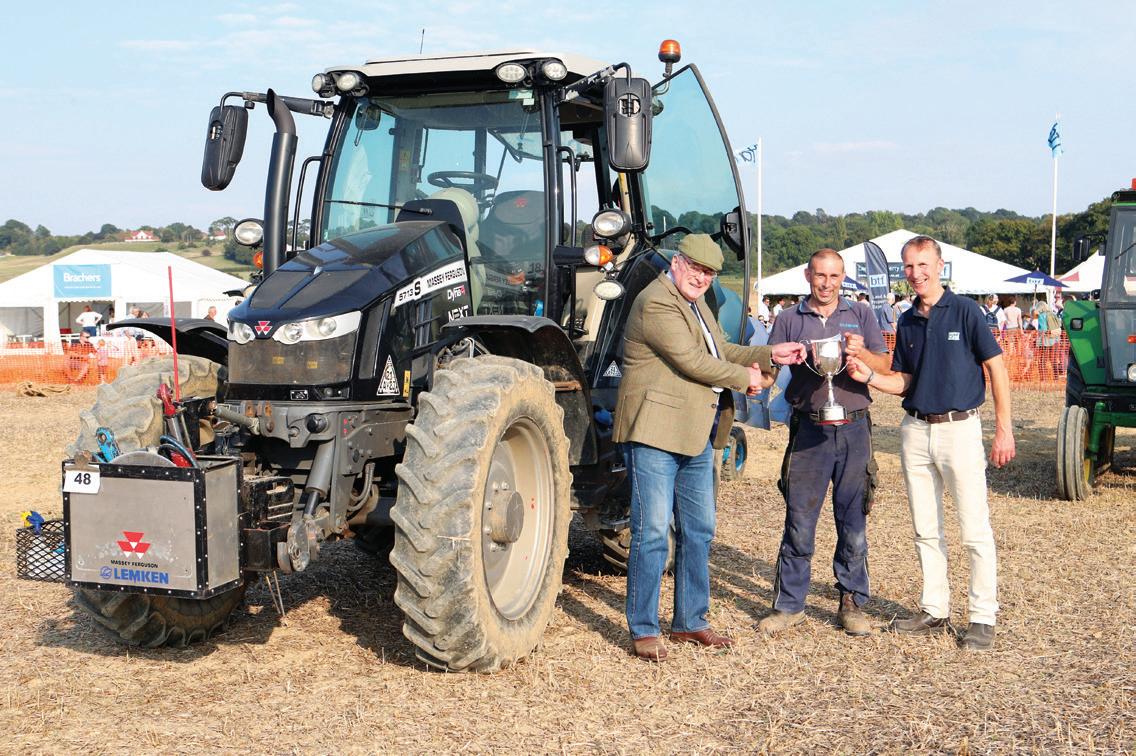





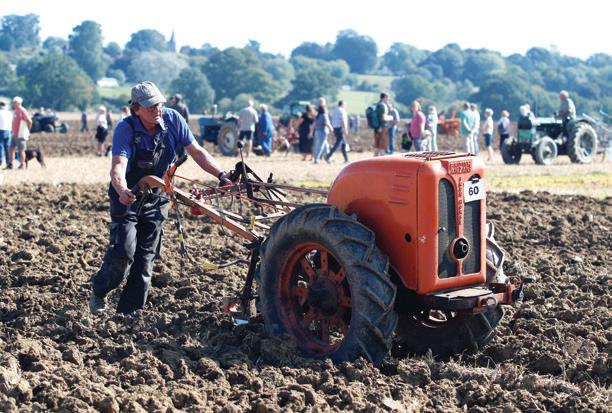





The event was a great match, with 43 ploughman and six hedge cutters taking part across the classes.
The revived domestic section is becoming more popular and it is hoped that next year it will be even better. The weather was glorious sunshine and was one of the best gate turnouts for a match in a number of years. A big thanks to the hosts Mr Brian Foster and family.
New for 2024, The Brian Welfare Final Furrow Trophy presented in memory of the late Brian Welfare for the best final furrow of the day went to Bill Cottington.
• Horses: Ian Williams
• Best Ploughing under 21: Callum Iebba
• Best Novice: John Millam
• Reserve Champion: Philip Corp
• Champion: Jamie Croft
The West Grinstead & District Ploughing and Agricultural Society held its annual ploughing match and show at Westons Farm, Itchingfield, West Sussex, hosted by the Exwood family and Christ’s Hospital Foundation.
Society Secretary Rowan Allan commented: “Despite the challenging mid-morning weather that defied forecasters, the afternoon turned out to be lovely, with a great crowd of visitors able to enjoy this important local rural event.
“The Exwood family and their team, along with numerous committee and other helpers, had prepared a great host site to welcome the thousands of visitors from a wide area of Sussex and adjoining counties.
“There was hopefully something for everyone to enjoy, with over 50 vintage and modern tractor and plough combinations competing, along with teams of horses plus an impressive steam engine display next to the main show ring.”
Overall Champion Ploughman was Ben Marsh with a 1972 Massey Ferguson tractor and Ransomes two-furrow plough, having also been crowned Vintage and Classic Champion Ploughman.
Rowan went on: “Brinsbury College and other local farmers worked hard at preparing their cattle for the show ring, including many calves for the young persons’ handling classes and there were also a number of sheep classes and the ever-popular children’s lamb handling class.


Ben Marsh receiving his prize from the President, Richard Goring. Ben also won the Vintage and Classic classes championship after winning the Classic class with his 1972 Massey Ferguson tractor and Ransomes two-furrow plough


“There was a bumper range of trade stands and exhibits, both large and small, and lots of delicious local produce stalls, plus a colourful range of domestic and children’s classes alongside the field produce entries.
“Harris’ funfair entertained young and old, and the main ring included the livestock show in addition to a falconry display, a tractor parade, a well fought tug-of-war, a parade of the Crawley and Horsham hounds, terrier and ferret racing, a falconry display, a gun dog scurry and a clay pigeon shoot.”
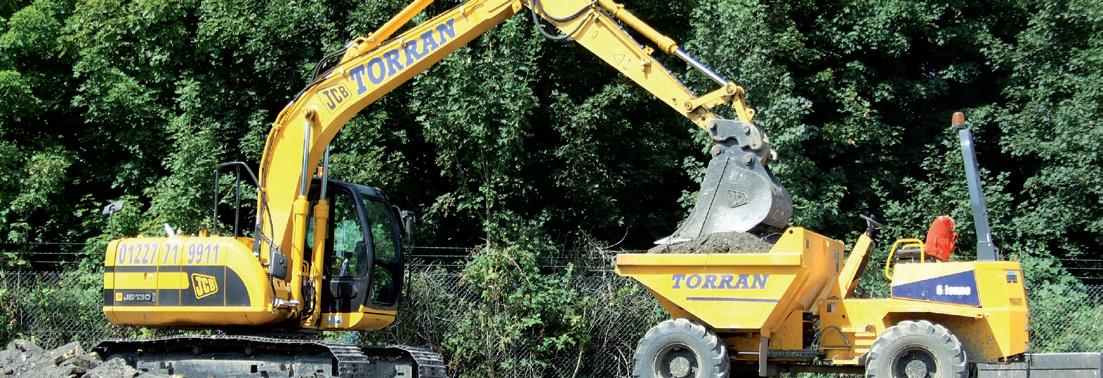
Chairman Tim Martin commented: “Thanks are owed to all of the committee and supporters for their hard work in organising a super site for the match and which, despite a heavy wet spell, turned out good for a great overall day in the end.”
The society, a registered charity, promotes the interests of the local farming community, including holding an extensive range of field competitions through the year. This year’s charity is Horsham Matters, which supports local families experiencing hardship.

Climate change and economic decline certainly isn’t having a detrimental effect on the booming rat population. Controlling these vermin is a pastime that our dogs wholeheartedly embrace. Their enthusiasm for delivering this task knows no bounds. I literally couldn’t believe the devastation they achieved in the 10 minutes maximum it took to drink a cup of tea.
We’d taken delivery of a pallet loaded with beef nuts, 50x 20kg paper sacks with plastic wrap surrounding the outside. I can only assume that a rat ran under this pallet, closely pursued by four dogs intent on catching it. The result was carnage, a mountain of nuts, paper, shredded pallet and plastic; there were only three bags left intact. The dogs were so pleased with themselves – me, less so. It took much shovelling and sorting to put right, to the extent that restoring our spirits required whisky. If anyone has a redundant verminproof bulk bin for sale, I’m interested. We put some of the loose nuts into some plastic dustbins. I was astounded as the rats simply ate a hole through the lid to access the bin. When the bin was nearly empty, however, they couldn’t seem to jump out, which I found intriguing as I’ve witnessed them scale electric
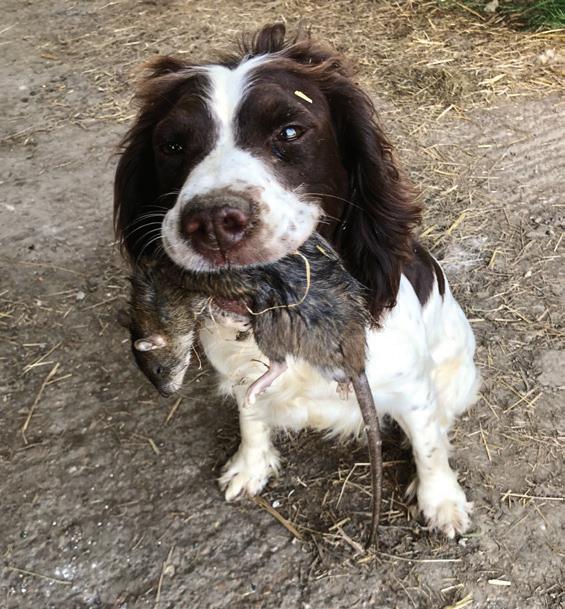
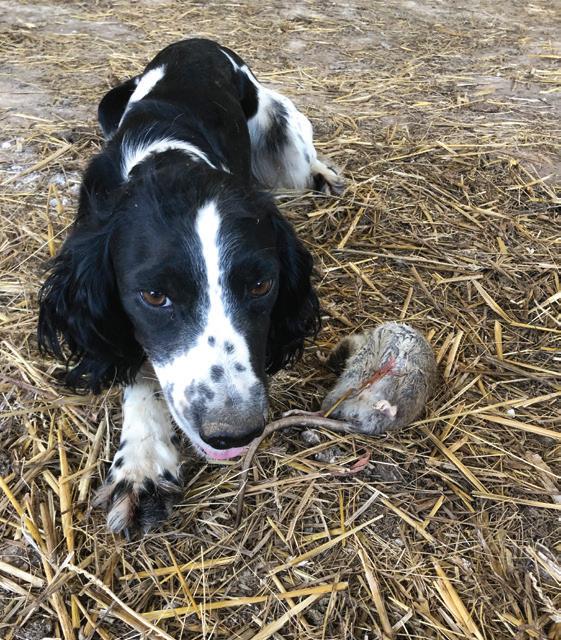
leads and the chain operating the roller doors, climbing to dizzy heights.
These dustbins have proved to be a very efficient way of catching multiple rats, unlike the fancy cage trap I purchased which to date has only once been successful. I’m not a fan of using bait, as I’d worry about unwanted consequences.
Grey squirrels have also flourished this year; destructive creatures damaging trees by stripping bark in woodland and also impacting nesting birds. I was sad to discover a dead fledgling laying on the ground close to a hedge, with beautiful yellow markings on its wings. I took a picture for identification purposes; it turned out to be a goldfinch.
One day we found a white stork strutting among our cattle, but unfortunately it was camera shy. There were several other sightings locally, so I wasn’t imagining it, I believe there were some released at Knepp in early August as part of a white stork project.
We’ve recently encountered two enormous, powerful dogs, unwelcome visitors to the farm. The timing of their arrival couldn’t have been worse. I’d been pleased with my lamb’s growth post-weaning, and faecal egg counts looked good, so I was shocked by how quickly haemonchus worms hit. Initially I thought
the problem was due to moving onto a clover ley, but after checking the eyes for signs of anaemia, I realised my error. I rushed to get appropriate wormer, setting up the sheep handling system nearby, to reduce stress. It was then that we spotted we had company. Thank goodness for WhatsApp, where the community Farmwatch group had reported loose dogs worrying sheep. Another person posted that someone was missing dogs and was out looking for them. We tracked down a number, which went to answerphone. Meanwhile the exhausted-looking dogs lounged in the field with only an electric fence separating them from our sheep. Other half went in search of the owner, leaving me to keep watch; the dogs were pretty edgy about my presence.
Eventually one came up to me and I slipped a piece of string through its collar. It immediately pulled away. Its power was awesome, a precarious situation as I was unsure of the dog’s temperament and yet I needed to protect our lambs. The dogs’ owner later told us they’d escaped from a compound overnight. Their mother had been rescued from abroad (unknown breeding but included Alsatian), they had then mated her to a bloodhound and these two were the offspring.



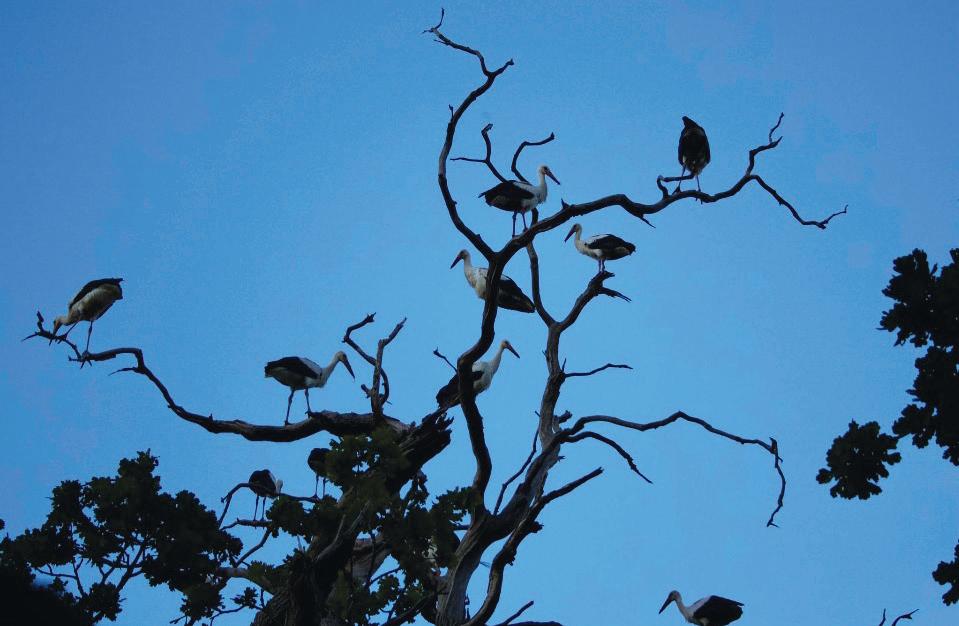

When people move to country locations, they often feel the need to own large guard dogs which, due to their overwhelming strength, they struggle to control. Sadly, it’s often country folk who bear the consequences of these situations. We were lucky; no animal or human was harmed, but it did mean we lost two hours. We finished worming the lambs using the light on my phone.
The trade for sheep in the form of culls, lambs and stores seems to be holding up well, and grass continues to grow; long may it last. Our thoughts turn to preparation for next season’s crop, I’ve started feeding the rams and decided to replace Mr Bump, our Suffolk x Texel ram. I don’t appreciate his bumps and I’d like to improve on his conformation and so we ventured to Romney Marsh and purchased a Beltex x Charolais ram from
Colin Balcomb. Hopefully this ram will at least know what a dyke is and will adapt well to the Pevensey levels.
Colin first showed us around his impressive Romney flock, explaining that the bloodline had been started by his grandfather. Romneys are relatively large, producing a heavy, long-fibre fleece and flavoursome meat. Their characteristics include calm disposition, good mothering skills and tolerance to harsh wet conditions, with a resistance to foot rot and parasites. Romneys have been exported all over the world but right now appear to be less fashionable. I hope they regain their popularity. Due to their mild nature, Romneys make good starters. Grandkids, how about it?
Grandchildren numbers are increasing. Congratulations go to Nigel and Hannah on


Grandsons watching harvester in action
Unwelcome visitors to the farms
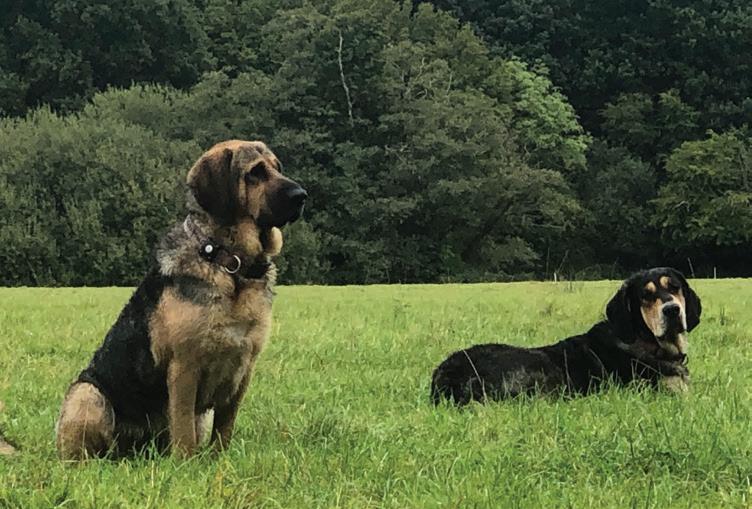
the birth of their son, Wilf August Akehurst, born on 30 August. It’s delightful to enjoy these little ones around, introducing them to farming life and then handing them back into parental care.
I won’t divulge how long it took me to shear one lamb that got shoulder strike when Clik cover ran out. Well done to Ed Gingell for his epic achievement, shearing 775 lambs in a nine-hour run, and to Jake Prodger for shearing 451 lambs in eight hours. Of course, I think you’re both slightly crazy, but anyone who keeps sheep probably falls into this category.
Colder weather is rarely on my wish list; Here’s hoping bluetongue is soon curtailed (this column was written prior to bluetongue restrictions being imposed in Kent and East Sussex).
More and more people in the South East are choosing pedigree Sussex Cattle, the breed that is native to the South East, and for a number of different reasons.
• Great converters of forage that will thrive on poorer quality pasture, making them ideal for conservation, organic and extensive grazing
• Eligible for the DEFRA, breeds at risk, grazing supplement
• Pedigree stock get a higher payment if they are taken out of the herd as TB reactors, making them a good insurance policy for those in high-risk areas
• Easy calving, fertile, long-lived and docile means reduced handling costs, especially relevant to large, mixed farms or small-scale, part-time farmers
• Youngstock finish at weights of 600kg to 630kg on silage and can finish well at 24 months on an extensive system. Saleable meat 60% to 65% of carcass.
• Demand from butchers and consumers for local “Sussex” beef in the South East, especially important for anyone selling through box schemes
• With 90% of breeders based in the South East, there is always a good supply of breeding stock for sale

As more and more herds register for high health status, buyers are less keen to purchase breeding stock from the live auction ring, so earlier this year the society ran its first on-line pedigree breeding sale in conjunction with South East Marts and MartEye.
In March, 23 bulls were entered; five sold for in excess of 5,000 guineas and a top price of 7,200gns was achieved for J & S Harmer’s two year-old bull Offham Poll Crusader 9th, setting a breed record.
Catalogues will be available from South East Marts in February. This will give potential buyers plenty of time to visit farms and inspect stock prior to the sale, and following the success of last year the society expects a good entry of bulls and significantly more females.

Earlier in the year, The Sussex Cattle Society was honoured to announce that following The King’s accession to the throne and a review of his patronages, His Majesty had agreed to continue his patronage and support for our longestablished native breed.
Will Hurley, president of the society, said:
“His Majesty’s decision to honour us with his patronage means the world to all Sussex breeders. For decades he has worked tirelessly to support native breeds and the fact that Windsor has the largest pedigree Sussex herd in the country is a huge source of pride to our society. His Majesty’s patronage is a rare honour in which we take the greatest pride”.
Every year we run a herd competition with classes for small (under 20 cows), medium (20 to 50) and large (over 50) herds. This year’s winners were:
• Small herd:
Jane Howard’s Coopers Herd from Stonegate, East Sussex
• Medium herd:
David Spanton’s Maygate herd from Mayfield, East Sussex
• Large herd:
E H Holdstock’s Elbridge herd from Canterbury, Kent.
Rhys Grenham, from East Sussex, visited all three farms to find his overall winner and commented: “It was a pleasure and a privilege to be asked by the society to judge this championship. Each herd demonstrated the very best characteristics of the breed within its setting, showing the versatility of the Sussex and what they can offer to farmers in different grazing environments.
“David Spanton’s Maygate Herd is my champion. He and his team have established
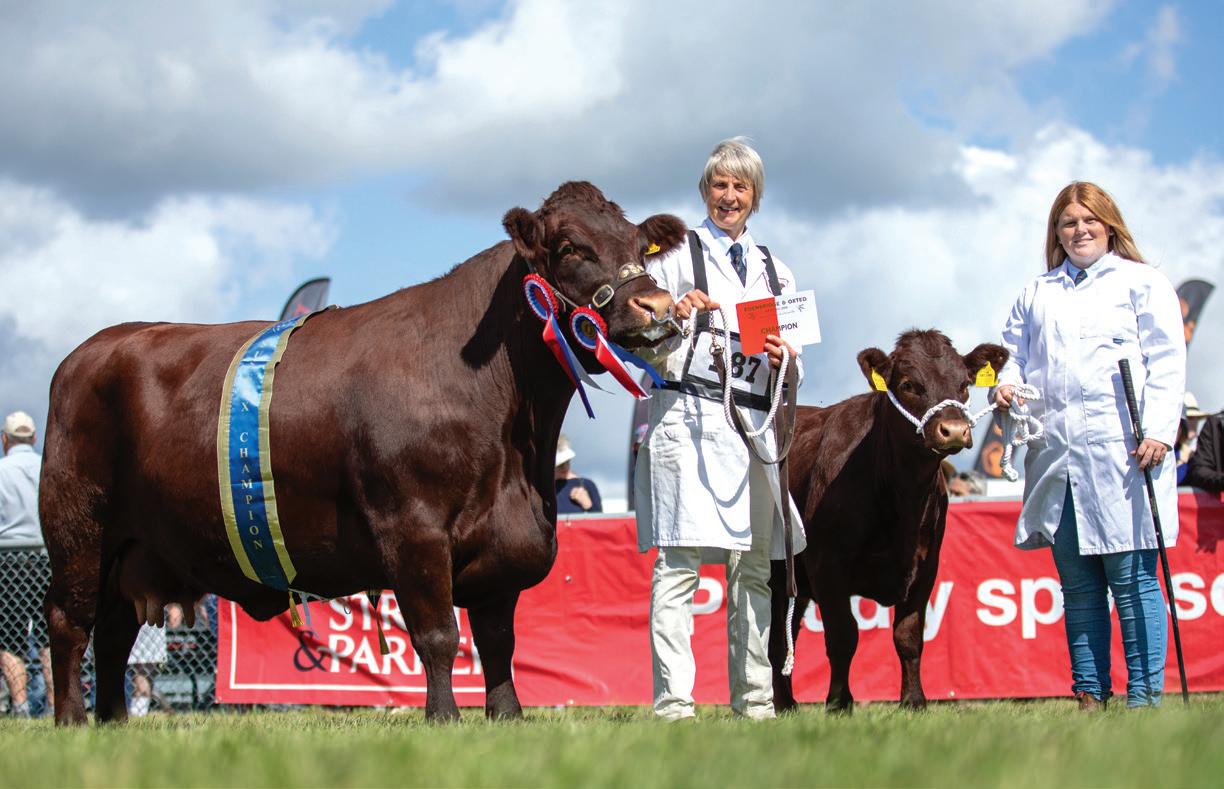
a strong, balanced, correct and consistent type that should make any Sussex breeder very proud.
“I also saw outstanding youngstock that inspire confidence in the next generation not only continuing but further improving the herd.
“My thanks to Jane Howard at Coopers Herd and to James Holdstock at Elbridge Herd for their warm welcome and time. Each of the finalists showed a true dedication to the breed.”
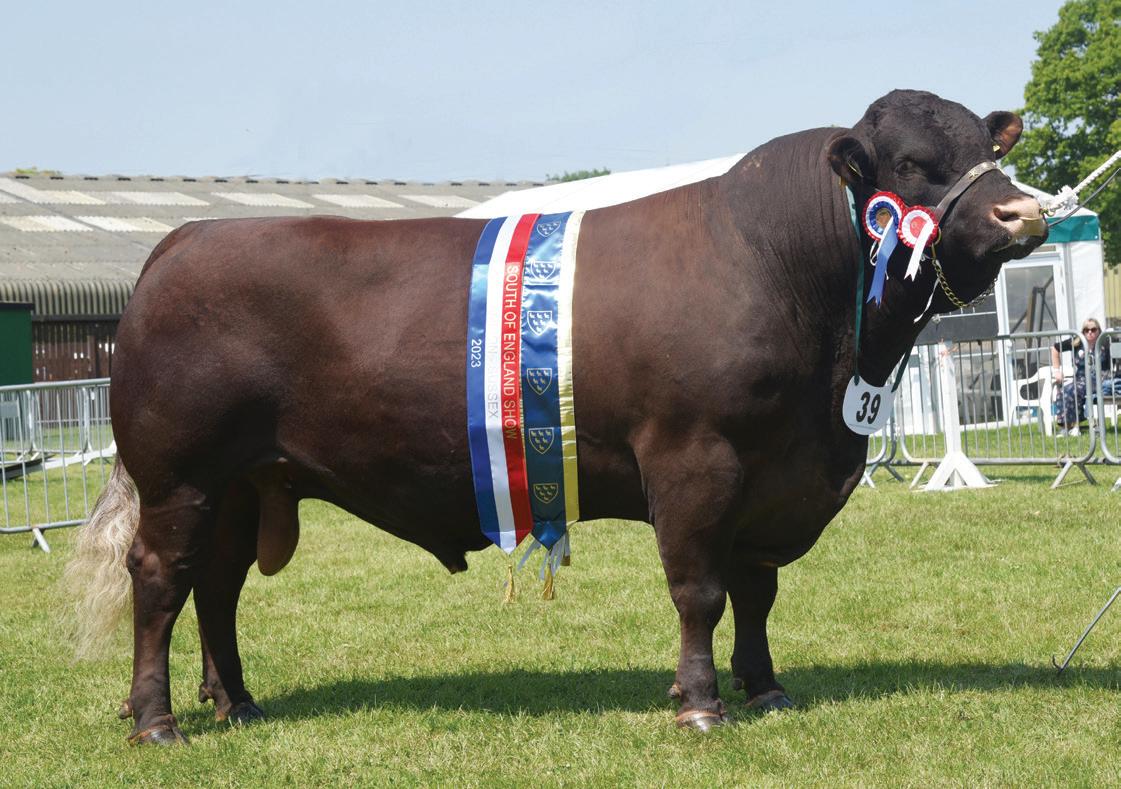
Sussex cattle classes were again held at Heathfield, Suffolk County, South of England, Kent, Royal Norfolk and Edenbridge & Oxted shows, and the society encourages breeders interested in showing to get in touch, as experienced show people are available to help newcomers to showing get started.
Points are awarded at all the shows to find the champion male and female of the year. This year’s winners were Jane Howard’s six year-old bull Coopers Regent 3rd and The Buchanan Family’s seven year-old cow Black Ven Koskimo 80th.
The Sussex Cattle Society runs a NextGen group that meets throughout the year for training workshops and social get-togethers.
It now includes over 20 members, and workshops were held on members’ farms throughout the South East to cover topics such as selecting replacement heifers, show ring etiquette, choosing a bull
and, with Chris Burns from Cliffe Veterinary Group, a session on calving skills.
The group was also pleased to visit Tim Piper’s farm in Kent, where he runs a large Lim/Sussex suckler herd to find out what a commercial farmer is looking for when using Sussex in a cross-bred commercial system.

This month Nigel Akehurst visits Mousehall, a family-run, sustainable distillery and winery nestled in the scenic High Weald National Landscape near Wadhurst to discover how the Jordan family has transformed the historic country estate into an award-winning wine and spirits business.
Turning off Tidebrook lane, I followed a gravel track, passing several pretty houses before encountering a small flock of distinctive, black-headed Dorper rams grazing on a steep field. A beautiful Wealden farmhouse and oast greeted me at the entrance to Mousehall, and taking a right turn I followed the track along the bottom of the vineyard, arriving at the visitors’ car park.
I headed for a large modern barn housing Mousehall’s Distillery and Winery, where I met Christy Jordan and Nick Siersema. Invited in to the impressive, double height space, the first thing I noticed was the shiny, 400-litre copper pot still Amahle (meaning “the beautiful one” in several African languages) taking centre stage.
As we sat down for a chat, Nick fired up their impressive barista machine and brewed us all a proper cup of coffee. I was eager to learn
more about the estate, and Christy explained how her parents, Gary and Kathy Jordan, had bought the 14-acre property at the end of 2017.
With a background in viticulture – they own the Jordan Wine Estate in South Africa – Gary and Kathy had decided they wanted to start a vineyard in the UK. The search was far from straightforward, added Christy, but after being shown many properties by various estate agents they were eventually shown Mousehall. It was neglected and overgrown, but the family fell in love with the historic buildings, and the south-facing slopes were ideal for vines.
Equipped with a chainsaw and brush cutter, the family got to work clearing the grounds in early 2018, simultaneously renovating the historic buildings and preparing the
south-facing field for vine planting. After making drainage improvements in 2019, they contracted in VineWorks to plant vines growing the champagne varietals, Chardonnay, Pinot Noir and Pinot Meunier.
Seeing the vines being planted was impressive, commented Christy, describing how the GPS-guided tractor and machine and two men planted all the vines in a matter of hours.
That same year Christy joined her parents at Mousehall, moving over from South Africa to work on developing the gin business. In 2021 they converted a redundant Atcost barn into what is now their distillery and winery, one of the first such combinations in the UK.
The team now boasts six full-time members of staff, each with their own defined role, though they often overlap during busy times, such as during events and at harvest time, she explained.

• Mixture of historic and modern buildings set within 14-acres.
• South-facing slopes under 100m, mainly clay and sandstone.
• Granted 14 different licences for the distillery and winery, including rectifying, spirit blending, gin and vodka.
• Renovated a redundant Atcost barn in 2021 to a high spec to house a 400L copper pot still and winery, receiving a LEADER rural grant to help cover some of the costs.
• Planted champagne varietals Chardonnay, Pinot Noir and Pinot Meunier in 2019 on half a hectare.
• Small flock of Dorper ewes and rams.
• Offer tours and tasting experiences.
• Luxury accommodation in a renovated oast house which sleeps six
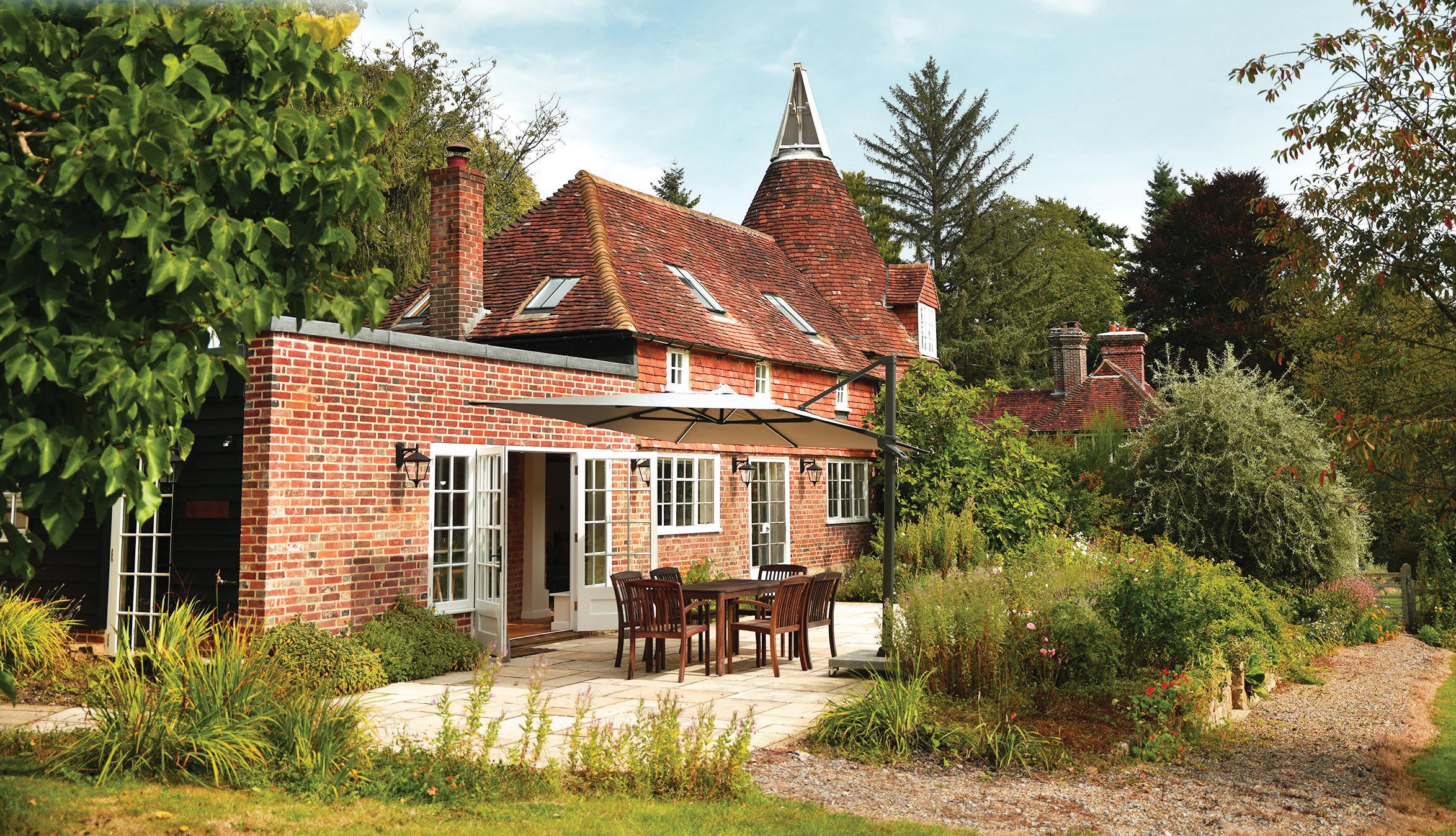
No two days are the same, with Mousehall now offering distillery tours and tastings, private events and functions and luxury accommodation in the oast house. Nick joined Christy at Mousehall earlier this year to head up sales and finance after giving up his IT job in London, and explained that he doesn’t miss looking at a screen all day long.
A lot of work went into getting everything set up, and Christy said they ended up applying for 14 different licences for the business. After carrying out some initial research themselves, they decided to outsource the complex process to APA, run by Alan Powell, who took care of everything.
“Before 2009 it was virtually impossible to start a distilling business, due to rules that meant you couldn’t have a still holding less than 2,000 litres, which is industrial scale,” explained Christy. Thankfully Sipsmith
managed to get a small-scale distillers’ licence and paved the way for the artisan gin boom.
Christy, who has a background in visual arts and worked in hospitality for a number of years, worked closely with her cousin Lindy Wright in South Africa to create the brand identity for Mousehall, incorporating a lot of the medieval history and nature of the estate into their beautiful packaging and website (www.mousehall.com)
With a growing demand for local artisanal gin, it made sense to set up a distillery and winery at the same time, especially as it takes a few years for the vines to grow and establish, she explained.
The family worked closely with local building firm AT Palmer to carry out the barn conversion and Oast renovation (now a luxury holiday let). Covid-19 put a bit of a spanner in the works with building supplies, so the barn was delayed, but they managed to get it completed just in time for the arrival of their Germanmade copper pot still in January 2022.
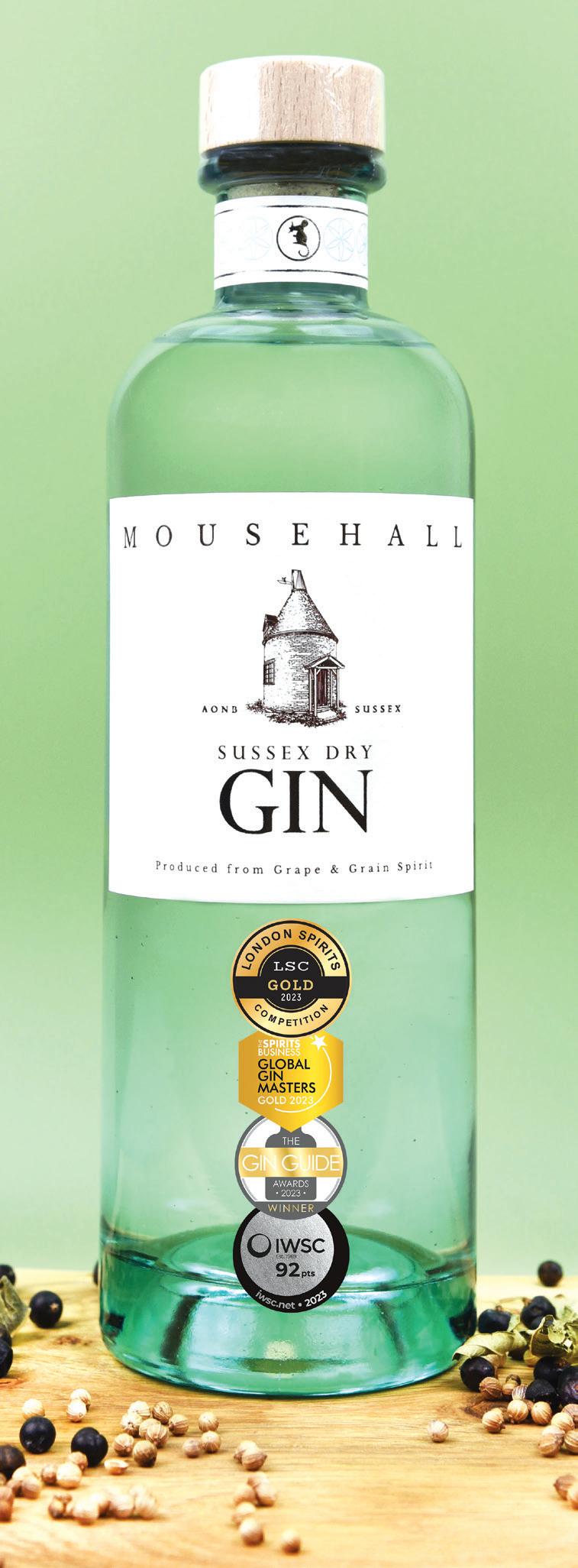
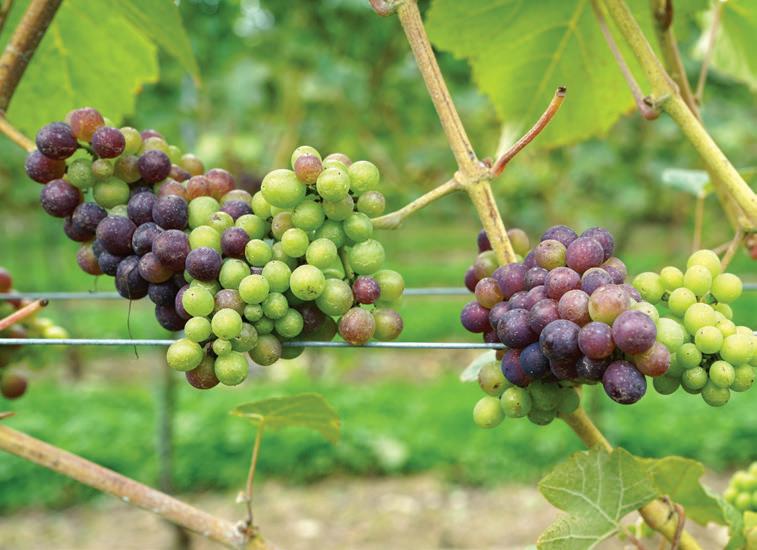
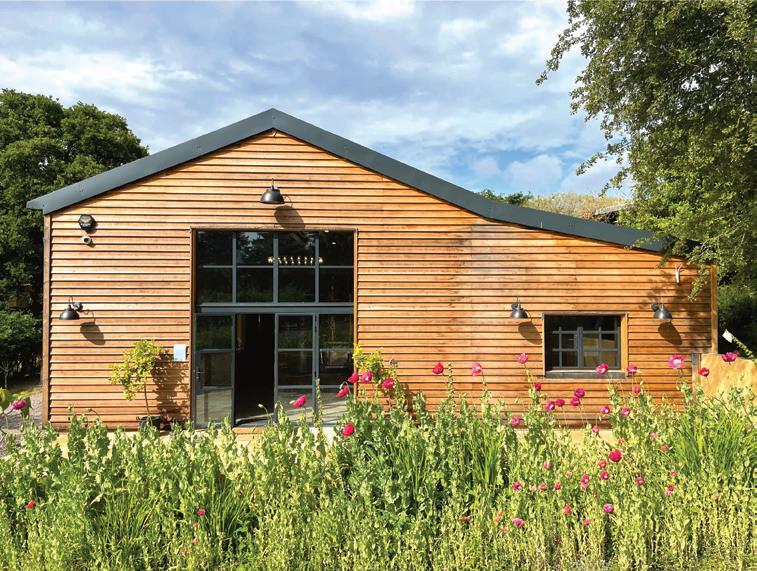
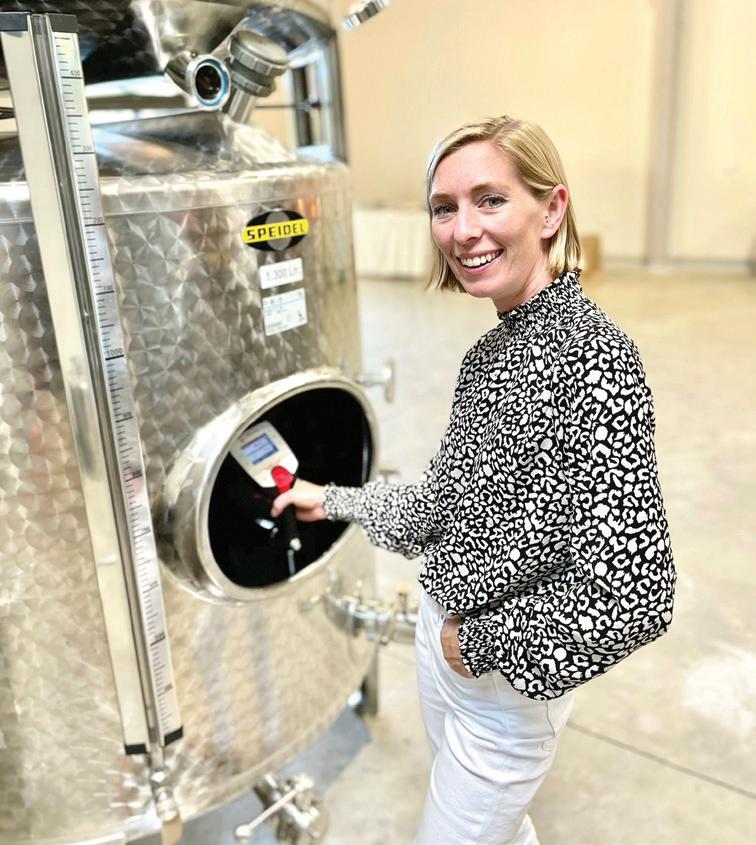

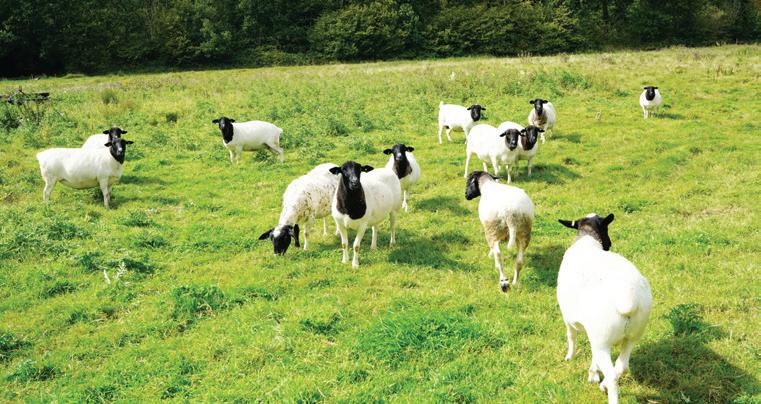


Christy described what she called an unforgettable moment when they travelled to the Black Forest in Germany to watch in awe as their copper still, crafted by fourth-generation coppersmiths and an essential piece of their distilling dreams, came to life.
To make the gin they begin by buying in a 96% neutral spirit from a local supplier as their base alcohol, which is made with a French grape and British grain.
They then add their own mixture of botanicals using a one-shot method. Christy explained they do four distillations to create their Mousehall Sussex Dry Gin and use 13 botanicals in total, including locally grown English coriander seed and Mousehall lavender. They are also growing various botanicals they will be using in their seasonal spirits and vermouth.
It took Christy about a month to perfect the recipe, playing back and forth with the different quantities and then adding an extra botanical here or there to ensure quality and depth of flavour.
“You can be quite creative,” she said, adding that she even tried distilling hay to experiment with different taste profiles (apparently it tastes quite sweet when distilled).
Spending a few months on developing their sustainable packaging, they launched their signature Mousehall Dry Gin in June 2022 to critical acclaim. The team then set its sights on expanding the product line, launching a Triple Distilled Fresh Citrus Vodka in June 2023 and an Elderflower Aperitif earlier this summer.
Showing me around the barn, Christy and Nick explained how they can use their impressive steel tanks for both spirits and wine
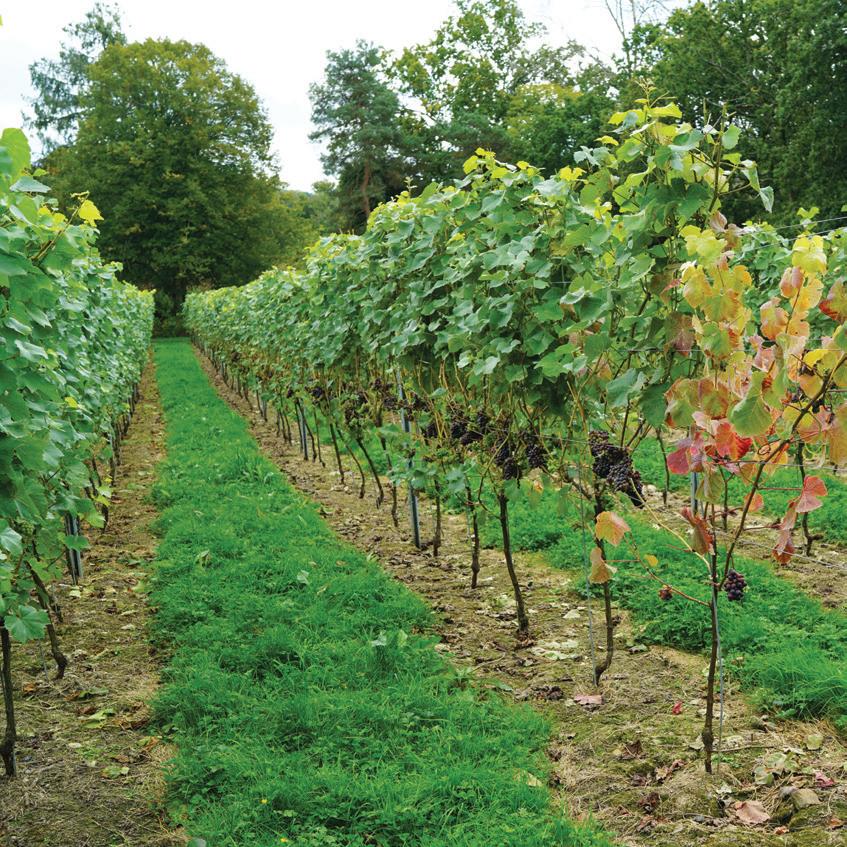
making. They planned to start bottling their first Tidebrook sparkling wine the following week, said Christy.
Finishing our tour inside, we headed out to see the vineyard and grounds. They harvested their first grapes in 2022, explained Christy, making their maiden vintages of their still wines, named Tidebrook, after the hamlet the estate is located in.
Walking through the leafy rows of their picture-perfect vineyard, Christy pointed out the grapes, many of which had yet to ripen. She explained that the mild, wet conditions had made it a tricky year. As a result, she didn’t expect to start harvesting until well into October, even though they had been through and removed leaf cover to speed up ripening. In a good year they would aim to start harvesting at the end of September, she said. Last year they received 40 tonnes of grapes from both their own vineyard and from other Sussex vineyards within a few miles.
I asked Christy what advice she had for other farmers in the South East who were considering diversifying into viticulture. She replied that it was easy to be romantic about starting a vineyard, but it was important to work out if the land was suitable for growing vines first. Ideally you need free-draining, south-facing slopes below 100m, she advised, adding that you may need to factor in deer fencing, especially if the site is located near woodland.
It’s a lot of hard work, she added, so you need to be sure you are passionate about wine, too. Planting vines is a considerable
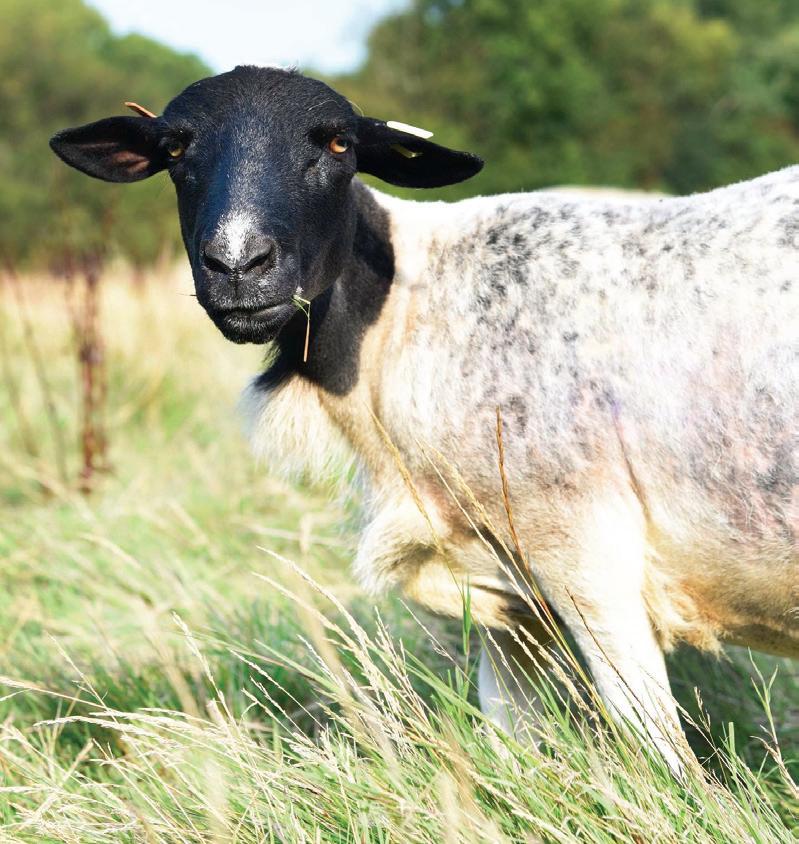
up-front investment, and you also need to factor in the ongoing maintenance. Other factors to think about include how you plan to market the grapes.
Helping keep on top of the grassland management at Mousehall is a small flock of Dorper sheep, which graze under the vines during the winter season. The Dorper is a South African, self-shedding breed created by crossing a Persian ewe with a Dorset Horned ram, explained Christy.
With no prior livestock experience, the family bought in ten ewes and rented a ram. Lambing was quite an ordeal, they said, and after getting off to a good start they faced a number of issues including prolapses and breach lambs. Thankfully Christy discovered a supportive group on Facebook. She described how she sent in photos, receiving invaluable advice around the clock from a community of shepherds.
The flock has since grown in number and Christy knows all the 18 ewes by name, with no plans to do any more lambing at present. She

said that anyone interested in buying pedigree Dorper rams should get in touch.
To capitalise on the growing demand for experiences, the Mousehall team offers distillery and winery tours and tastings which can be booked via the website. Guided tasting experiences cost from £25 per person. They also cater for private groups and regularly host birthdays, other celebrations and work functions.
With a professional kitchen and bar in the barn, they can provide ‘grazing boards’ for groups. One of the most popular experiences is their cocktail masterclasses for groups of 10 or more, added Nick.
With a growing number of vineyards in the High Weald, Mousehall is now part of the Wealden Wine Trail, launched this year to promote 12 vineyards open to the public.
Marketing is a key part of their business


strategy and both Christy and Nick are accomplished marketeers, having built a loyal following on Instagram (@mousehall_country_estate) and racked up nearly 3,000 followers so far.
Their content features everything from product news to updates from the estate, such as the recent addition of their newly renovated luxury oast accommodation that sleeps six. Showing me around, they pointed out the hot tub being installed in the garden ready for their second set of guests due at the weekend.
With my visit drawing to an end, we walked through their extensive grounds, taking in their kitchen garden, gin garden and pear and apple orchards with gem squashes – a South African favourite – growing below.
Leaving Mousehall with a bottle of awardwinning gin and vivid memories of their picturesque estate, I was struck by how the Jordan family and the team have transformed the property into a beacon of sustainable, artisanal craftsmanship – an inspiring example of what passion, dedication and vision can achieve.
FARMING AND ENVIRONMENT FOCUSED JOURNALISM AND DIGITAL CONTENT CREATION
Storytelling through interviews, features, case studies, photography and videos.
For enquiries contact Nigel Akehurst via email on nigel@indiefarmer.com
Instagram @indiefarmer www.indiefarmer.com

My family is lucky to have inherited a small holiday home on the Mannin peninsula in Ireland. A derelict, two-roomed cabin in 1968, it has been gently enlarged and modernised over time. The early years were glorified camping, with no electricity or mains water. We cooked on a turf range, read with paraffin lamps and hand pumped rainwater from a tank.
Over 50 years of regular visits, our family has become part of the local furniture as we have got to know and admire many of the local families, now to the fourth generation, with histories going back centuries. All these families have close association with the land and with the passage of time, power, mains water and the internet have all arrived.
Farming is never a sinecure, but trying to make a living off 50 acres of unforgiving rock and bog, with gorse and bracken often dominating grass, raises the difficulty many notches. And that is the lot of farmers in the far west of Ireland. Connemara is an outstandingly beautiful part of county Galway, but easy farming it is not.
the Shannon. Farming the centre is like that in much of the UK, with an emphasis on dairy and beef, but Connemara is unique and with a long human history.
When the interfering Anglo-Saxon landlords unceremoniously left Connemara following independence, tenants were each granted title to some 50 acres. But such land that was flat and workable was barely sufficient to sustain a family with potatoes and vegetables, let alone cereals. The rough ground provided for a few kine and some sheep. The great potato famine of 1845 to 52 is etched deep in the collective memory. Today it is clear that this terrain, which needs care, cannot provide a reasonable living for a modern family. Significant additional income is essential.
Fortunately there are still sturdy young Irish men and women prepared to take on these challenges for the love of it, and David and Emma O’Reilly, in their early thirties, are great examples, keen to live, work and rear a family in this magical part of the world.

For those unfamiliar with the island of Ireland, it is a bit like a saucer ringed by hills and mountains around the coast with flat, sometimes boggy, lands in the centre and riven by great lochs and rivers like Corrib and

We have known David’s family since his late grandfather, Markey, farmed there. David was born on the farm. Growing up a few miles away in the market town of Clifden, he excelled at rugby and now plays for Connemara. He has yet to hang up his boots and bears the scars of many hard-won matches. He also volunteers

for the local lifeboat service and had, a couple of days before my visit, taken part in a forlorn night recovery of a drowned Inishbofin fisherman. His infectious enthusiasm for life remains undimmed and now, returning to academia, he is about to qualify as a civil engineer, which will provide financial security. Emma hails from inland County Galway and claims some Iberian blood, dating from the Spanish Armada’s wreckage off Ireland’s west coast in the autumn of 1588. She is a district nurse with a very busy practice. Her ready smile, effervescent sense of humour and positivity must give patients great comfort and reassurance. She clearly enjoys challenges and, as if it is not enough having a toddler and new baby, she is studying for the Government's “Green Cert” and, once qualified, will gain access to acreage and environmental grants. The two off-farm careers will enable David and Emma to live in the house David’s parents, John and Mary Margaret, built on the family’s farm and fulfill their dream to rear their children in Mannin.
Being in the EU, Ireland supports farming, so the couple receive area payments and various environmental grants that help them manage the land. With other members of the family also living on the family acres, there are diplomatic niceties to be observed, but they


are looking to take on more land as it becomes available from a changing demography, with fewer farming residents.
More land will allow some expansion of their herd of a dozen crossbred suckler cows and followers. Calves are sold as weanlings either off farm or in the Clifden mart. Winter forage is prohibitively expensive, so keeping store calves over winter is impractical. The cows are out wintered on in-bye land to calve in spring. David and Emma have been using AI, but getting technicians when needed is tricky, so hiring a Limousin bull for a few weeks is the preferred, if risky, option.
The UK’s Brexit has dampened the market for stock, which is volatile, with a price premium for shapely continental crosses. There is now little doubt that Brexit has harmed our own economy and, gratuitously, also Ireland’s. I have yet to see any of the promised benefits and consider the whole exercise to be one of collective madness and serious self-harm, but we are stuck with it.
The calcareous sandy coastal rim in Connemara is known as machair grassland, unique in the world and only found on western coasts of Ireland and Northern Scotland. The habitat has an incredibly rich flora on which stock do very well. Local farmers share commonage rights and receive acreage payments in proportion to their in-bye holding.
For many years the machair suffered from over grazing and severe human holiday pressure during summer, but since Covid-19 the commoners have taken steps to reduce radically this human pressure by excluding tourist vehicle access and removing stock over winter. The result is a transformative resurrection of the machair ecosystem. An area has been successfully predator-fenced to allow lapwings to breed safely, aided by a cull of crows. Conservation is being taken seriously and livestock is an important part of the mix. Machine cutting peat has also been banned to protect valuable bogs.
A measure of success has been the rise in resident choughs, waders and migratory sand martins. The countryside of the whole British Isles needs such care and attention from environmentally aware farmers like David and Emma O’Reilly, for there is little doubt that corporate or industrial farming, focused on maximizing financial returns, will further degrade our fragile ecosystems.


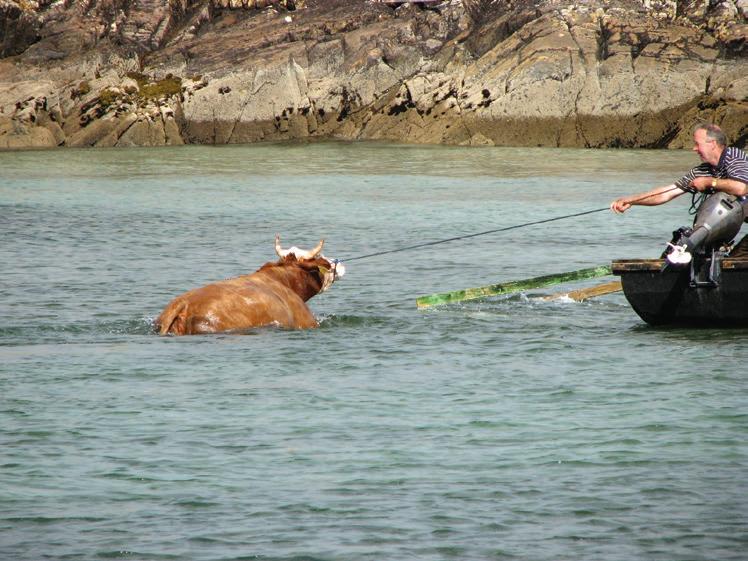
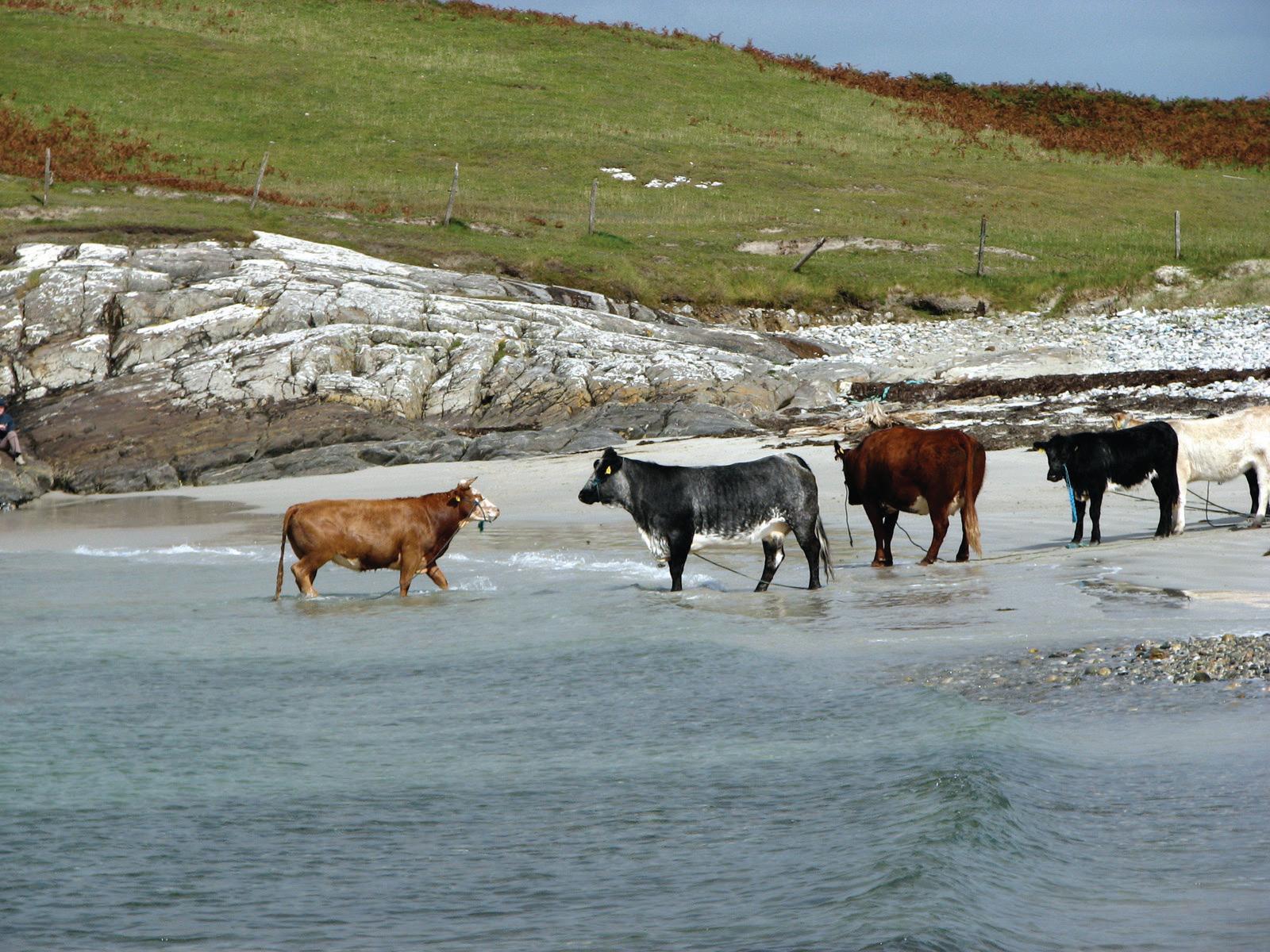

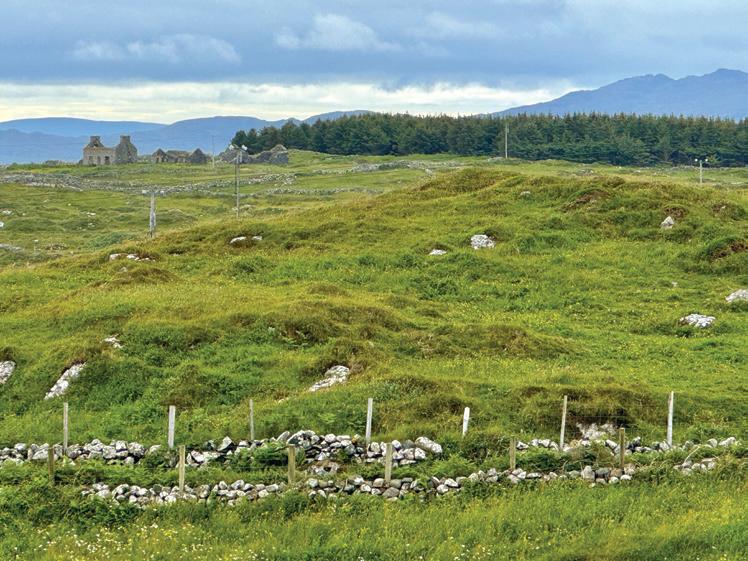
Tickets
at www.nationalfruitshow.org.uk
It may represent a ‘back to basics’ reset, but the man at the helm of this year’s National Fruit Show is determined that it will still showcase the best apples and pears that this country produces.
Nigel Bardsley, whose family has been involved with the Marden Fruit Show Society’s annual set piece event since his father John sat on the committee in the 1960s, is determined that this year’s one-day show will stay true to the original aims of the event and give more growers and dealers the chance to get involved.
prompting a hard look at the way forward.
“I was determined that it should continue, as I have been convinced for many years of the immense value of the National Fruit Show as a shop window for UK apples and pears,” he explained.
find the tastiest.
“We will, though, be displaying the best top fruit this country is so good at growing, and showing supermarkets, consumers and the media just how tasty, nutritious and healthy our apples and pears are,” Nigel stressed.
“We are seeing a shortage of European fruit coming into the country, supermarkets are looking to UK growers to fill their shelves and prices have been slowly rising,” he said. “It’s long overdue, but this year is certainly looking
“People’s time is valuable, and many of the varieties we now grow in this country are still being picked in late October or November, which can make it difficult to attend a two-day show,” explained Nigel, who took over as chairman of the show in April. “So far the response from growers and traders to this year’s planned one-day show has been completely positive.”
Nigel praised the organisers of the 2023 show for what he said was “a great event” and had matched expectation for the landmark 90th show, but said the costs had been high,


“I believe in the show, and I was prepared to do everything I could to make it a great show, but I wanted to bring it back to basics, not just to reduce the costs but to give more growers the opportunity to attend and to make sure we were focusing on the apples and pears that are at its heart.”
The ‘back to basics’ decision means no show dinner, juice or cider competitions this year, and while judges will still be looking for the heaviest apple, they will no longer be trying to
Having sat for many years on the board of British Apples and Pears and, before that, English Apples and Pears, Nigel’s commitment to the industry is clear, and he believes that this year’s show comes at a time when UK fruit is beginning to turn a corner.









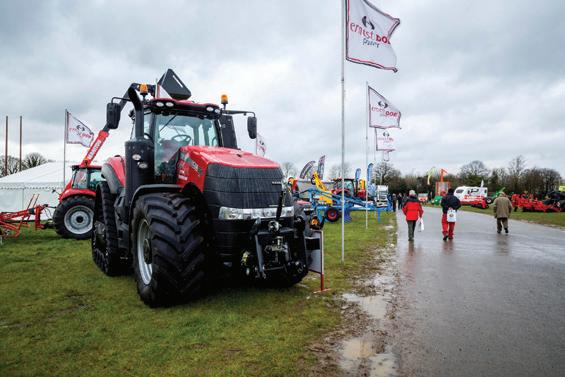

better than last, and I think growers may have a bit more of a smile on their face at the 2024 National Fruit Show.
“With luck they may have a bit more cash to invest in new kit, and that will help the wide range of dealers and other traders who will be at the Kent Event Centre in Detling showing off the latest equipment.”
Reflecting on the number of growers who had left the industry over the past few years, Nigel said he thought those who had “hung in there” through the bad times were “about to reap the rewards”. He added: "The National Fruit Show is there to advertise an industry that I believe will, in five or so years’ time, be as strong as it ever was.”
Nigel himself returned to the family farm, River Farm at Boughton Monchelsea, with wife Annette, in 1984. Working alongside his father John and later his son Ben, he saw the Bardsley England business grow from 120 acres to several thousand, making it one of the biggest in the UK before it was bought by Camellia in June 2021.
Another move to streamline the show has seen more volunteers brought in, cutting costs considerably while benefiting from the enthusiasm and skills on offer across the sector. Eileen Haffenden is back in her former role as show manager, while Nigel’s wife Annette, a familiar face at the show for many years, is vice-chairman and in charge of competition entries.
“After a lifetime of growing fruit and gaining so much from the industry I now have time to give something back, and with the support of many great people I am determined to see the National Fruit Show continue as the shop window of UK apples and pears,” Nigel concluded, adding: “It has to continue because it does such a vital job.”



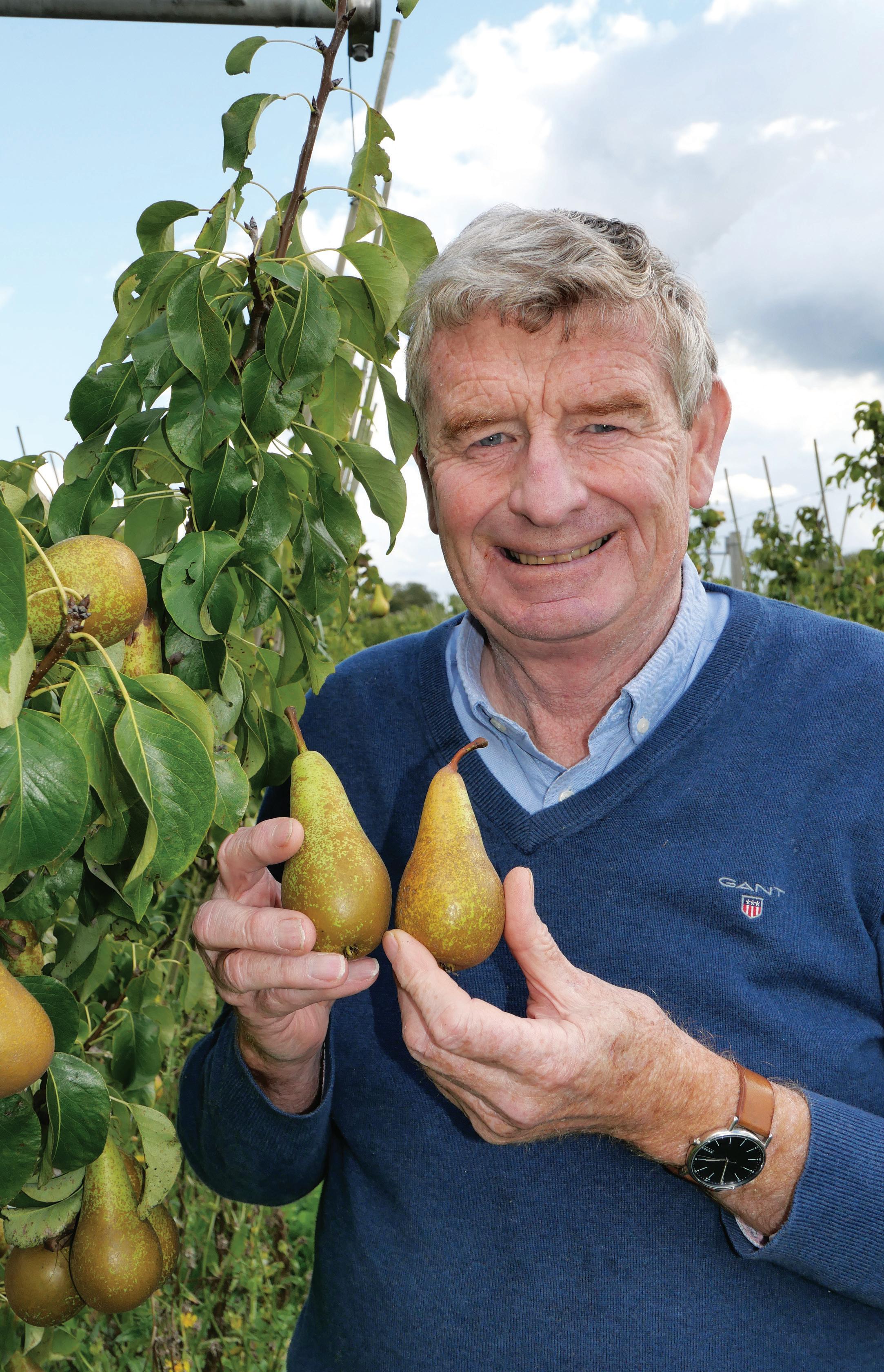
























































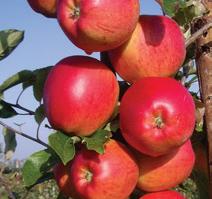

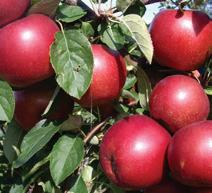
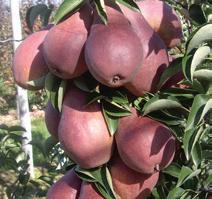











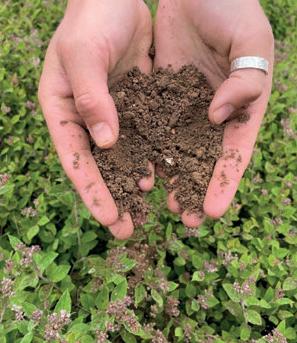







Success set to bloom at Kent’s first Centre of Excellence in greenhouse growing.


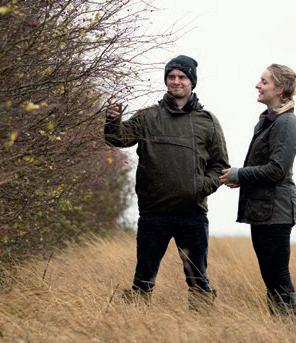








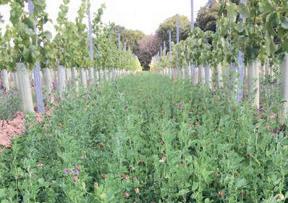








Hadlow College, Kent’s only rural and land-based college, is inspiring the next generation of horticulturists after the UK’s first centre of excellence in greenhouse growing was opened on the site this summer.
The Thanet Earth Centre of Excellence @ Hadlow College is a groundbreaking partnership between the college, leading industry grower Thanet Earth and research and innovation organisation Growing Kent & Medway.





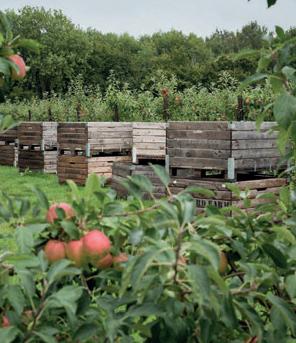



The facility at Hadlow’s state-of-the-art glasshouse allows horticultural students to benefit from working directly with Thanet Earth, the UK’s largest glasshouse salad supplier, to develop their skills and grow tomatoes in a commercial crop environment.





The centre of excellence plays a central part in Hadlow College’s wide range of horticulture courses, with students also benefitting from a ‘concept orchard and vineyard’ which features automated AI management systems, innovative crop diversity and robotic fruit picking.




To find out more about the college’s horticulture courses and see these top-class facilities first hand, come along to the Hadlow College open event on Saturday 9 November, from 10am to 1pm.
To register visit www.hadlow.ac.uk








Targeting the fruit crop with available nutrients exactly when they are needed is fundamental. This means that high-quality fertiliser products are required, linked to crop knowledge and application competence. These two aspects together mean Yara can help to support high productivity for growers with minimal environmental impact.
Yara has developed many tools and services to help share its knowledge concerning optimising yield and quality. In-depth crop Tracey Beilby


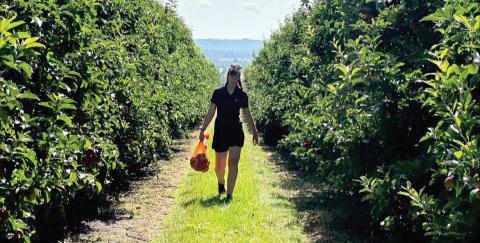
knowledge is fundamental in selecting the right product package and applying the correct amounts as well as understanding the best time to apply for the developing crop.
Our advice for farmers means that fruit yield quality can be maximised without losing nutrients to the soil and therefore impacting the environment. By selecting the correct product at the right time for the crop, YaraTera, YaraLiva, YaraMila and YaraVita products can help growers achieve maximum yield and quality in an environmentally conscious way.






WEB: WWW.STORAGECONTROL.CO.UK For Design and Construction enquiries please contact Jake Taylor on 07864 859390.
EMAIL: UKSALES@STORAGECONTROL.COM
OFFICE: 01892 831702



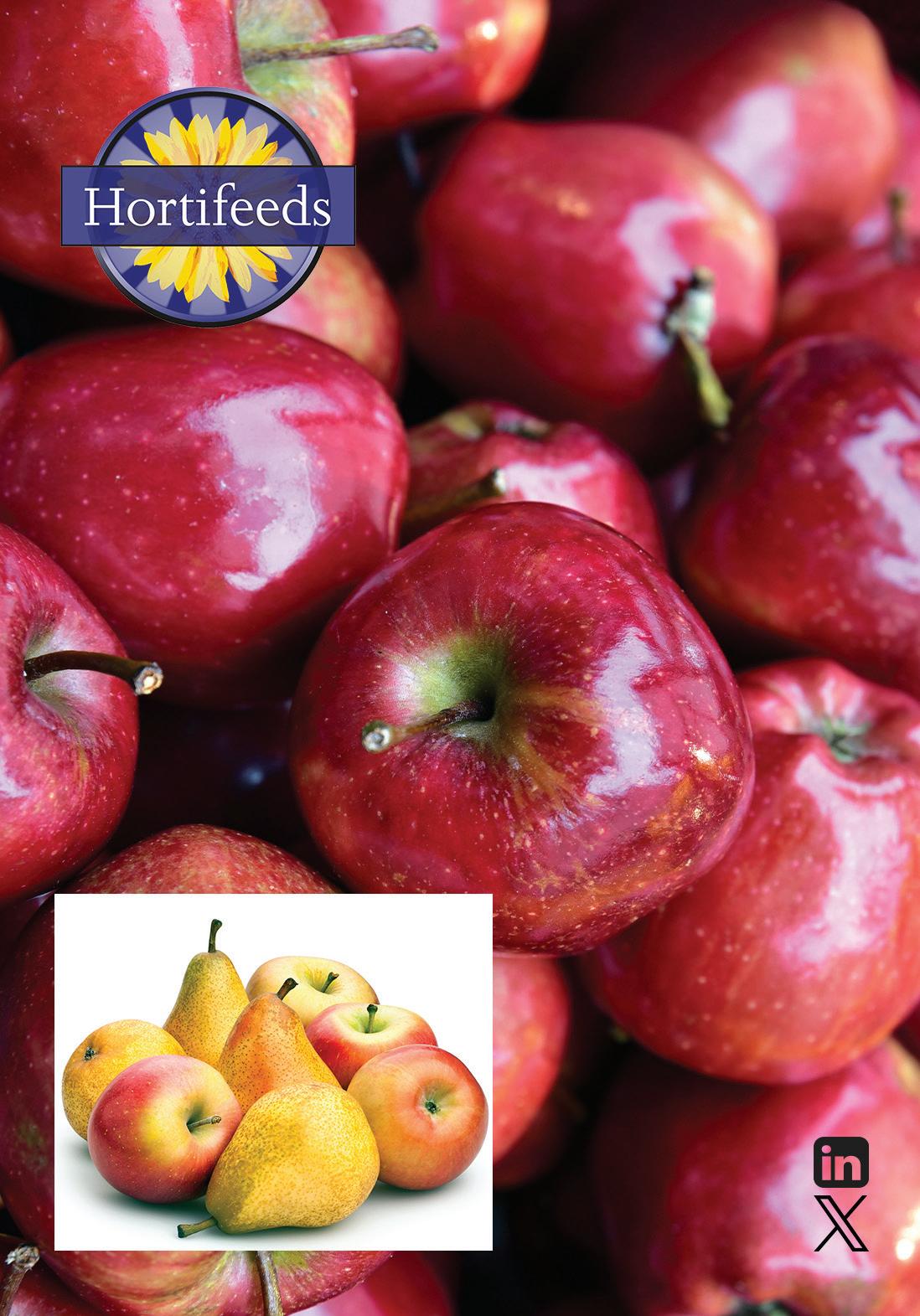



























Agrii is the UK’s leading supplier of agronomy and farm support services, with over 300 BASIS-qualified consultants working with farmers and growers across England, Wales, Scotland and Northern Ireland.
Independent advice is backed by a robust research and development (R&D) programme that trials Agrii’s products and services, giving customers confidence that they are working with a reputable and forwardthinking business.
Agrii is actively preparing for the future of UK fruit production by focusing on sustainability, innovation and technology-driven solutions.
This initiative aligns with government regulations and consumer pressures for more sustainable food production and aims to futureproof farms against climate challenges and market demands.
Agrii's research and development efforts are central to this forward planning. It invests in new crop protection products, advanced integrated pest management (IPM) techniques and precision farming technologies to enhance yields while minimising environmental impacts.
As the gradual withdrawal of plant protection products continues, it is Agrii’s commitment to R&D, working alongside
partner manufacturers and research stations, that will overcome these challenges and maintain a strong armoury of products for fruit-growing customers.
Agrii’s horticultural agronomists are expert advisors with years of experience and have worked with generations of fruit growers across the UK. Collectively, they are best placed to provide market-leading advice while supported by a coordination team that offers unrivalled customer service. With distribution depots from south Devon to east Kent and from Hampshire to Perthshire, Agrii offers UK-wide coverage for speedy and reliable delivery.
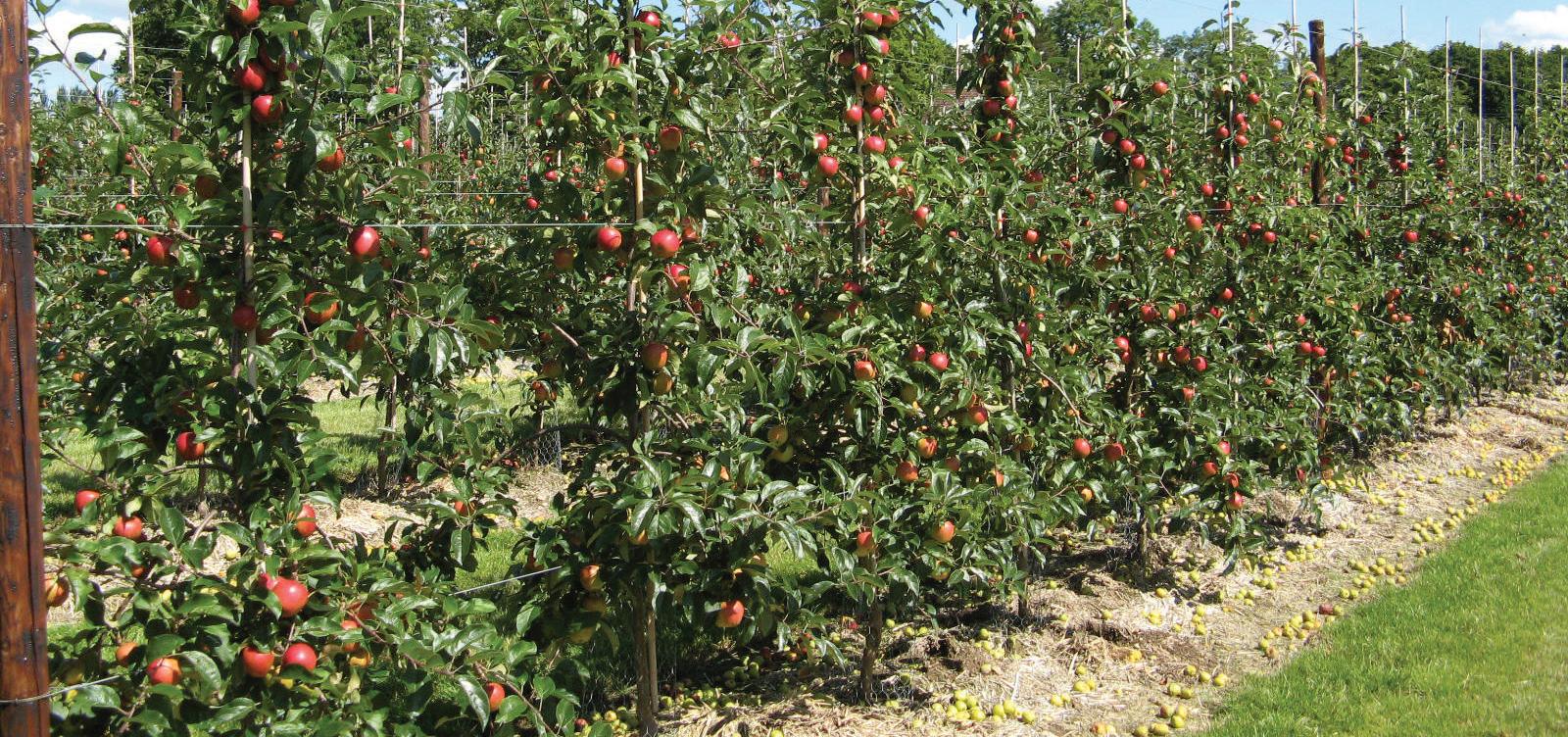
Landseer Ltd specialises in crop protection and horticultural advice, with over 40 years of experience in the fresh produce industry.
The company is known for providing cost-effective solutions, particularly in post-harvest services, and employs a team of industryrecognized experts, including BASIS-certified professionals, FACTS advisors, researchers and qualified crop protection applicators. Key services and products offered by Landseer include acting as marketing agents for Corteva Horticultural Crop Protection products in the UK and actively participating in product trials involving biostimulants. The team also manages AgroFresh Inc. services, such as SmartFresh™ applications, Strella, FreshCloud™ and non-destructive
fruit testing alongside storage consultancy and fruit monitoring, backed by a robust database built over years.
Landseer is also involved in innovative industry technology, such as distributing Trapview automated pest monitoring devices and providing comprehensive monitoring services, including trap maintenance, lure changes and weekly updates. The team is also committed to providing accurate and automated sizing technology tailored to UK-specific needs. It is also involved in developing an early disease detection system using hyperspectral imagery in collaboration with Innovate UK.
For more information, see www.landseerltd.co.uk or visit stand M39 at the National Fruit Show.
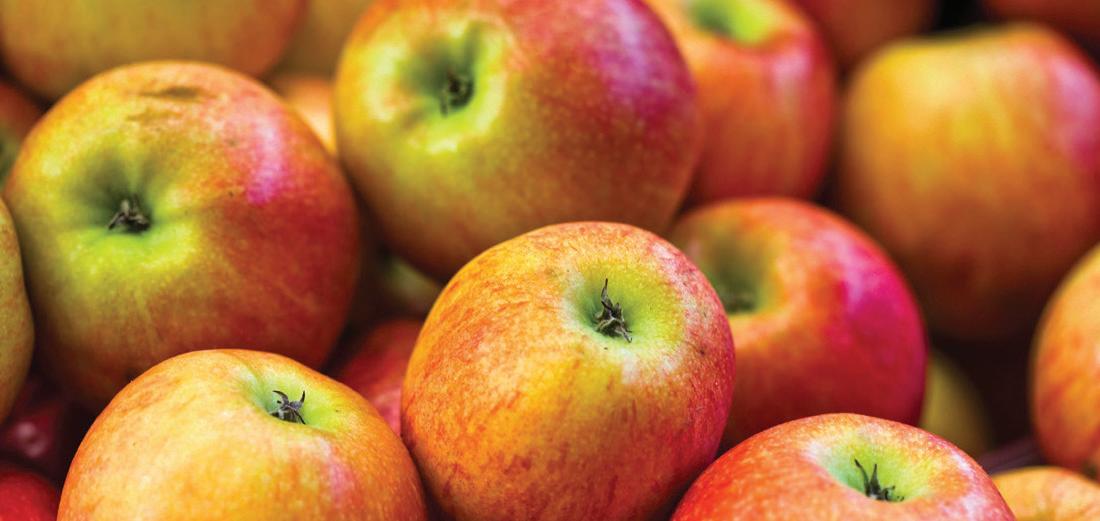

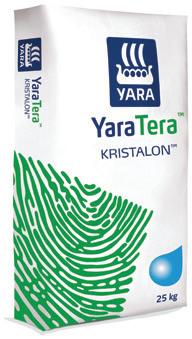


















































































































































































Hortifeeds is excited to welcome visitors to the National Fruit Show on 6 November at the Kent County Showground.
Alongside our team we are pleased to introduce Rob Kempster, lead applications scientist at Plant Impact, who will be available to discuss the benefits of Amētros, the leading calcium mobility product. Amētros has been shown to enhance Class 1 yield and improve fruit firmness across a variety of fruit crops,
making it a valuable addition to any crop fertiliser programme.
Hortifeeds will also be highlighting the advantages of regular applications of our complete biostimulant, HortiBoost. When used in tank mixes with programmed sprays, HortiBoost improves fruit quality and yield while also strengthening plants to resist stress factors such as extreme heat and drought. The ‘little and often’ application method makes it a
cost-effective way to protect crops year-round.
Hortifeeds will also be showcasing its extensive range of fertilisers and biostimulants, including foliar products suited to all fruit crops and growth stages, as well as bespoke soluble fertilisers for both top and soft fruit.
Visit stand M47 to learn how Hortifeeds can help improve your crop fertiliser programme or see www.hortifeeds.co.uk
Jenco Renewables is a trusted partner for sustainable energy solutions in Rye and the surrounding areas. With a strong commitment to environmental responsibility and energy efficiency, Jenco offers expert solar panel installations, helping homeowners and businesses reduce energy costs while lowering their carbon footprint.
The Jenco Renewables team of certified professionals specialises in designing and installing high-performance solar systems tailored to each customer’s specific needs. Whether it’s to power a home, business, or a larger facility, Jenco Renewables ensures a seamless process from consultation to installation, with a focus on long-term energy savings and sustainability.
Why choose Jenco Renewables? They pride themselves on delivering exceptional customer service and using high-quality materials and cutting-edge technology to guarantee every system operates at peak efficiency for years to come. The company’s mission is to understand the unique needs of its clients and it is dedicated to making clean energy accessible and affordable for everyone. Take control of your energy future with Jenco Renewables and enjoy the benefits of solar energy along with lower energy bills, increased property value and a cleaner planet. Contact Jenco Renewables today for a free consultation and join the growing number of home and business owners making the switch to renewable energy.
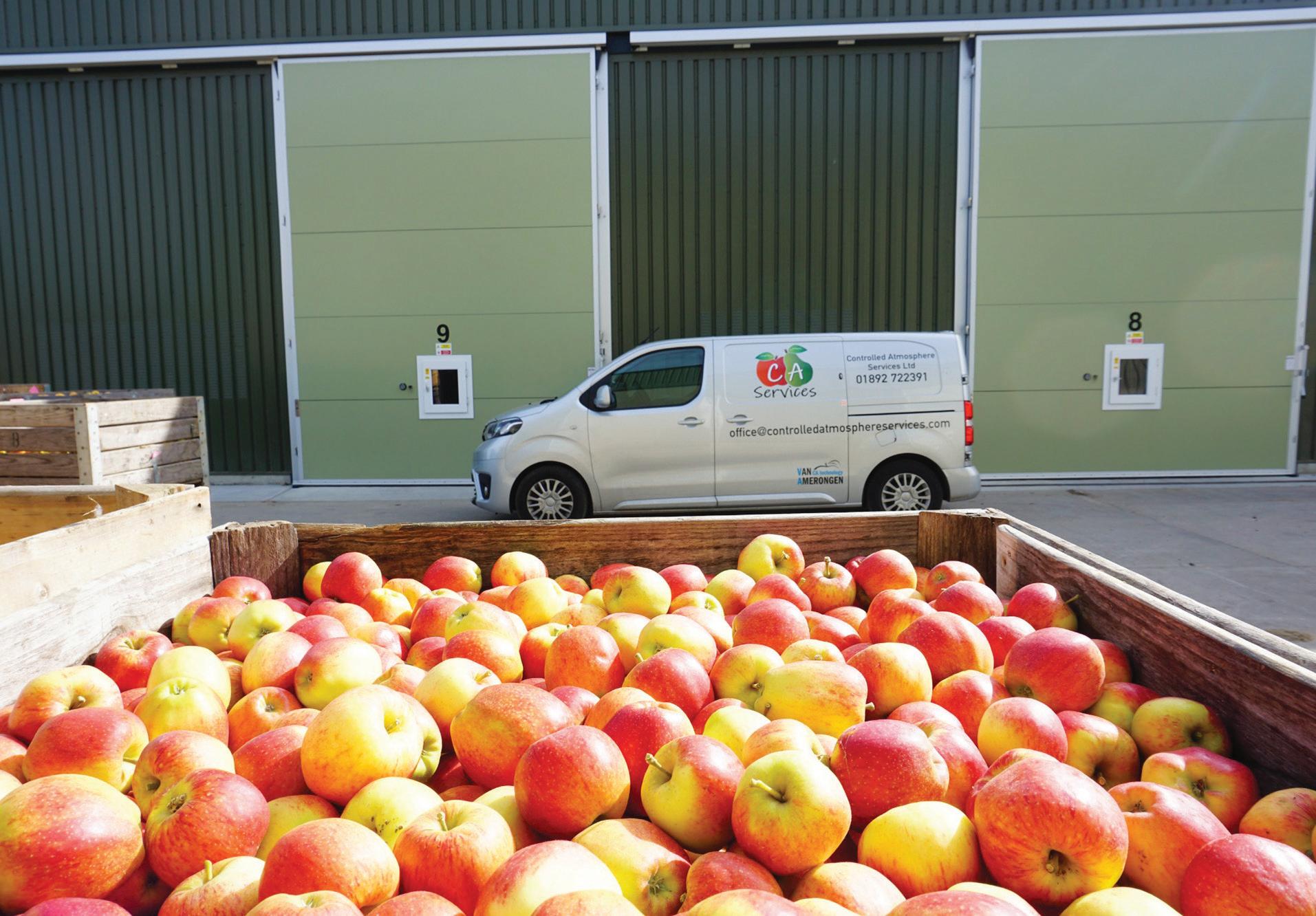
Controlled Atmosphere Services Ltd was established in June 2022 in recognition of a need to continue to support customers, friends and colleagues within the farming and fresh produce industries.
CA Services was started by Trevor Underdown, who was quickly joined by William Underdown and Andrew Cottam.
As a group of like-minded, customer-
orientated engineers with over 50 years of CA experience between them, the threestrong team is driven to give the best service and support to customers.
With that in mind, the company felt it was important to progress quickly into producing its own control systems. CA Services currently has eight of its new scrubber controllers fitted in Van Amerongen

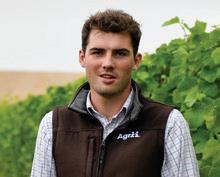




CO2 scrubbers and two new CA control systems fitted as part of new installations undertaken by the company this year. Both can be viewed on stand M71 at the National Fruit Show.
The systems were designed, developed and built in house and with bespoke systems programmed by Derek Wilson, CA Services’ programmer and controls expert.




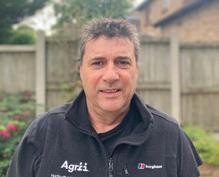

The upcoming budget on 30 October has rapidly become one of the most discussed and dreaded in recent memory. Speculation has been rife amongst commentators as to the exact measures to be announced and the writer has noted many clients already acting to pre-empt the most commonly expected changes –notably anticipated rises in the rates of Capital Gains Tax (CGT).
It is not the intention of this writer to join in that speculation, but by the Government’s own admission there are likely to be measures which are painful, both from a tax perspective and in respect of cuts to public spending. Some of those anticipated changes may affect us all, but the farming community will be paying particular attention to the possibility of changes to two reliefs which have helped to shield their assets from inheritance tax (IHT) over the years.
Firstly, agricultural property relief (APR) provides relief from IHT in respect of agricultural property, which is broadly defined by the legislation as:
1. Agricultural land or pasture
2. Woodland and any building used in connection with the intensive rearing of
livestock or fish if the woodland or building is occupied with agricultural land or pasture and the occupation is ancillary to that of the agricultural land or pasture
3. Such cottages, farm buildings and farmhouses, together with the land occupied with them, as are of a character appropriate to the property.
Relief will be available at 100% or 50%, depending on exactly how such assets are held, and readers may be aware that there are nuanced questions around such matters as the meaning of “character appropriate”. These questions and others are beyond the scope of this article.
Where APR is not available on any particular asset it may be possible to make a claim for business property relief (BPR). This has become particularly important over recent years as farming businesses have become increasingly diversified and where some of the overall business may no longer be strictly ‘agricultural’ in nature.
Farmers will wish to pay close attention to the budget to see if either of the aforementioned reliefs are subject to change.
In that event, the tax and estate planning team at Whitehead Monckton
will be communicating with their clients to explain any such changes and suggest any corresponding actions that may need to be considered. If you are not a client, then please check our website and social media for any updates or contact a member of the team.


The end of the season is upon us, with harvest currently underway or complete. Looking back on this year, a running theme has been variability, whether referring to fruit set, weather conditions or disease pressure.
Weather reports in the UK recorded below average mean temperatures and rainfall alongside a below average number of sunlight hours. Storm Boris wreaked havoc across central and eastern Europe, with torrential rain and widespread flooding, while globally, August experienced the highest temperature on record, marking the 15th consecutive month of record high global temperatures.
In this climate change focused series of articles, I will seek to explore the impacts for UK crop growers and some of the ways in which their businesses can evolve and prosper. I will start by looking at soil.
Using grapes as an example crop, in several wine-growing regions across Europe the average harvest period for grapes is approximately 14 days earlier than it was 50 years ago. Milder winters, warmer springs and hotter summers speed up the phenological development of fruiting crops, with one notable risk being damage from late frost events.
Extreme weather events, which commonly involve heavy precipitation, hail and droughts, are becoming more frequent. These events impact our soils through drying out, crusting, sealing and erosion. In times of heavy rain, the soil cannot absorb excess water, which leads to runoff, flooding and erosion damage. Uncovered, parched soils are particularly affected.
Soil is the basis of fruiting crop production, being the nutrient supplier, water reservoir, buffer for diverse ingredients, habitat for soil organisms and carbon reservoir. Its role in carbon sequestration is that plants extract carbon dioxide from the air and store the carbon in biomass. This carbon can be stored in the soil via microbial decomposition from prunings, leaf litter, compost etc.
We aim to promote soil structure and fertility to improve crop protection against climate-related stresses while maximising the soil’s carbon absorption capacity.

Horticultural Agronomist at Hutchinsons, SFI Specialist and BASIS qualified
There are a number of existing practices employed to preserve soil:
• Reduced tillage – preserves soil structure and reduces erosion
• Cover cropping– increases organic matter, improves biodiversity and reduces erosion
• Mulching – improves organic matter, reduces evaporation and improves water retention during dry periods
• Wider row spacing for trellised crops –reduces water stress
• Irrigation management – aids soil moisture levels for crops during dry periods and reduces runoff
• Nutrient management – provides optimal nutrients for crops, mitigates runoff and protects water bodies
• Monitoring – of organic matter, moisture levels and nutrient content.
Currently, when an orchard or vineyard comes to the end of its life the crop is grubbed and burnt, which subsequently releases the carbon dioxide it has absorbed over its lifetime. It is reported that burning trees generates more carbon dioxide than burning fossil fuels. Hutchinson’s, alongside several other partners including the University of Edinburgh and British Apples and Pears Ltd, are
investigating an alternative known as biochar. In the biochar process, plants are grubbed and turned into a solid biomass product using pyrolysis; the heating of organic material in the absence of oxygen. The majority of carbon remains in the solid product, along with the minerals and nutrients. The nutrientrich biochar can then be returned to the soil, improving soil fertility, crop nutrition and carbon capture.
There is a plethora of reasons to protect our soils, not only for climate-related reasons but also to preserve the unique character of crops. Notably in the wine industry, soil types contribute to the unique terroir of wine regions and influence the character of wines produced in those areas. Chalky soils provide the perfect base for Champagne in parts of the Loire Valley and the south of England, with sandy soils found in regions like the Barossa Valley in Australia and parts of California. My hope is that this strengthens the argument and demand to protect our natural resource.
To scan your soil for carbon, organic matter and nutrient levels, speak to your local Hutchinsons agronomist. Our digital farming platform Omnia uses its soil carbon tool to map, measure and monitor carbon alongside its carbon dioxide emissions calculator.









SARAH CALCUTT ARAGS Chair Fruiterers Awards Council
It’s harvest, mid-September and therefore 23rd British Food Fortnight. The campaign began this year on 20 September and was launched in partnership with the New Covent Garden team.
British Food Fortnight was created to highlight and celebrate the work of British growers of fresh fruit and vegetables. With ‘The Garden’ celebrating the 50th anniversary of moving to Nine Elms, it is appropriate that the launch event, accompanied by the Harvest Torch, was staged in the Food Exchange.
The launch was designed to bring growers together with wholesalers and catering distributors, industry and government representatives and the media, with a common goal of showing support for British growers and the annual two-week showcase for domestically produced food and drink.
The launch breakfast was made with produce from Buyers' Walk and cooked by Westminster Kingsway College students; as long-standing partners of the market tenants, the students are familiar with the fabulous range available on the market.
As well as sourcing all its fresh produce through the market, the college also receives two products a month free of charge, one homegrown and one imported, to help increase the depth of ingredient knowledge for each student.
The market’s wholesale traders work with a number of select growers from Great Britain and around the world to supply most of the leading caterers, hotels and chefs in the south of England. From Michelin-starred restaurants to family-run cafés, His Majesty’s Prisons to the Royal Households and from market stalls to secondary wholesalers, schools and hospitals the customer base is impressive.
For those who have not been to the market recently, it would be worth catching up with the wholesalers, many of them now in their new units.
The new, temperature-controlled Buyer’s Walk is open and looks fabulous, showing the best of British produce on the wonderful ‘shows’ at the front of units. The market is still a hive of activity in trading hours, as it
has been since medieval times, the variety of produce is always astounding and, as ever, the banter rings out as the porters weave through the customers, collecting for orders and delivering to colleagues. It always has a great atmosphere, it smells fantastic and there are always some great displays.
The development is progressing, with the building works scheduled to finish in 2027. Despite the issues of the past five years, the site looks fantastic and it’s possible to see the shape of the final market, which is providing a world class facility for our tenants. I am certain someone wrote in similar terms 50 years ago when the original buildings were
unveiled, but it's great to see how businesses have adapted and grown into their new facilities.
The Harvest Torch will be at the Food Exchange until 4 October, when it will be moved, by the City Harvest team, to Southwark Cathedral ready for the National Harvest Festival Service on 6 October.
City Harvest, which is celebrating its first decade of making a difference, New Covent Garden Market, celebrating 50 years of feeding the capital from Nine Elms, and the British Food Fortnight team have together delivered a wonderful celebration of home grown produce.

By NFU East Sussex Chair Martin Hole.
Our flock club recently met on top of the South Downs at Blackcap Farm to hear about Australian sheep farming from John Keillor.
Using extensive systems of measurement, he has successfully bred and improved the Coopworth breed of sheep, used throughout the greener bits of his country to produce fat lambs.
Encouraged by our vet, I asked him about dung beetles. They have around 400 species down there, but none that could eat the poo of cattle and sheep. Years of pasture fouling and epidemic fly population explosions led to the import of three or four species capable of this important function, and in recent decades these unpleasant plagues have been reduced to the extent that John reckoned he “no longer needed the corks on his hat”, to keep pesky flies out of his eyes.
I became friends with John 40 years ago while working on farm for a summer with him when we were both feckless youths in our early twenties. I know him affectionately as “Mulga”, and he calls me “Pot”. Over a beer later that evening we chatted about what was happening on English farms, particularly with our loss of wildlife.
Here in East Sussex, I am part of a cluster group in which I work with many other NFU members to support wildlife on the Pevensey Marshes. This is one of the most important sites in Sussex for nesting lapwing and is also a key site for as many as 200 species of birds on migration routes.
It is home to many nationally rare invertebrates and the fen raft spider and is regarded as the best site in Britain for freshwater mollusc fauna, including the endangered shining ram’s-horn snail. We work closely with conservation bodies and meet regularly to share ideas about environmentally friendly farming methods in our efforts to support this wildlife.
British farmers take their role as chief deliverers of future nature recovery seriously and cluster groups like this are growing in popularity across the country.
I asked John what the bird populations on his farm were doing. He is a man who has made his fortune from endless careful weighing and numerical assessment and is very knowledgeable about his native species. My question disconcerted him. “I’ve got to have a proper answer to that question,” he said. “I will attend to it when I get home.”
We have a great knowledge in this country through citizen science, marshalled particularly by The British Trust for Ornithology (BTO), of nesting, migrant and wintering bird populations. A community of counters and recorders up and down the country, with whom it is useful to engage, give accurate data to aid conservation efforts.
Most farms fall into counting areas of one sort or another, so we can usually answer the question I asked of John. I told him of the plight of chaffinches and lapwing, he returned with stories of emus and koala bears. As he got to grips with our agri-environment schemes and the, as yet, insufficient take up, he asked me to explain “the hook”. In effect he was asking how to get farmers to relinquish control of their
independence through crop and animal husbandry and replace it with a dependency on politics and the civil service. My turn to grapple with a question.
I have recently read a number of books with the word “last” in the title. The Last of the Great Giants (elephants), The Last Lions, The Last Rhinos, The Last Sunset in the West (Orcas), The Last of its Kind (the discovery of the extinction of the great auk). I’ll add to the list Orison for a Curlew, a sad journey into the fruitless searches for the last of the slender billed curlews, in which the author actually tracked down a Greek ornithologist taxi driver who had a recording of the bird’s call on his ring-tone.
From this gloomy study I suggested to John that maybe extinction is a “hook”. The jury is out.
You may wonder why John is nick-named “Mulga”. He can recite (from memory) Banjo Patterson’s famous poem about a cowboy who sells his horse and replaces it with a bicycle. In the poem the error of the decision is graphically recounted, the bicycle running out of control down a mountainside.
“…then as Mulga Bill let out one last despairing shriek
It made a leap of twenty feet into the Dead Man’s creek.”
John has long been amused about Mulga Bill’s mistake, the “hook” of mechanisation clearly the object of satire in this amusing tale. We still ponder the decision.


Writing this piece in mid-September feels a little like pre-empting the starting gun on autumn cereal sowing, but hopefully the temptation to drill wheat too early has been resisted, with most crops looking to be sown between early and mid October. With the global weather shifting from an El Niño- to a La Niña-driven pattern, let’s hope we end up with less extreme rainfall over the next few months.
Growers fell very much into two camps with regards to winter oil seed rape sowings this year, with a proportion sown around mid August and the remainder between early and mid September. August-sown crops are now typically at six to eight-plus leaves, and September-sown crops are generally around one to three true leaves.
Cabbage stem flea beetle numbers seem to be relatively low, with little notable damage in most crops, but slugs have proved particularly problematic in many areas, requiring several applications of ferric phosphate-based pellets to minimise damage and/or plant losses. If not already dealt with, controlling volunteer cereals is a priority to avoid negative competition with establishing oil seed rape seedlings. Where blackgrass control is also required, be aware of new guidance for using Centurion Max in winter rape, with the latest crop stage now six true leaves. Most Augustsown crops are likely to be beyond this now, and as it can’t be used until the four true leaf
stage, this leaves a limited application window. After the early September rains, stubbles generally greened up well to enable timely spraying-off with glyphosate to control cereal volunteers and grassweeds ahead of sowing the next cereal crop.
At least a two to three week interval is needed after spraying off cereal stubbles ahead of a subsequent winter cereal to minimise the risk of frit fly damage and the direct transfer of BYDV from any aphids present on volunteer cereals.
Following non-cereal break crops, stubbles should be sprayed off five to seven days before drilling. Remember that there is now a growing and very real threat of grassweed insensitivity or resistance for glyphosate, so minimum rates should be maintained at around 1,000gm/ha or above for mixed populations of blackgrass, volunteer cereals, brome etc, but for ryegrass nearer 1,500 gm/ha would be advisable. With particular reference to ryegrass, check for any surviving plants after spraying.
In terms of herbicide strategies for the mainstream cereals, the number one priority for any crop is to ensure an appropriately targeted pre-emergence herbicide is applied, ideally within 48 hours of drilling, otherwise poor grassweed control is more than likely, as witnessed in the past two autumns.
Depending on the known grassweed pressures, the key actives that should be considered within a residual programme are
Cinmethylin (winter wheat only), Aclonifen, Flufenacet, Triallate and Prosulfocarb; the first two would now be regarded as almost essential components of any successful residual ryegrass and blackgrass herbicide programme, but not necessarily together. Bear in mind that both Aclonifen and Triallate should only be applied before the crop emerges. Be wary of overloading the pre-emergence stack as there is an elevated risk of significant crop damage where applications are followed by heavy rain within a few days of application, resulting in crop thinning and reduced yield. Splitting out the components and deploying them within both a pre- and a peri-emergence programme will help minimise the risk of significant damage and also extend the residual persistence through November to optimise grassweed control.
Slugs are likely to be a major headache in autumn-sown cereals, but as ever the risk can be significantly reduced by deploying pre-drilling cultivations to drying soils, drilling 30mm to 50mm deep and rolling post sowing, followed by regular in-field monitoring.
For most fields following winter oil seed rape, winter beans, cover crops and second cereals, a precautionary application of ferric phosphate-based slug pellets shortly after drilling is likely to prove a prudent strategy and perhaps essential where crops have been direct drilled.
Establishing a strong rooting system is fundamental to the resilience of all crops, so as the autumn drilling season gets underway, Hutchinsons’ development manager Jennie Watson
shares expert advice on how best to achieve this through targeted soil nutrition.
When it comes to autumn nutrition, the starting point, as with so many aspects of crop agronomy, is to fully understand the soils on the farm.
Nutrition and soils are so closely interlinked; it takes a thorough understanding of the condition of soils to highlight any limiting factors and show where to focus attention for nutrition over the season ahead.
This is often about making use of nutrition that’s already in the soil, but unfortunately, for whatever reason, may not be available to the plant. That can be for various reasons, from the chemistry causing nutrient lock-up to an imbalance in soil biology or physical structural issues preventing roots from getting down
Soil pH is a simple, but fundamental, factor to consider when planning crop nutrition, as it has such a big influence on the availability of many nutrients.
In acidic soils, for example, aluminium and manganese can become more available, potentially causing toxicity issues, while calcium, phosphorus, and magnesium are less available.
Most growers rectify low pH with lime post-harvest ahead of drilling, sequenced with cultivations to get the lime acting in the top layer of soil rather than waiting for worm activity to take it down. It is possible, however, to apply lime after drilling through to the spring, up to the point where any benefits are outweighed by risks of damaging the growing crop.
“Knowing your pH is crucial for optimising nutrition.”
to where nutrients are. Hutchinsons’ focus is on understanding how plants can be helped to access that nutrition and make the most of anything else that is applied.
Autumn is a good time to assess soils, providing they are warm, with sufficient moisture, and there are some simple visual tests growers can do themselves. But it is worth investing in more detailed analysis of physical, chemical and biological soil properties, such as through the Healthy Soils Gold test or Terramap Gold, to fully understand the complex interactions involved.
The Gold test, for example, includes an assessment of total nutrition in the soil and what is available to plants, to allow a much more meaningful discussion around nutrition programmes.
It’s not possible to act on everything that a detailed analysis shows in one season, but it could help growers hone-in and prioritise the points to focus on. It all comes back to the principal of ‘measure to manage’. The cost is generally far outweighed by the potential benefits from improved nutrient use efficiency, fertiliser savings and crop outputs.
One example from a farm using Terramap analysis as the basis for precision nutrition application demonstrates the savings possible from tailored phosphate application when there is a mix of indices across the field.
In the example, a total of £2,808 was spent on triple superphosphate (TSP) fertiliser applied variably according to soil index across 35 hectares of potatoes, whereas the total cost for a blanket application based on an average index taken from standard ‘W’ pattern sampling came in at £3,640 (based on TSP at £480/t at 46% = £1.04/kg). This was equivalent to a saving of almost £24/ha and excludes any other impacts on yield, carbon or soil biology from too little, or potentially too much, P in the soil if blanket applications were made.
• Establishing strong early root growth sets the foundations for the season ahead
• Understand and asses the physical, chemical and biological soil properties to inform nutrient management decisions
• Don’t overlook the impact of soil pH on nutrient availability

JENNIE WATSON
Hutchinsons development manager
T: 07879 624875
E: jennie.watson@hlhltd.co.uk
Canterbury: 01227 830064
www.hlhltd.co.uk
I was well aware, of course, that bluetongue had arrived in the east of England and was making its way towards my farm (as we say in East Sussex “what good ever came out of Kent?”), but that doesn’t mean that I had anticipated finding ourselves swallowed up within a Bluetongue Restricted Zone. But that was what happened, on the very day before we were due to sell 200 wether lambs at Hailsham Market and then a further 200 Suffolk mule ewe lambs at the Dolphin Sheep Fair at Ardingly the following day. Not ideal.
To be fair, I could still have taken my wether lambs to Hailsham, but there was too much uncertainty about what the trade might be.
Sending our 200 molly-coddled-cream-of-the-crop ewe lambs to the Dolphin Fair was completely out of the question, though, as Ardingly is in West Sussex and therefore not in the restricted zone and, at the time of writing, still isn’t. (As we also say in East Sussex: “how come West Sussex gets all the lucky breaks?”)
So my immediate crisis is what to do with 400 lambs that I’d hoped to sell. I have no idea when I might be able to market them satisfactorily. And there is also the longer term worry about the level of health risk bluetongue represents to the 1,500 sheep and 300 head of cattle we currently have on the farm.
The disease is called ‘bluetongue’, of course, because animals suffering from the virus are so short of oxygen that their tongues turn blue. Other symptoms include a fever, nasal discharge, lameness and listlessness. The disease is particularly deadly to sheep (it was first reported more than 125 years ago when European breeds of sheep were introduced into southern Africa).
With bluetongue having such an alarming potential impact on my flock of North Country Mules and prized herd of pedigree Sussex cattle, I have rushed to put myself on the waiting list for a vaccine with my vet. She said that the vaccine does help, particularly in terms of reducing fatalities, but it doesn’t prevent the further spread of the disease.
So, I suppose this has to be my plan: vaccinate as soon as possible and then sell my crop of lambs when confidence returns to the store sheep trade. But the bigger picture for livestock farmers in the South East of England is that, with our climate warming, coping with farm animal diseases historically only associated with much hotter climes will gradually become the norm.









Precision Soil Sampling
Accurately measure your soil pH, health, organic matter and nutrient indexes.
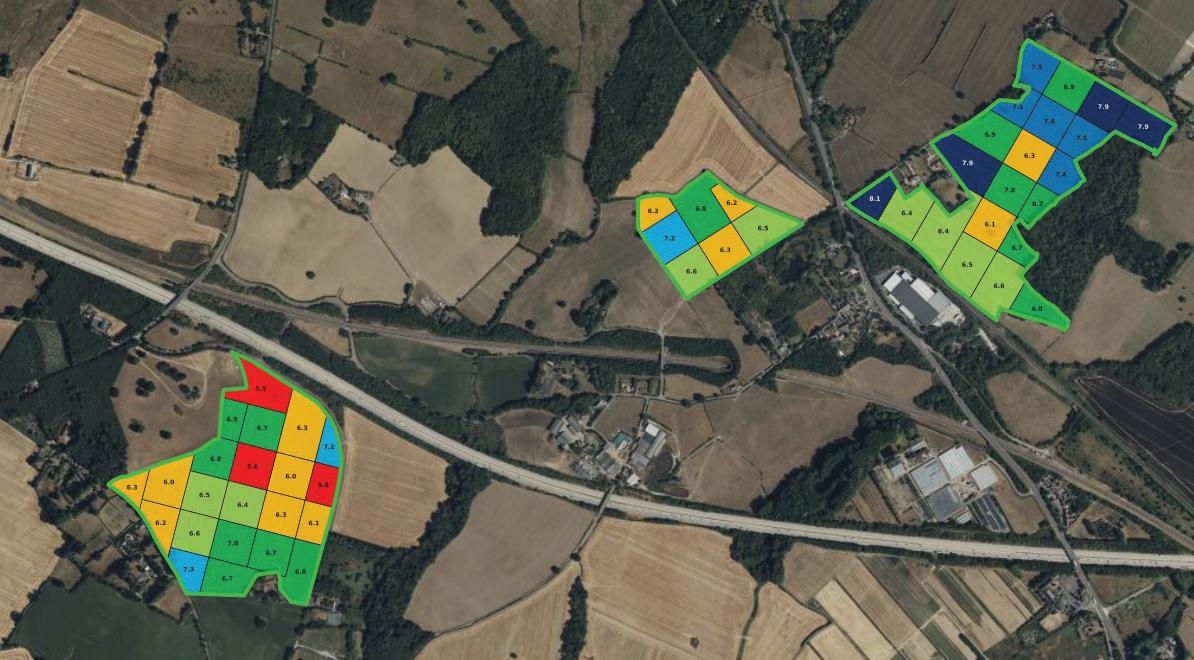
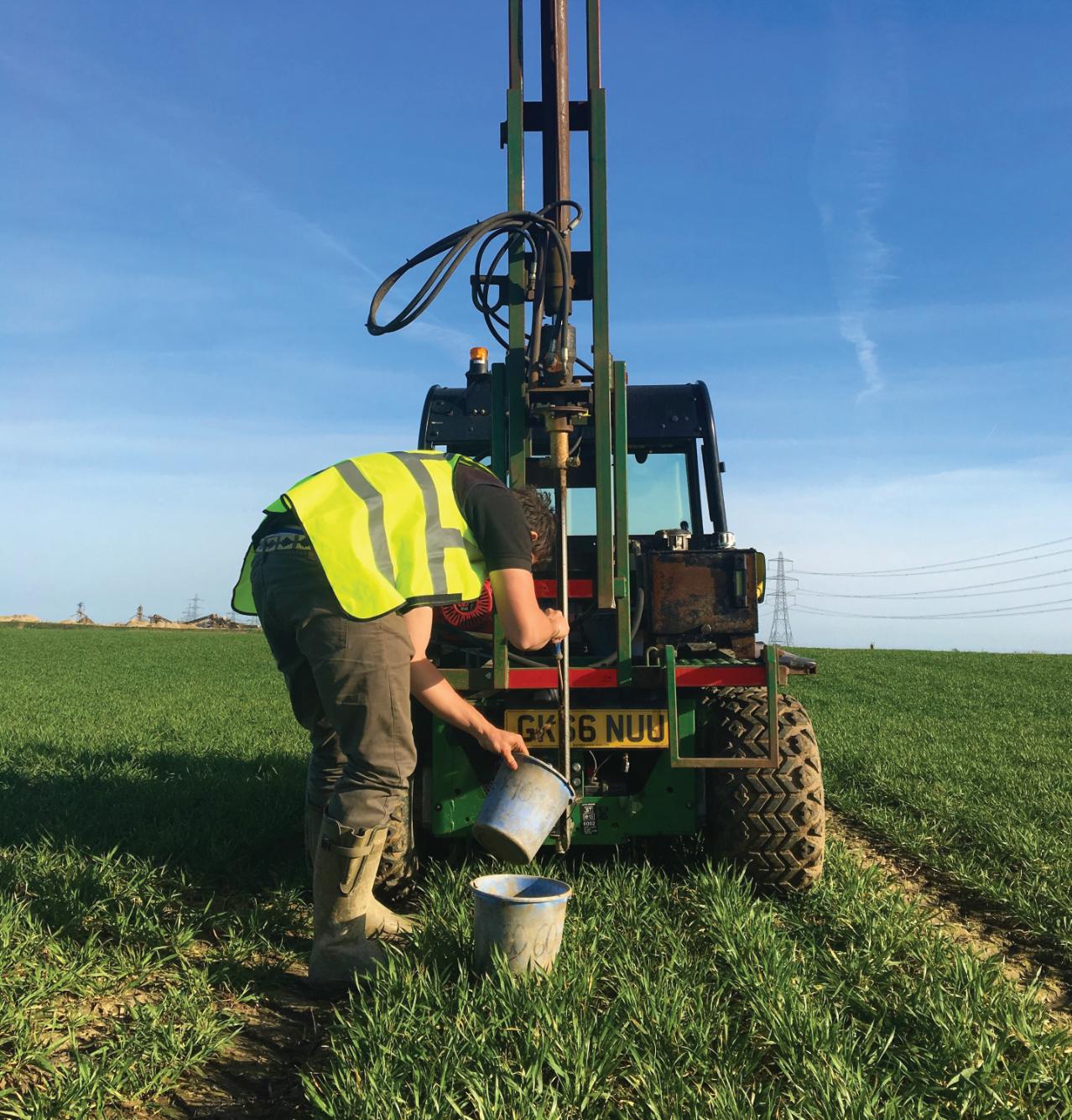
Young shepherds in the making?
One topic that has been raised consistently in conversations with sheep producers around shows, sales, markets and events from the South West to the Midlands to the South East, has been concerns about the scarcity (although not a complete lack) of good, young entrants to the sheep sector.
Having been involved in agricultural education for almost 40 years, it is a subject I have tried to avoid for fear of treading on toes, but needs must. With the average age of sheep farmers in the UK at around 60, many who are approaching, or have passed, their sell-by date are keeping going simply because of the lack of suitable replacements. The sheep sector desperately needs good, welltrained and skilled young entrants. For some, family members have simply found betterremunerated employment beyond the farm gate; others have sought working shepherds to help but have been unable to find suitable applicants.
It is a difficult situation with no easy fix, but one that we all need to assist in resolving. To a degree it’s a problem of our own making; there are certainly elements within the sector that are disparaging of new entrants, their opprobrium largely based on some rather outmoded prejudices and a failure to recognise that we now, rightly or wrongly, live in a very different world in terms of attitudes to work and the quality of training that many of the youngsters receive. The bias is often based on third-hand knowledge and their own experiences as youngsters entering the industry. I appreciate that labour is an expensive resource and that the majority of sheep enterprises simply cannot afford to carry passengers, but with a bit of forbearance and some appropriate on-the-job training (often guidance), a new entrant can, relatively quickly, become a productive member of a shepherding team.
With regard to skill levels and quality of training, many of the older people within the sector measure the qualities of college leavers against their own educational/college experiences, but sadly this is akin to comparing “chalk with cheese”. Courses are not the same; those that achieved a national diploma in agriculture, dairying etc decades ago studied completely different courses in terms of content, context and academic rigour to the modern national diploma student.
The political decision some quarter of a

century ago to direct 50% of school leavers into a university education inevitably led to a gradual shuffling down of standards, starting from the top but now pervading all levels of both further and higher education; my apologies to some of my past students, but as a measure, in my latter years in agricultural education, I taught successful (some very good) degree students at level 6 that 30 odd years ago would simply have been good diploma (level 3) students. It is not the fault of the youngsters. Neither, generally, is it the fault of the colleges. Many have excellent staff, working hard, determined to make a “silk purse out of a sows ear”; some with a reasonable degree of success, others who really could do better and, sadly, a few who are failing both their students and the industry.
The fault sits predominantly with permitted course provision. Gone are the days of collegedevised and externally moderated courses

that enabled colleges to afford a degree of local flavour to their courses; they have been replaced by centrally devised and administered courses, the content and rigour of which has sadly diminished over the past three decades or so. Much course content is now generic (cheaper). For example, an agricultural student will basically follow the same business studies course as a hairdresser; slightly different emphases, but basically the same course. Gone are the days when a good diploma student coming out of college was capable of putting together a reasonably accurate and wellcosted five-year farm business plan. Many now won’t even understand a gross margin or cash flow forecast; don’t blame the students for failures in the system.
Agricultural education is unfortunately rather resource-heavy. These are expensive courses to run, and while they do attract some additional funding, finances rely very much on ‘bums on seats’, a need that has, in some of the less popular colleges, led to a ‘degree of flexibility’ in both admissions and achievement criteria, with considerable pressure, again financial, for students once enrolled to
Well, well, well… it would appear to be back with a vengeance; the “Achilles heel” for most livestock farmers, otherwise known as bluetongue.
The first text came through on 26 August regarding a suspected case in South Norfolk and since then we have had a steady stream of texts from APHA (Animal and Plant Health Authority) updating us on our movement status regarding animals.
At the point of writing, some areas of Kent appear to be in a Restricted Zone (RZ) whilst others are in a Temporary Control Zone (TCZ) and the remaining areas are free to move as they wish. This map changes daily/hourly. I believe the whole of Kent, Surrey and Sussex will be one restricted zone in the near future.
Bluetongue remains a notifiable disease. Sheep would appear to suffer the highest mortality, with milk loss in dairy cows coming a close second. It does not affect people, or food safety, but it does result in prolonged animal movement and trade restrictions, creating an impossible financial situation for many farmers in the affected zones.
We suffered a huge financial loss last time (extra feed, labour, overstocking etc) when movement restrictions were put in place, and to continue with movement restrictions will see many farmers face unavoidable financial difficulties that will become unsustainable. If any farmer/farmers are suffering, please contact the FCN (farming Community
succeed, whether or not success is entirely deserved.
The whole system of agricultural education (and other vocational areas) is in desperate need of significant revision; it’s a solvable problem, but it does require political will to bring about changes. If you are concerned about the lack of willing and suitable candidates to join an ageing workforce and, inescapably, the long-term future of the sheep sector, don’t just moan about it, pressure organisations such as the NFU, NSA etc to lobby government. We really do need change, but don’t blame the younger generation. Shepherding and sheep keeping will never be as financially rewarding as many other
Network) RABI (Royal Agricultural Benevolent Institution) or the NFU as soon as possible. I understand the need to eradicate this midge-borne virus, but common sense must prevail in addition to the needs of the country. If I understand it correctly, the Government is reluctant to declare the country a bluetongue zone as this would shut down our breeding stock export market and other such markets, including import/export of semen etc.
Bluetongue is everywhere, it would appear. On the continent over 4,000 cases have been detected, so why not merge us all as one? At the present time the virus has been detected in Yorkshire and down to Canterbury; I estimate that it has probably spread far and wide throughout the country at this time. Fingers crossed that we have a cold/frosty winter to try and contain/reduce the midge burden.
With harvest over and the 2024 drilling season nearly completed for another year, this seems a good opportunity to reflect on the past year’s crop growing season. In general terms all went well, no records broken but not disastrous. A challenging spring for most farmers appeared to affect the protein content in the crop. A lot of wheat fell short of the requirements for milling. Maize struggled in the cold, wet, early spring and yields reflect this.
Dunging the yards was one of the first jobs on the list, followed by a long, long list of others. Winter is always a time to give all the machinery a complete overhaul.
career paths, but it does have other, oftenintangible benefits, job satisfaction being high on the list. We need to be able to sell the positive aspects of the role. Shepherding can be hard, but it is rewarding work. It is simply that the rewards may not always be immediately obvious; probably not the easiest thing to sell to a teenager, but that does not mean that we shouldn’t try as an industry to encourage them. There are good youngsters desperate to work in the sheep sector; there are also those who, having gained a bit of experience, are struggling to get started as sheep keepers in their own right. There is a duality of needs; older sheep keepers struggling with the work but with the resources and young, capable

This time of year, the beautiful colours of autumn are showing, the fields are changing daily and the coastal fog is making an appearance again. We are back in a routine (of sorts); it’s dark in the mornings so head torches are now back out of hibernation. Half term will have been and gone and will be closely followed by the big “C”…
An unexpected proposal came from Monty at the beginning of September, with an announcement that he would like to take a gap year before heading off to uni. He had mapped out a solid plan for his year and upon reflection we all felt that this was the best way forward.
The university has readily deferred his place until Sept 2025. November will see him heading to Scotland for three months to work/ learn on a huge dairy farm followed by three months farming in America. Fingers crossed he will be home by silage time and harvest. I am sure he will have the most amazing time and be an asset for whoever he works for. We will certainly miss him, and the supper table won’t benefit from his humour for a while. His number one fan will live on Facetime most nights while he is away.
Until next time, stay safe.
shepherds, with experience, struggling to gather sufficient resources to establish their own business. Surely such situations merit the consideration of some contract farming arrangements capable of satisfying both needs; providing an enthusiastic young shepherd with an opportunity to develop business experience, build a meaningful resource base and shoulder much of the workload, while enabling the resource bringer, the older sheep keeper, to step back, possibly to ease into retirement. It is an approach that does require careful planning, but one which can be mutually beneficial. Give the youngsters a chance; the industry needs them, desperately.
With the onset of bluetongue at the beginning of September 2024, market trading became more difficult for a period in Essex, Suffolk and Norfolk, with the trading areas changing, it seemed, daily. When Essex became part of the East Anglian restricted area, it made trading livestock far easier but still put great strain on breeders of pedigree bulls, rams and ewes who would normally be trading outside the area.
Let us hope common sense has prevailed by the time this report, written in mid-September, is read. Although the powers that be are keen to see livestock movements restricted, it is difficult for those who are trying to make a living out of livestock at a challenging time.
With all the issues that arose in early September, the beef trade continued to be strong, with numbers generally insufficient for the demand in the markets. More cattle were certainly sold to advantage. Best cattle were still trading well over 300p/kg in the live ring, with weight no issue. The cull cow trade continued to be strong throughout the period; with schools returning, there is always an increased demand for catering beef.
Store cattle continued to be short, but those which were available







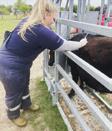



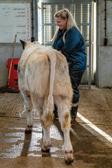





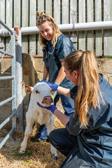




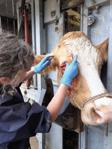









For and on behalf of Stanfords T: 01206 842156 E: info@stanfords-colchester.co.uk www.stanfords-colchester.co.uk
were keenly sought by buyers looking to restock yards throughout the area. Cattle could only be sold, at the time this report was being written, within Essex, Suffolk and Norfolk, but there are buyers out there looking for cattle.
The sheep market continued to be strong for the time of year, indeed at levels not seen before. Best lamb was still trading at over £150 a head and up to £180 most weeks. Weight and meat are paramount. Lean lambs are heavily discounted in markets, although those values being included in the market averages gives an unfair position. As stated, these prices are unheard of at this time of year.
Store lambs started to come forward in bigger numbers in late August/early September, with local finishers looking to stock areas of stubble turnips and other fodder crops. Store lambs are generally £5 to £10 a head dearer than £12 months ago but, again, quality is important. Many lambs had a bad start to the year and that was reflected in the quality of those coming forward.
The cull ewe trade remained strong for the best, but lean ewes during the period were getting more difficult to place. A lot of very plain ewes were coming forward.
With regards to the pig market, the trade continued to be as previous months, with supply, as stated previously, matching demand. The cull sow trade, however, continued to decline, with little sign of that changing.
As this report was being written, the harvest in East Anglia had finished; an average year is the best that could be said for it, with yields being generally lower than had been hoped for and certainly prices down on what had been anticipated. It is strange to see prices so subdued when there are areas of the world where growing crops is more difficult; surely we would be producing more of our own food in this country to support what we have.

We are in the middle of our busiest time of the year, with livestock sales at least twice a week, huge numbers of stock coming forward and many still to come, when suddenly a huge ‘bluetongue’ rock lands in the middle of the livestock world, sending waves way beyond the borders of the Restricted Zone. The fact is that there will be further changes, but will it be tomorrow, the next day, next week or whenever? It is that uncertainty that makes it so difficult for all of us in the livestock sector to plan.
The need for composure and understanding is critical. A consoling factor to producers, and one they need to remind themselves of, is that their beef and lamb is in short supply and in strong demand, with prices at record levels. There are no major issues surrounding the marketing of slaughter animals; issues do surround the store sector, certainly, but these are evolving, and constructive communication with your auctioneers will be more effective than picking up on heightened tensions from conjecture on social media.
Enough said on bluetongue, as by the time this is in print the borders and position will have changed several times.
Harvest is now almost complete, with autumn cultivations and drilling well underway. Maize looks great. Late grazing has been freshened. Not all is gloom and doom.
Through September we have had two strong sales every week, with our regular Tuesday market and Friday store lamb and breeding sheep sales. Tuesday cattle numbers are being swelled by increased fat and cull entries reaping the benefit of the superb prices and the beginnings of seasonal store cattle sales.
Fridays have been very busy from the start, with 6,000 to 7,000 store lambs each week meeting a marvellous trade from customers from a wide area, but with the bulk of the numbers travelling west to the surplus dairy grass.
With the strong lambs up close to £120, and overall averages up around £95, producers have enjoyed a good autumn to date. Records, certainly, were broken on ewe lamb day, with over 2,000 ewe lambs and Suffolk x Mules selling to £156 from D Howard Farms, Brede. Breeding sheep of all ages reflected the confidence in the
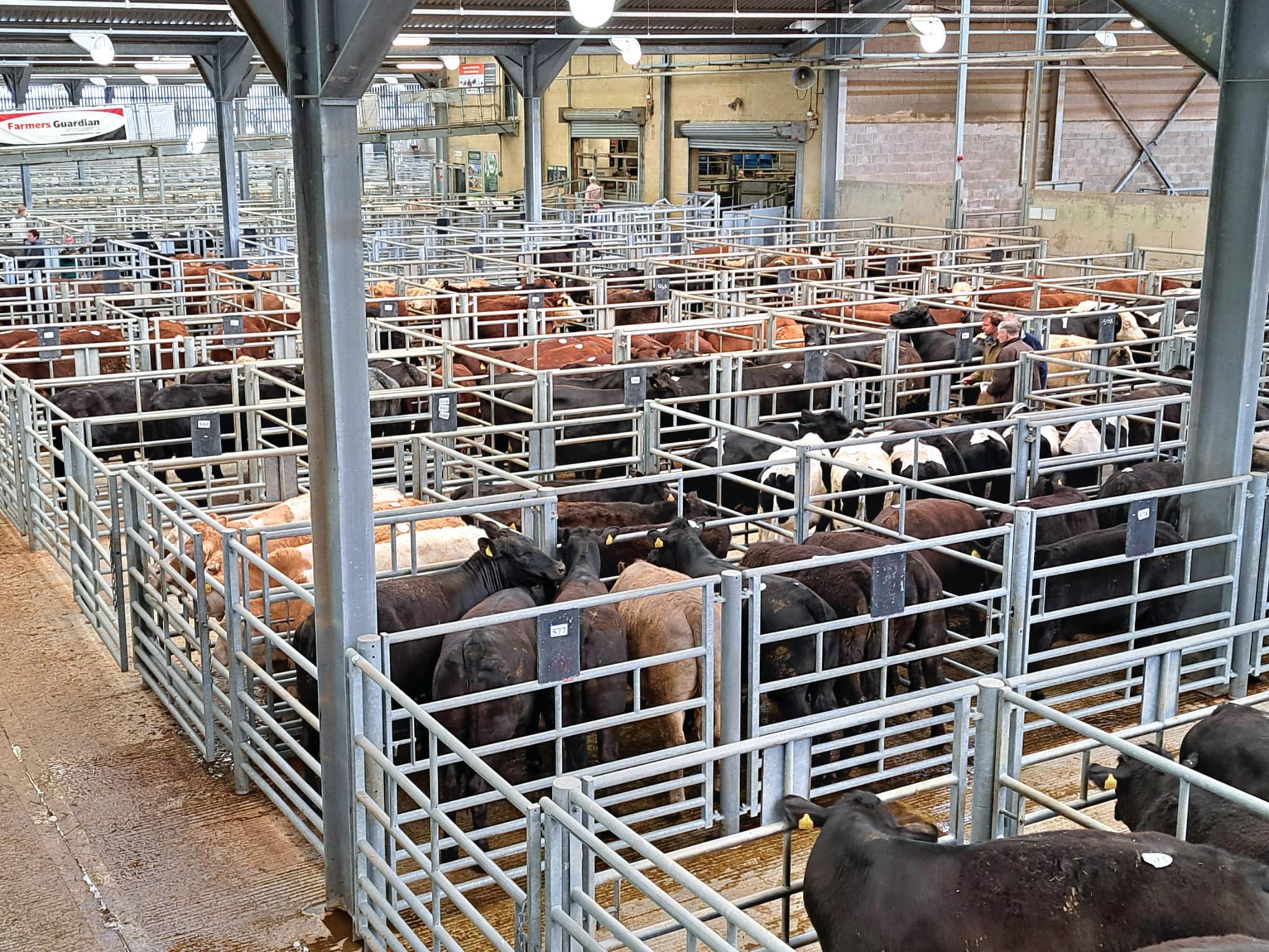
industry, with Suffolk x Mule tegs regularly over £220 and the best of the older ewes at £150 to £180.
We sold close to 60,000 store sheep last autumn and we have had a good start but, make no mistake, there are fewer sheep and cattle in the country after years and years of persecution by a retail sector that thinks only in the short term and only about their own profits.
Many of the older generation have retired, but it is encouraging to see so many young farmers up and down the country showing positivity towards their industry and investing in both breeding and feeding stock. We salute you and remain, ourselves, committed to this industry, whatever is thrown at us.
The autumn store cattle sales are just getting going, with the first sale in September selling over 350 cattle, averaging £1,029 per head. Stronger cattle with more age and ready for the final finish tend to be the best sellers at this time of year, but with numbers short and wanted, it has made all ages, shapes and sizes a marvellous trade. There were plenty of cattle over £1,200, with CW Jones, Hever, topping the day with Angus x steers at £1,800. Continentals were led by Miss Emily Wood, Hawkhurst, with Limousin x steers at £1,720. Young quality
Limousin 10 months from D G & J W Gore, Rochester, sold to £1,180, while Sussex topped at £1,275 from R Luck, Benenden. Every year we have the pleasure of attending local ploughing matches, and hopefully by now we will have met up with many farming friends at the Romney Marsh, Weald of Kent and East Kent matches. These are a great opportunity to catch up with customers in an environment with less rush and pressure.
The market is a union to which we all belong, a place to share the good days and the difficult ones. We are all in this great industry and, by coming together as sellers and buyers, the strength of competition serves to provide for and protect us all.

Bovine Respiratory Disease (BRD) is a general term for respiratory disease in cattle which costs the UK cattle industry an estimated £50 million every year. These losses arise most significantly from calf deaths but also include the cost of treatment, reduced weight gain and increased labour. Furthermore, it is the most common reason for death and poor performance in young cattle from weaning to 10 months of age.
The disease complex is multifactorial, which means that viruses, bacteria, husbandry and management factors all have an essential role in outbreaks. The most cost-effective approach to dealing with this disease is prevention. Pathogens which cause BRD include:
The viruses that commonly cause respiratory disease are:
• RSV (respiratory syncytial virus)
• Pi3 (parainfluenza virus 3)
• IBR (infectious bovine rhinotracheitis)
• BVD (bovine viral diarrhoea). These viruses spread via nose-to-nose contact, in the air over short distances, indirectly on clothing and equipment and even via semen.
Bacterial pathogens cause the acute syndrome by invading the bovine respiratory tract that has been compromised by viral infections, environmental conditions and/or other stress factors
The bacteria capable of causing penumonia are often found in the normal nasal passages of healthy calves but cause severe lung damage and often death when they are allowed to penetrate the lower airways. The most important bacteria are:
• Mannhaemia haemolytica
• Pasteurella multocida
• Histophilus somni.
• Mycoplasma bovis.
Lungworm, also known as husk, is caused by Dictyocaulus viviparus, which is a roundworm affecting grazing cattle of all ages. The disease
Matt Dolbear, Winchester branch, looks into why the most costeffective approach to dealing with this disease is prevention.
is usually seen in mid to late summer following a grazing period. All cattle are susceptible unless immunised through natural pasture challenge or vaccination.
Clinical signs vary from occasional coughing to severe respiratory distress and death, depending on the numbers of larvae ingested during a short period. The disease has an incubation period of about three weeks, and once clinical signs are present the health of the animal is already severely compromised because of the damage the worms cause to lung tissue.
• Reduced feeding
• Raised temperature (above 39.4°C or 103°F)
• Increased breathing rate and effort
• Head down and looking depressed
• Coughing
• Nasal discharge (clear mucus initially, may become thick and purulent with time and secondary infection)
• Death – If the animal does survive, the lungs will often be too badly damaged to repair and the animal will remain ill-thriven and suffer recurrent bouts of pneumonia.
Ventilation is extremely important and is affected by the number and size of the inlets and outlets, height of the building (and surrounding buildings), direction the building is facing, drainage and the stocking density. Providing adequate ventilation is essential for keeping housed calves healthy.
• Adequate colostrum at birth is essential in pneumonia control and in the control of many other diseases like scour. Colostrum provides the calf with essential antibodies which protect it for the first three to four months of life. The ‘5Qs’ – Quantity, Quality, Quickly, sQueaky clean and Quantify – are key to ensuring that youngstock get the best start in life.
• Avoid overcrowding and mixing calves of different ages as this increases stress on the younger calves and exposes them to bacteria and viruses to which the older calves may have been exposed.
• Avoid stress caused by weaning, castration, and disbudding/dehorning, especially when there is high risk of pneumonia, such as at the start of winter housing.
• Clipping the backs of housed calves has been used to lower the incidence of pneumonia by reducing sweating.
Vaccines are an important way of helping control pneumonia provided they are not substituted for good management and environment. Vaccination programmes should be timed so they are completed about a month ahead of the main risk period – housing – so their immune systems are ready for a fast, specific response at time of challenge.
Farmers will often be required to treat the occasional case of mild pneumonia, but if large numbers of calves are affected or if the disease is severe, veterinary attention should be sought. A response should be seen following an appropriate antibiotic treatment in the first 24 hours. Anti-inflammatories should be used alongside antibiotics as these are important in reducing inflammation in the lungs as well as reducing the fever present.
It's great to see our amazing students back in college. The new term has got off to a fantastic start, with many new innovative activities that the teaching and farm staff have been developing for our students' return.
One of the main activities was our students' involvement in Back British Farming Day on 11 September. The NFU's Back British Farming Day is an annual event celebrating British farming. Now in its ninth year, the day's activity highlights to the Government the importance of agriculture to communities and the economy.
Agriculture has shaped the landscape for generations. Everything we see and do in the countryside has been cared for by farmers and those in the rural community. This is why we at Plumpton are proud to support British farming.
Students were intrigued to learn a lot of interesting facts about agriculture in discussion groups and displays in classrooms; these included facts such as:
• More than 700 different types of cheese are produced in the UK
• On average, we eat 192 eggs per person yearly; that's enough to make 1,152 fairy cakes
• The UK is home to more than 60 breeds of sheep
• Farmers manage 71% of the nation's landscape
• A field of wheat the size of a football pitch produces enough grain to make 11,500 loaves of bread.
It was an interesting and productive day, and lots of students expressed their pride in studying agriculture at Plumpton College.
Riley Oliver's outstanding dedication to his agricultural crop technician apprenticeship is genuinely remarkable. Travelling 75 miles weekly from Dover to Plumpton College, Riley's commitment is unparalleled.
Despite being a new entrant to farming, Riley's passion for agriculture has been evident since childhood, having helped on farms when growing up. His academic excellence at Plumpton College, achieving

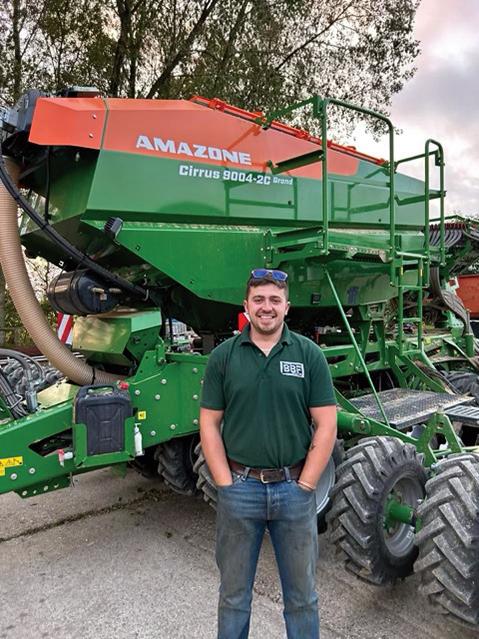
the highest sector grade for the EPA pathway, underscores his potential to impact the industry and inspire his peers.
Riley is a respectful, hardworking and wellliked student. He participates in all arable operations and collaborates with industry experts. His eagerness to educate others on the farm benefits the entire team.
Selected for the management pathway with Velcourt, Riley is instrumental in promoting sustainable farming practices to reduce the industry's carbon footprint. His passion for agriculture drives him to embrace modern technologies and integrate them into the workplace.
Riley's ambition to inspire future generations has earned him the titles of Plumpton College Agricultural Apprentice of the Year 2023 and Cross College Apprentice of the Year 2023. Beyond the college, Riley actively participates in agricultural shows and competitions, representing his college and industry with distinction.

If you are an employer and would like to know more about the benefits of taking on an apprentice, the college would be delighted to help; get in touch with our apprenticeships team at business@plumpton.ac.uk
Almost a month into the academic year, the college has been busy welcoming new students to the beautiful surroundings of Hadlow’s large managed estate set in over 265 acres of prime arable land. Making new students feel at home here is easy, because one thing Hadlow College prides itself on is its wonderful sense of community.
This is something that was recognised over the summer when Ofsted carried out a review of the college’s residential accommodation, which consists of 199 residential units, 147 units for further education students and 52 for higher education learners. Hadlow’s residential provision was judged as outstanding across all categories.
Inspectors delivered a series of glowing tributes, saying “residential students thrive

If you are interested in studying at Hadlow College and want to find out more, come along to our next open event, which runs from 10am to 1pm on Saturday 9 November. This will give you a taste for the college and allow you to experience our facilities and speak to current staff and students.
because of the warm, caring and nurturing relationships that they have with the residential staff ” and adding: “Residential students are overwhelmingly positive about their time at the college and say it is like a family.”
Whether living on site or not, people who study at Hadlow College benefit not only from a beautiful location but also some of the best facilities in the country.
Last year the college launched its sustainable orchard and vineyard, with the orchard using the latest technology to grow fruits, including apples, plums, cherries and apricots, in a sustainable and environmentally sensitive way.
This is literally bearing fruit right now, with the first harvest having just taken place. The apples are being pressed and turned into fruit juice, so keep an eye out for that.
Our Thanet Earth Centre of Excellence, a groundbreaking partnership between the college, leading industry grower Thanet Earth and research and innovation organisation Growing Kent & Medway, opened in June.
This is based at Hadlow’s state-of-the-art glasshouse and is the UK’s first centre of excellence in greenhouse growing, connecting students with leading businesses from the greenhouse sector to develop a new
generation of skilled workers to protect the future of UK-grown fresh produce.
Just one month before, in May, the college took home a bronze medal at the prestigious RHS Chelsea Flower Show.
Hadlow’s animal management unit is one of the best of its kind, housing over 500 animals from 125 different species. Its numbers were slightly increased over the summer as the college welcomed four new baby meerkats to the new meerkat enclosure.
The college is also home to the National Centre for Reptile Welfare, which provides refuge and care for up to 600 unwanted and vulnerable reptiles and amphibians.
Hadlow also offers much more, including:
• A fully functioning commercial farm that is home to 35 ewes, as well as a separate farm housing a herd of beef cattle
• An equestrian stabling area that accommodates 64 horses, along with two international-size indoor arenas and paddocks
• A fully stocked fisheries hatchery containing a variety of tropical and cold water fish, more than 50 aquarium tanks and Grove Farm, a two-hectare mixed coarse fishing lake and growing-on ponds
• An agricultural workshop with 540 square metres of floor space that can accommodate many kinds of project, from vintage and classic tractor restorations to modern tractor servicing and more.

Visit www.hadlow.ac.uk/events to register or find out more


Classic ‘barber’s pole’ appearance
A mass of Haemonchus worms in the abomasal contents of a ewe in early July

White mucus membranes (anaemia)
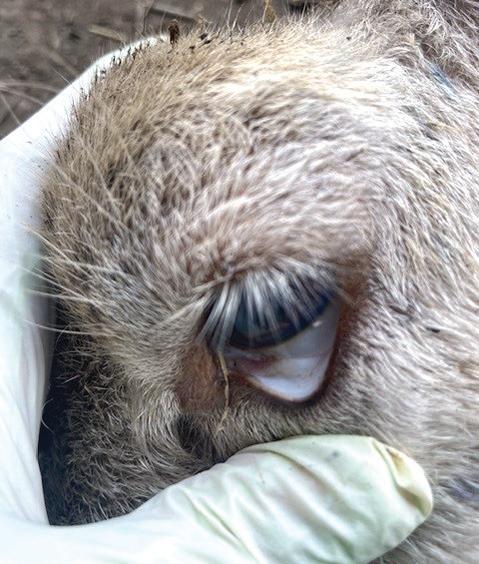
I think most farmers will agree it has been a terrible year for worms, and I’m not sure it is over yet, with a warm September so far. We have had many high worm egg counts for ewes and lambs this year and in my 13 years of being a vet I have never diagnosed so much Haemonchus.
Above are a few photos from post mortems I have performed over the summer. The level of burden has been astonishing and Haemonchus can catch people out. Because the sheep do not scour, without regular faecal worm egg counts (fwec) it is almost impossible to see it coming other than by monitoring parasite forecast and knowing the risk of the pasture they are grazing. Sheep are often severely affected by the time it is diagnosed.
Haemonchus can be treated with any broad spectrum wormer but if you know it is Haemonchus (ideally from your vet performing a post mortem examination, or having an egg count in the thousands combined with pale mucus membranes) then it may be better to treat with something a little more narrow spectrum to avoid speeding up the development of wormer resistance to the broad spectrum wormers, for example using Closantel, which treats Haemonchus and fluke but not other roundworms.
On that note, it is worth mentioning the importance of following ‘SCOPS’ principles to slow the development of resistance on your farm:
• Choose the right product with advice from your vet and administer it correctly; ideally check for treatment efficacy by performing a drench check.
• Monitor fwec, manage grazing and nutrition, check parasitic forecasting tools.
• Have a robust quarantine protocol to avoid bringing in resistant parasites.
• Minimise the selection for parasites that are resistant to treatment:
– Leave at least 10% untreated to maintain the ‘in refugia’ population on the pasture. (diluting the resistant worms)
– Use products with persistent action carefully
– Use group 4 and 5 wormers (for example Zolvix and Startect) strategically.
It is easy to forget the importance of these principles, but they are key to minimising wormer resistance, and this is critical to maintaining and improving the productivity of any sheep enterprise. If the worm burden on the farm becomes multi-resistant to the broad-spectrum wormers, it makes controlling worms challenging.








Call us today or visit our website: 01227 763939 furleypage.co.uk
As incidents of animal activism continue to rise within the UK agri-food sector, specialist agricultural solicitor Aled Owen, who has first-hand experience of advising on recent cases, has reinforced the importance of heightened vigilance and preventative measures.
“Animal activists are more sophisticated than ever before,” explained Aled, a partner in HCR Law’s agriculture and estates team. “And as recently highlighted by National Pig Association chair Rob Mutimer, they are increasingly targeting both farm businesses and processors.”
Aled explained that while encountering activists on a farm premises was extremely challenging, it was essential to remain calm in the heat of the moment and take the right steps to help protect the business.
“When activists are present on farm, it may be tempting to engage with them, but it is crucial to refrain from doing so,” he explained.
“Prompt involvement of the police not only helps manage the situation but also eliminates the necessity to make any comment due to the incident being ‘subject to police inquiry’.
“And, although activists have the right to protest, the methods they employ may sometimes lead to legal violations. It's therefore important to let the police handle these matters professionally.”
Aled suggests all farms and processors should adopt more robust preventative measures to protect their operations and mitigate potential disruptions.
“Security measures such as CCTV, security lighting and fencing are essential,” he said. “What often gets overlooked, however, is the

importance of thoroughly vetting potential employees.
“I'd recommend conducting thorough background checks and scrutinising potential employees, especially when their experience appears questionable or misaligned with the job they are seeking, or when their qualifications do not match the job requirements.
“Make sure employment contracts include
specific conditions that prohibit employees from working with third parties, as any breach of these terms constitutes fraud.”
He concluded: “Unfortunately, this is a problem that is unlikely to go away. I’d therefore suggest that all farm businesses and processors employ preventative measures and take the right steps in the event of being targeted, to help protect themselves and their businesses.”
As we welcome the early days of autumn, it’s a good opportunity to reflect on the rural residential property market and how it’s holding up. Sara Smith, Head of Residential Property at Brachers law firm, provides valuable insights into the current trends and future outlook.
We have certainly seen some confidence returning to the property market. The reasons for this could be multiple, but one cannot deny that the first cut in interest rates for four years would have had an effect. With the base rate now 5% and inflation slowly coming under control, these are positives for the property market.
The interest rate hikes over the past couple of years have clearly had a detrimental impact on the property market, significantly slowing its momentum. Naturally, all this was compounded with the cost-of-living crisis, but optimistic reports from agents confirm that more and more sellers are now putting their properties on the market.
There has also been an increase in the volume of mortgages being approved, with research indicating that, in July 2024, they were at their highest since September 2022. Not only are mortgages being approved but the number of mortgages completing is on an upward trend. Lenders have more favourable rates on their books, which will certainly prove attractive to potential buyers.
The Labour Government has also brought a wave of proposed changes that could impact the rural property market. Labour has promised to introduce a land use framework, with suggestions that this will give the sector

direction on how to balance what is now expected from land, food production and benefit to communities.
Given the clear connection between rural property and the farming sector, it remains uncertain how, or if, these policy changes will support the farming industry. It's also been proposed that 1.5 million new homes could be delivered over the next five years with the plans to free up some low-quality green belt land as part of the ‘grey belt’.
Support to the rural communities has been on the books for some time, with funding being offered to research ways to bring satellite, wireless and fixed internet connections to the most rural areas. With hybrid working the new norm, keeping in touch with colleagues is essential and
necessary if we want the ability to live somewhere rural but require the services to support our daily work commitments.
Rural detached properties are proving most popular as there seems to be a ‘race for space’ which all started when Covid-19 hit in 2020. This is compounded by these types of properties seeing the strongest price growth. The price growth in rural communities is holding up more strongly compared to the urban environment, but it is of course acknowledged that the property price bubble created by the pandemic has popped.
Here at Brachers we have extensive experience in supporting our clients either selling or looking to move to the countryside. We look forward to seeing what the autumn brings.

“Brachers has the personal touch, listening carefully to clients’ needs in a friendly, sensitive and helpful manner.”
Proud to be recognised for our agricultural expertise in leading directories, Chambers and Partners and The Legal 500
Maidstone | Canterbury w ww.brachers.co.uk

Despite having a historic appeal for one house quashed (application and appeal not a Bloomfields assignment!), the team at Bloomfields could visualise the potential of this site in the countryside.
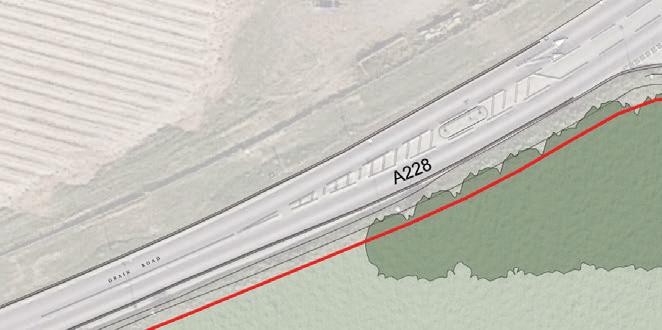
Local Plan Position
Recognising that the Council did not have an up to date Local Plan meant that the weight of support for development on site was somewhat improved, along with the knowledge that a lack of housing supply allowed further emphasis to be put on the Council for required housing delivery.
Understanding site constraints
Taking time to understand the full extent of a site’s constraints and those in the vicinity should shape the way a scheme is designed and presented. Not only is this good planning, but it means that explaining matters to third parties and the planning officer follows logic. In turn, this means that the Council’s officers can better explain this to local Councillors, consultees and neighbours as queries may arise directly with them. In this case, Bloomfields needed to consider the location of a high-pressure gas main across the site (this required consultation with Health and Safety Executive), the opportunity to improve an access (Highway Authority), local housing that had perceived heritage value (Conservation

officer), the topography of the land to address perceived flood issues (local Drainage Board and the Environment Agency) and the need to provide good landscaping to offer both screening and ecological gains (ecologists).
Pre-application advice

Having open dialect at a site meeting with the Council meant that the design of this scheme could be amended to meet some of the Council’s initial views regarding housing layout and density. It was also a useful way of confirming the extent of reports the Council would want accompanying any application. This not only reaffirmed what Bloomfields had set out to their client, but it gave the applicant greater comfort and financial understanding when it came to considering how they wanted to proceed.
Knowing when to press the button Despite local objections to the scheme, and from a Ward member calling for refusal at Committee (despite a positive
“Understanding the position (or lack) of a Council’s Local Plan and their ambition (or not) to provide development is key. A good working relationship with Councils’ planning officers makes the reality of schemes much easier to negotiate.” reports Thomas Ogden, Director at Bloomfields. The site is currently for sale through Lambert & Foster, details of which can be found by scanning this QR code.



recommendation from officers) the case was deferred by members. Rather than appealing the case and despite it not being necessary, Bloomfields advised their client to provide some additional information for members benefit. Although frustrating; when the case was back at Committee, and despite further calls to refuse the application, the application was recommended for approval by members. This saved entering the much longer, more expensive appeal process.
Site Promotion
Having promoted the site through the forthcoming Local Plan process, Bloomfields are pleased to report that the site is also now, together with surrounding land, proposed for draft allocation.



















Strutt & Parker has launched two farms and two further parcels of land in the South East, highlighting the growing momentum in the region’s farmland market. This is in line with the broader trend of increased supply seen in the UK’s rural land market this year
Drylands Farm is a 608-acre commercial arable farm being sold subject to a secure Agricultural Holdings Act 1986 tenancy. The farm will be sold under its current tenancy agreement at a guide price of £4.65 million.
Situated near Faversham in North Kent, the farm lies within the picturesque Kent Downs National Landscape. It comprises a mix of grade two and three arable land, stretching north from Molash, encompassing Drylands Farmhouse and extending toward Perry Wood in a single, uninterrupted block, offering substantial agricultural productivity.
The farm is ring-fenced, with a private, Grade II listed farmhouse

at its core. The farmhouse is accompanied by a few traditional farm buildings, creating an appealing residential farm with the potential to be transformed into a stunning country estate, subject to vacant possession and planning consent. There are various farm buildings supporting the operation, with some located at Drylands Farmhouse and others situated separately.
See pages 54, 58 and 60 for the other properties.
The land is SSSI wood pasture and parkland. We’re seeking someone with conservation grazing experience. Native breeds will be preferred. Potential for year-round grazing. Crowborough area. No fence collars available.
L a n d & P r o p e r t y E x p e r t s t
W Y E D O W N S
A n u n s p o i l t p e r i o d f a r m s t e a d s e t w i t h i n t h e K e n t D o w n s N a t i o n a l L a n d s c a p e
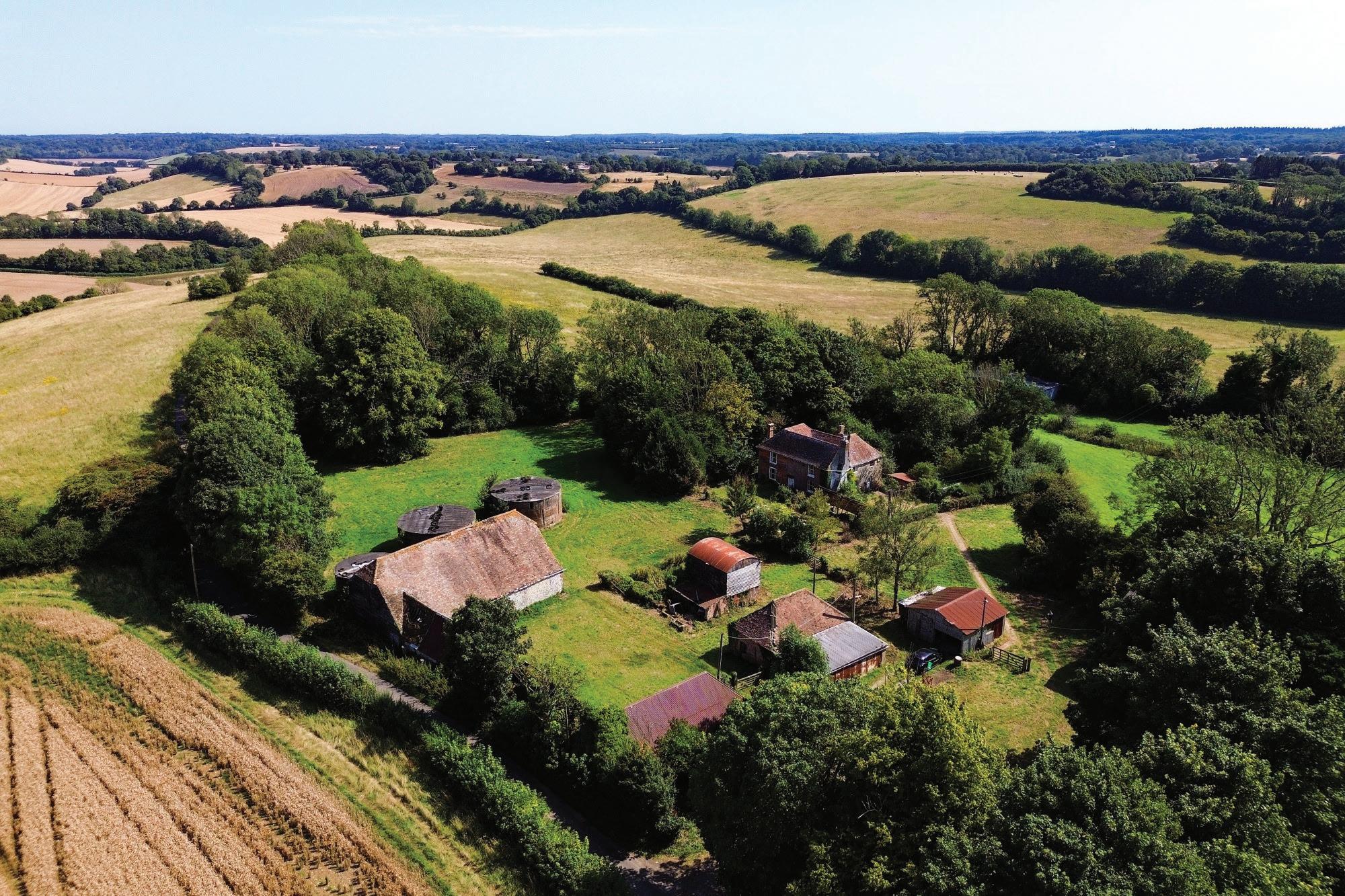

B u i l d i n g s i n c l u d e a 4 - b e d r o o m G r a d e I I L i s t e d f a r m h o u s e f o r i m p r o v e m e n t , b a r n s , a g r a n a r y a n d o t h e r
o u t b u i l d i n g s
S i t u a t e d i n t h e W y e D o w n s a n d c l o s e t o t h e v i l l a g e s o f H a s t i n g l e i g h a n d E l m s t e d
I n a l l a p p r o x i m a t e l y 6 5 2 a c r e s

T H R E E O A K S | E A S T S U S S E X
A s t r a t e g i c a l l y l o c a t e d p a r c e l o f l a n d o n t h e e d g e o f t h e v i l l a g e o f T h r e e O a k s
4 f i e l d e n c l o s u r e s a n d a s m a l l w o o d l a n d .
I n a l l c i r c a 2 6 2 3 a c r e s
G u i d e P r i c e : £ 5 2 5 , 0 0 0
G u i d e P r i c e : O I E O £ 9 5 0 , 0 0 0

S W A N L E Y | K E N T
A m u l t i - u s e c o m m e r c i a l s i t e w i t h a s i g n i f i c a n t a n n u a l i n c o m e a n d b u i l d i n g s ( 1 2 , 3 2 4 s q f t ) .
4 - b e d r o o m r e s i d e n t i a l d w e l l i n g w i t h p r i v a t e
e n t r a n c e , a n n e x e a n d s w i m m i n g p o o l I n a l l a p p r o x i m a t e l y 2 3 6 a c r e s
G u i d e P r i c e :
w w w b t f p a r t n e r s h i p c o u k c h a l l o c k @ b t f p a r t n e r s h i p c o u k
Two Hampshire farms covering just over 1,000 acres have come to the market through Savills.
Warren Farm and Littleton Farm are to the north west of Winchester and are available separately.
Warren Farm, next to the idyllic village of Crawley, is a prime, ring-fenced arable farm with a modern grain store, machinery store, four cottages currently let on assured short-hold tenancies, and former agricultural buildings with development potential, subject to planning. In total, the land extends to about 561 acres.
An immaculate, five-bedroom farmhouse with 60 acres of woodland may also be available by separate negotiation.
Littleton Farm is about a mile from the vibrant and popular village of Littleton, with an unlisted five/six-bedroom country house at its heart, along with a staff apartment and annexe, set in formal gardens. A courtyard comprises a guest cottage, farm office, garages and stables. There are a further four


/ £13,250,000
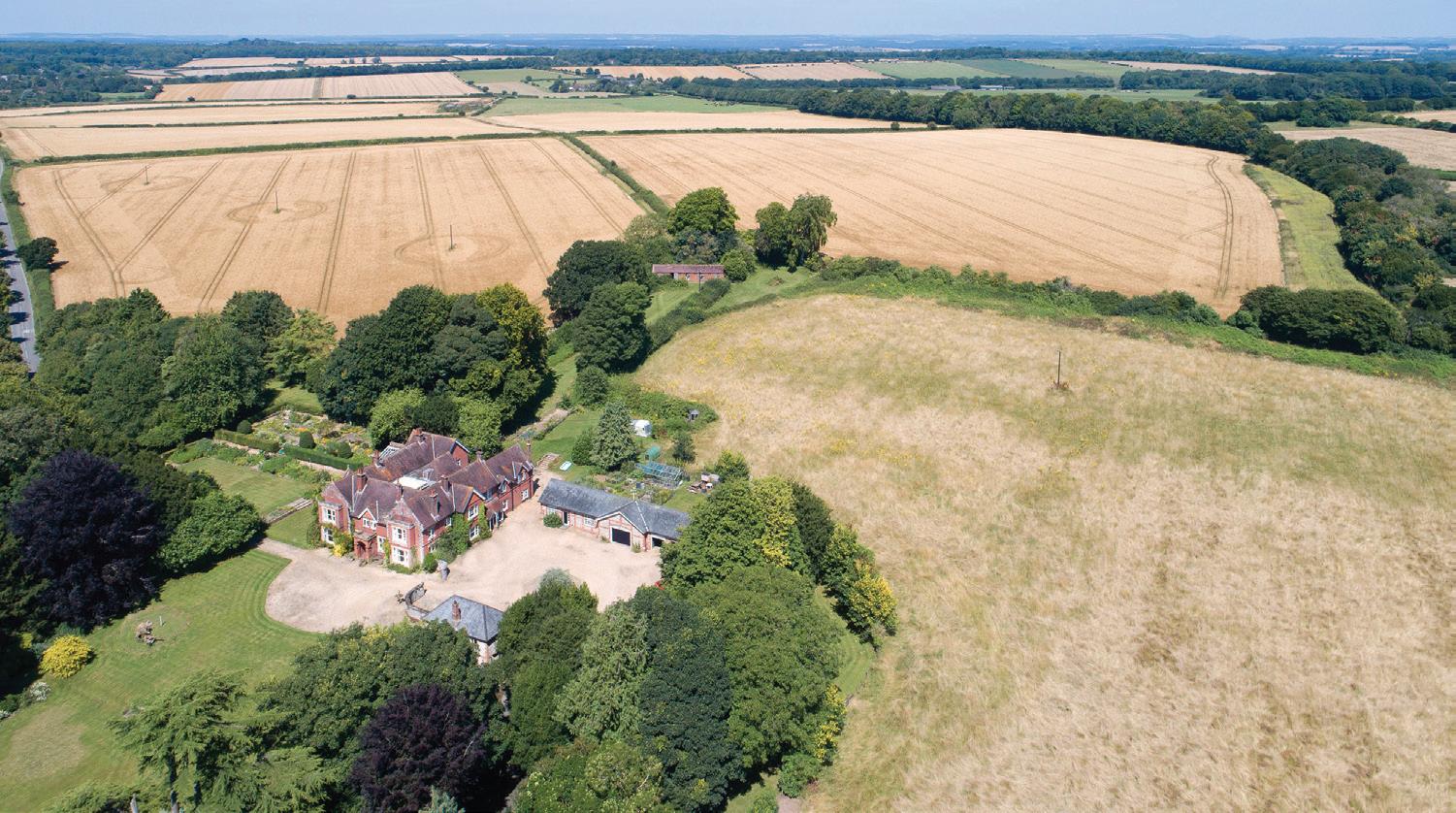
cottages and a range of farm buildings with development potential, subject to planning approval.
is available as a whole, for a guide price of £13,250,000, or in four lots.

The farm extends to a total of about 536 acres, with extensive and productive arable farmland, pasture and woodland.
Warren Farm is available as a whole, for a guide price of £7,500,000. Littleton Farm

Geoff Jones, who heads up Savills' southern rural agency team, said: “The sale of Warren Farm and Littleton Farm represents a rare opportunity to buy prime Hampshire farmland in a well-connected location, within easy reach of the historic city of Winchester.”


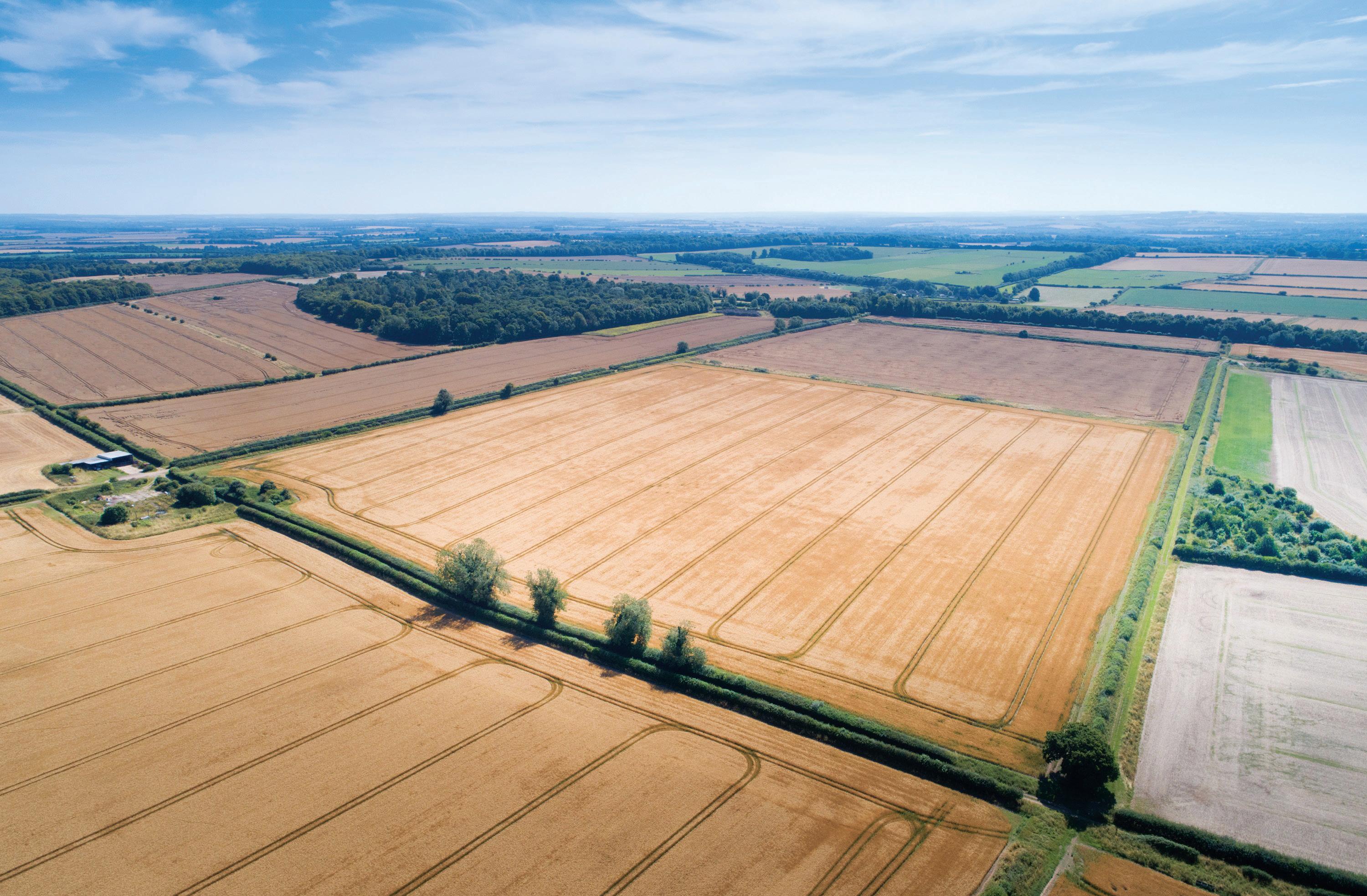

Part of the renowned Linton Park Estate, Ranters Land is a 96.41-acre parcel of land that seamlessly blends productive arable land with natural beauty. This block, comprising 89 acres of grade three arable
land, is enriched by Ranters Plantation, a mixed woodland that sits at its heart.
Located just outside the village of Linton, the land enjoys excellent road access and is separated from the estate’s parkland by Butt


Green Lane. It is currently let under a farm business tenancy, with possession available from September 2025.
The land is available for a guide price of £850,000.
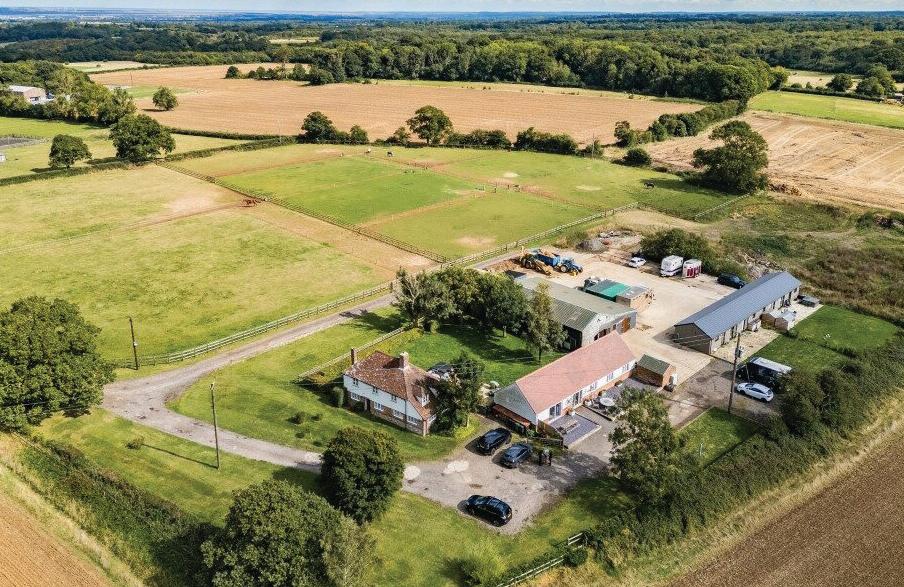

Stilebridge Nursery, Marden, Kent GUIDE PRICE
£1,500,000
A rare opportunity to purchase a former Oriental plant nursery extending to some 32.38 acres (13.1 hectares) in need of further investment, including a detached 4/5 bedroom bungalow (subject to an AOC), a modern farm building, traditional Hopper Huts, and extensive areas of former polytunnel and glasshouses. Site extends to some 32.38 acres (13.1 hectares) including significant irrigation ponds and reservoirs. FOR SALE

Scragged Oak Farm, Hucking, Kent GUIDE PRICE
£1,500,000
A truly rare opportunity to acquire an equine smallholding extending to 7.92 acres, together with a pretty, detached Grade II Listed Cottage, situated on the North Downs, high quality equestrian facilities with significant income potential from there holiday cottages. FOR SALE
KENT OFFICE 01892 832 325 | SUSSEX OFFICE 01435 873 999



Birchen Knoll Farm

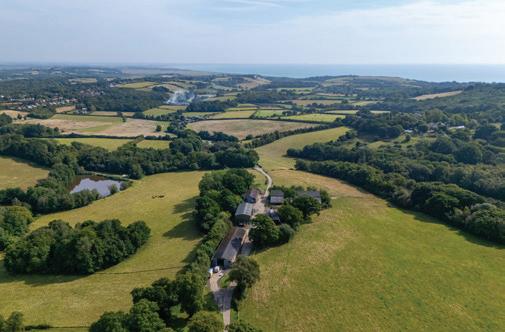
Located within close proximity to the popular coastal towns of Rye and Fairlight with sea views out across the English Channel. Approximately 2,587 sq ft 3 bedroom farmhouse with 2 bedroom annexe and large south facing garden. The farm as a whole totals 953.97 acres of which 792.48 is Grade 2 & 3 arable, 73.21 permanent grassland and 78.66 woodland. All land benefits from vacant possession and is currently contract farmed or entered into Countryside Stewardship. 40,000 sq ft of modern farm buildings with potential for alternative uses subject to planning. Available as a whole or in 5 lots.
Contact: Charlotte Pearson-Wood or Emer Edwards
c.pearson.wood@batchellermonkhouse.com e.edwards@batchellermonkhouse.com 01892 509280

Biggin Hill, Kent


A productive diversified estate of 1356 acres, located within the M25. The total arable land is 700 acres with Mid Tier and Higher Tier stewardship schemes. There is a range of let residential cottages and principal Georgian farmhouse, with a number of let commercial units across the estate. The estate has significant Natural Capital opportunities, including Biodiversity Net Gain and Carbon Sequestration. The spectacular topography supports a well established shoot.
Contact: Toby Trotman
t.trotman@batchellermonkhouse.com 01892 509280

East Sussex, Etchingham Guide Price £5,050,000




A residential livestock farm with an established vineyard
Etchingham Station: 1.6 miles (London Charing Cross 75 minutes), Tunbridge Wells: 13.5 miles, Central London: 55 miles
Grade II listed farmhouse | Detached converted barn | Pair of semi-detached cottages | Modern storage unit
Range of farm buildings | Grassland | Woodland | Established vineyard
About 214 acres (86 ha) in total
Available as a whole or in four lots
Mark McAndrew
National Estates & Farm Agency | 020 7318 5171
mark.mcandrew@struttandparker.com
Liza Howden
National Estates & Farm Agency | 020 7591 2214 liza.howden@struttandparker.com
Central London.
JSA: Watsons Heathfield O ce | 01435 865 077
nickyoung@watsonsestates.co.uk
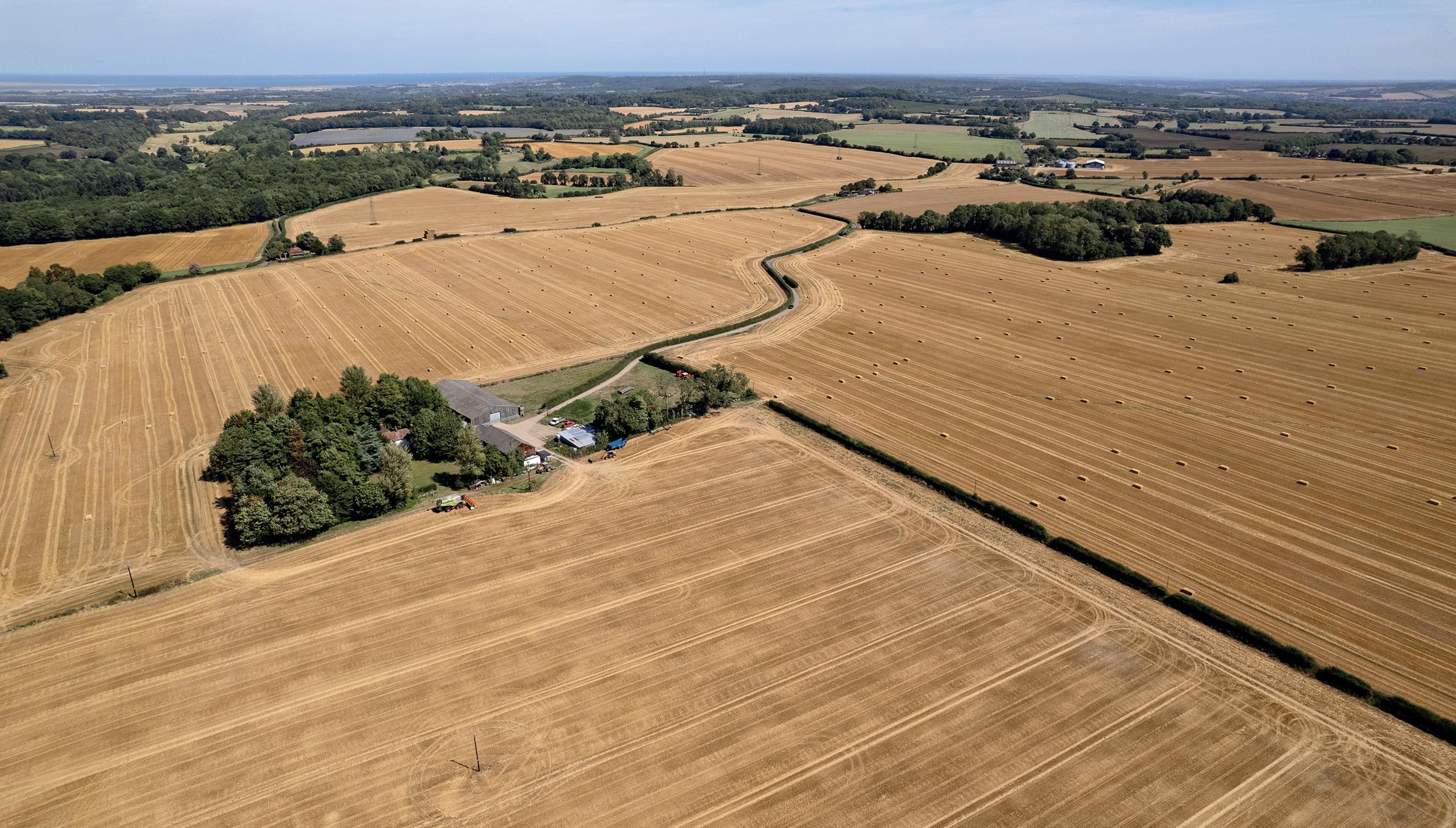
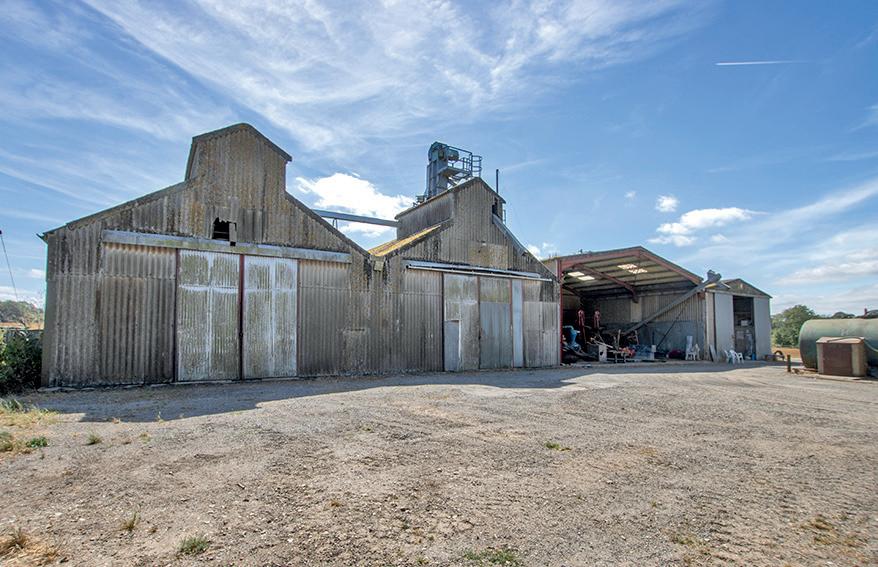

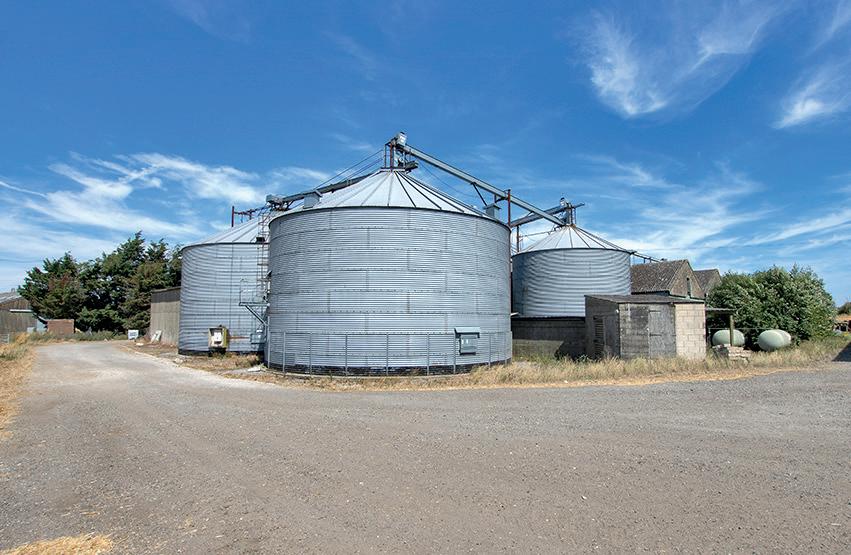
Kent, Molash Guide Price £4,650,000 A superb rural investment opportunity on the North Kent Downs
Chilham station: 4.2 miles (London St Pancras 63 minutes), Faversham: 7.5 miles, Ashford International: 9.8 miles (London St Pancras 38 minutes), Canterbury: 10.5 miles, Central London: 59.1 miles
Grade II listed farmhouse with 5 bedrooms | Traditional farm building with potential for conversion (STPP)
Various steel portal frame buildings and grain stores | 608 Acres of Grade 2 and 3 arable land
Let on an Agricultural Holdings Act 1986 tenancy
About 614 acres (248 ha) in total
Available as a whole
Will Whittaker
National Estates & Farm Agency | 020 7318 5166 will.whittaker@struttandparker.com
Liza Howden
National Estates & Farm Agency | 020 7591 2214 liza.howden@struttandparker.com
BTF Partnership is offering for sale a four-bedroom listed farmhouse with a range of traditional farm buildings and about 6.5 acres of land in an Area of Natural Landscape in the Wye Downs, Kent, with offers invited in the region of £950,000.
Kingsmill Down Farm has been in the same family ownership for over 100 years. It is located in an unspoilt part of the Downs, with a surrounding landscape of steep banks, arable fields, pasture and small woodlands. The farm was purchased in 1919 at auction and was previously part of the South Hill Estate. The farmstead comes with 6.52 acres, and part of the larger adjoining farm, which is being retained by the clients, may be available by separate negotiation.
The Grade II-listed farmhouse, with an internal area measuring 2,608 sq ft, now requires considerable renovation and gives southfacing views across the valley.
The farmyard is laid out in two parts, with the main yard enclosed as a courtyard with period buildings including: an early 19th century barn constructed in flint and brickwork measuring 9m x 18.05m, a traditional range of livestock housing with open bays measuring 20m x 3.36m, a ‘tractor’ shed measuring 10.55m x 5.43m, stables measuring 8.75m x 4.99m, two pigsties constructed in brick adjoining a granary measuring 4.34m x 5.77m on two storeys and three obsolete circular grain silos.
The second area of the yard consists of a range of lean-to garages and stores measuring 9.5m x 4.76m adjacent to the stables, a garage/ workshop measuring 6.31m x 6.1m, two Nissen huts measuring 10.5m x 12.33m x 5m, a four-bay concrete framed Dutch barn measuring 18.37m x 9m and a six-bay pole barn measuring 23m x 9m. OIRO: £950,000 £5,050,000
Steeped in history, Kitchingham Farm, recently launched to the market for £5,050,000, was first mentioned in the Domesday Book of 1086 and later owned by Cardinal Wolsey, one of the most powerful figures of Tudor England. Over the centuries the land has served many purposes, from agriculture to iron smelting and even as a hunting lodge.
For more information visit www.struttandparker.com


In the paddock next to the house is a four-bay pole barn measuring 18.5m x 11.5m.
The surrounding land has been entered into a Countryside Stewardship scheme which includes prescriptions to enhance arable land and pasture on the farm requiring the restoration and maintenance of species-rich grassland which is a feature of the Wye Downs Area. The house and farmstead overlooks this valley landscape to the south towards the village of Elmsted.
Richard Thomas, at BTF Partnership, commented: “This is a beautiful unspoilt and peaceful location in the Wye Downs, steeped in history. This is a truly once-in-a-lifetime opportunity to breathe new life into a rural farmstead which has significant potential subject to the necessary planning consents.”
In recent years, the farm has embraced a new chapter in its history with the establishment of a vineyard in 2021. Spread across 13 acres of south-facing land, the vineyard is now in its third year of production and is expected to produce 40 tonnes of Pinot Noir annually.
The farm includes a beautifully renovated, Grade II-listed, 16th-century oak-framed farmhouse, brimming with character. With its oak-framed structure, the farmhouse offers a harmonious blend of period features and modern living, including spacious reception rooms, an Aga-equipped kitchen and well-
maintained gardens. Beyond the farmhouse, Kitchingham Farm features a range of traditional and modern buildings, from barns and cottages to storage units.
The farm is ideally located just 1.6 miles from Etchingham, offering a blend of rural tranquillity and modern convenience. With direct train access to central London, it’s a haven for those who don’t want to sacrifice connectivity. The surrounding area is full of quaint villages, renowned gardens and established vineyards, while the south coast is only 20 miles away.
Kent | Selling Guide Price £950,000
An attractive parcel of arable and pasture land with viticulture potential
Chilham: 3.5 miles, Ashford International station: 11 miles (London St Pancras 38 minutes), Canterbury: 10 miles
Grade 2 arable land and pasture with road frontage
About 88 acres (35 ha) in total
Available as a whole or in three lots
Will Whittaker
National Estates & Farm Agency 020 7318 5166
will.whittaker@struttandparker.com
Liza Howden
National Estates & Farm Agency 020 7591 2214
liza.howden@struttandparker.com
Kent | Linton Guide Price £850,000
An accessible parcel of arable land with a block of mixed woodland at its heart
Maidstone: 3.6 miles, Ashford International station: 21.8 miles
About 89 acres arable land and about 6 acres woodland
About 96 acres (39 ha) in total
Available as a whole
Mark McAndrew
National Estates & Farm Agency 020 7318 5171
mark.mcandrew@struttandparker.com
Liza Howden
National Estates & Farm Agency 020 7591 2214
liza.howden@struttandparker.com






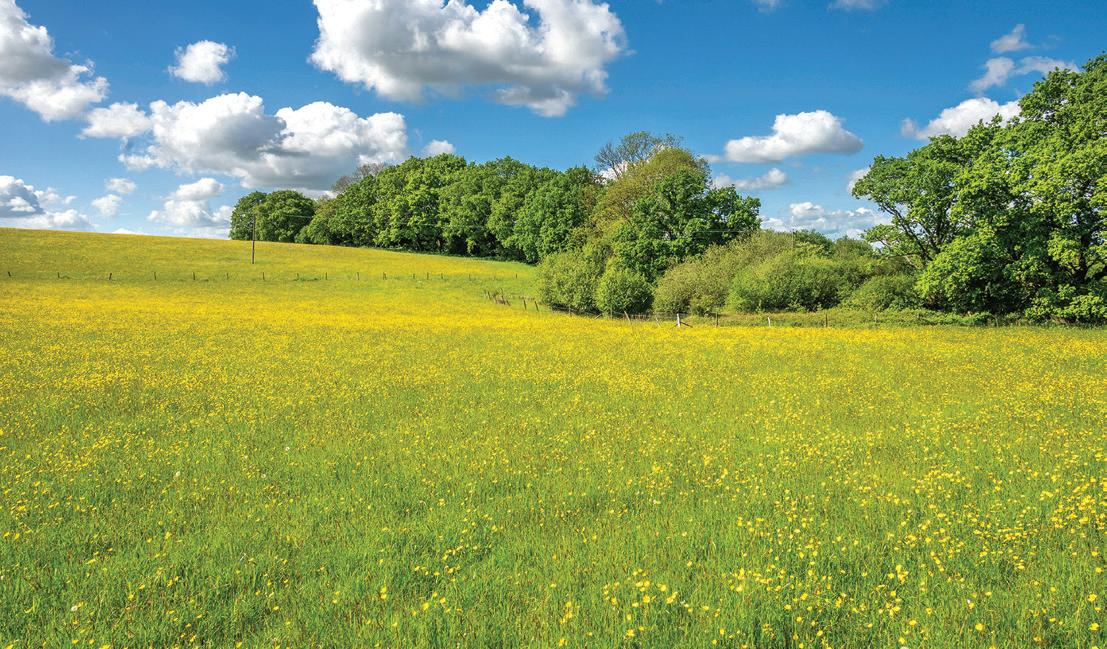



A former pub in Inkpen, Berkshire, with 112 acres of land and outbuildings offering conversion potential, has come to the market through Savills.
The Grade II-listed Old Craven Arms dates back to 1850 and was originally a pub for the South Berkshire Brewery. Now a six-bedroom family home, the house benefits from rooms of a good size with an
abundance of natural light and outstanding views of either the garden or surrounding countryside.
The land extends to 112 acres of permanent pasture for hay making and, historically, livestock grazing. A number of livestock buildings could be repurposed, subject to planning approval. The buildings benefit from a separate entrance from the
For more information, contact Savills’ southern rural agency team on 01962 857 404 or Savills Newbury on 01635 277705
road and the land also includes a stream, woodland and paddocks.
Tom Eyston, of Savills southern rural agency team, said: “This charming former Georgian inn is now an attractive family home in a brilliant location in the rolling countryside of West Berkshire, with good road links. The livestock buildings provide an incoming buyer with excellent potential for a variety of uses, subject to planning.”
Old Craven Arms is available as a whole, for a guide price of £3,550,000, or in four lots.
Land at Perry Wood is a collection of agricultural land nestled in the heart of the Kent Downs National Landscape.
The first and largest parcel, covering 66.62 acres, is known as Elm Bank. This field lies south west of Perry Wood and features gently rolling terrain, with a portion facing south, ideal for those interested in planting vines. Its grade two classification highlights the land’s excellent agricultural potential, while the stunning views of the surrounding countryside add to its allure.
Another parcel, approximately 15.84 acres, lies in an elevated position between Perry Wood and Grove Road. With access from both Shepherds Hill and Grove Road, this land has recently been planted with a shortterm grass ley but has a diverse cropping history, including borage and echium. The freely draining, slightly acidic loam soil – also classified as grade two - offers excellent versatility for various agricultural endeavours.
The final parcel, a charming 6.28 acre field, lies to the north of Perry Wood, adjacent to the second area. Currently planted with grass under a stewardship agreement, this land offers the same high quality, freely draining soil, perfect for continued agricultural use or conservation efforts.
Just one mile south of the charming village of Selling, the land enjoys the tranquillity of rural life while being well connected. With Junction 7 of the M2 only three miles away, the bustling town of Faversham is a five-mile drive and the historic city of Canterbury is just 10 miles away. It is available as a whole for £950,000.
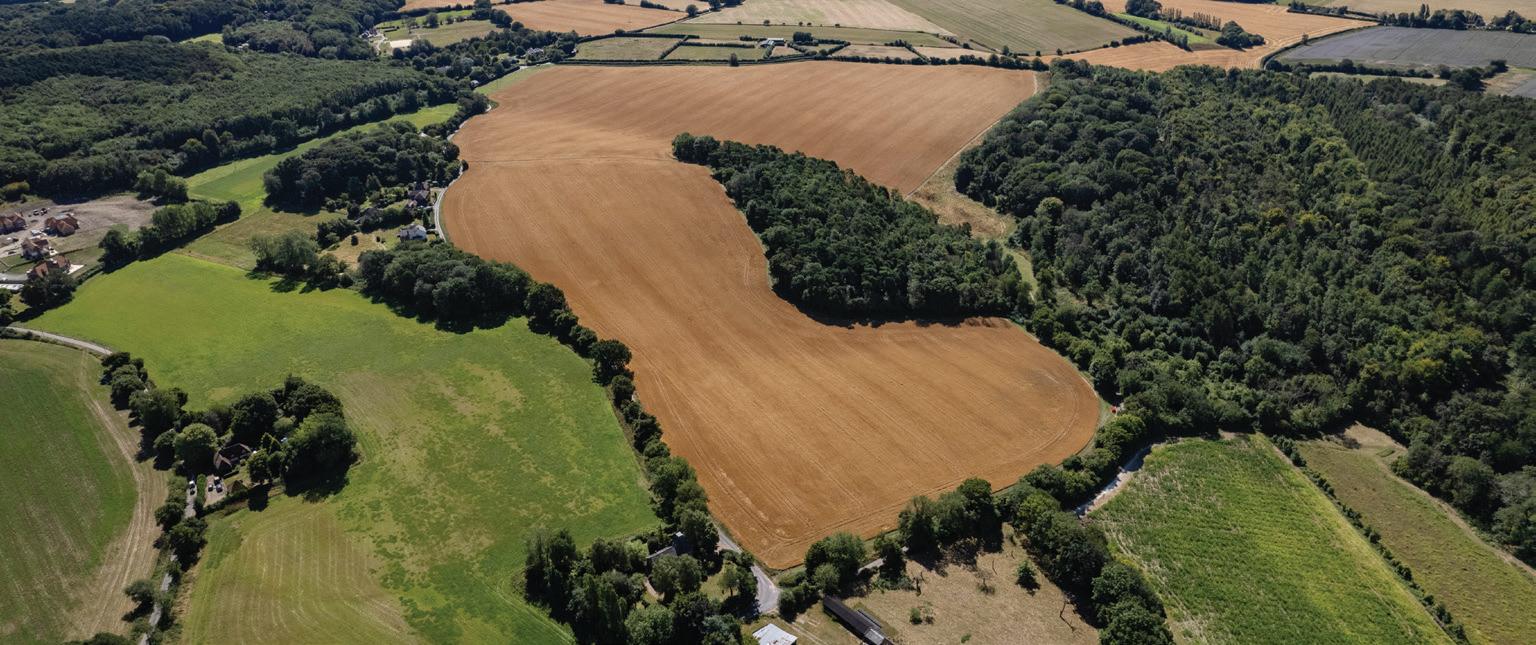
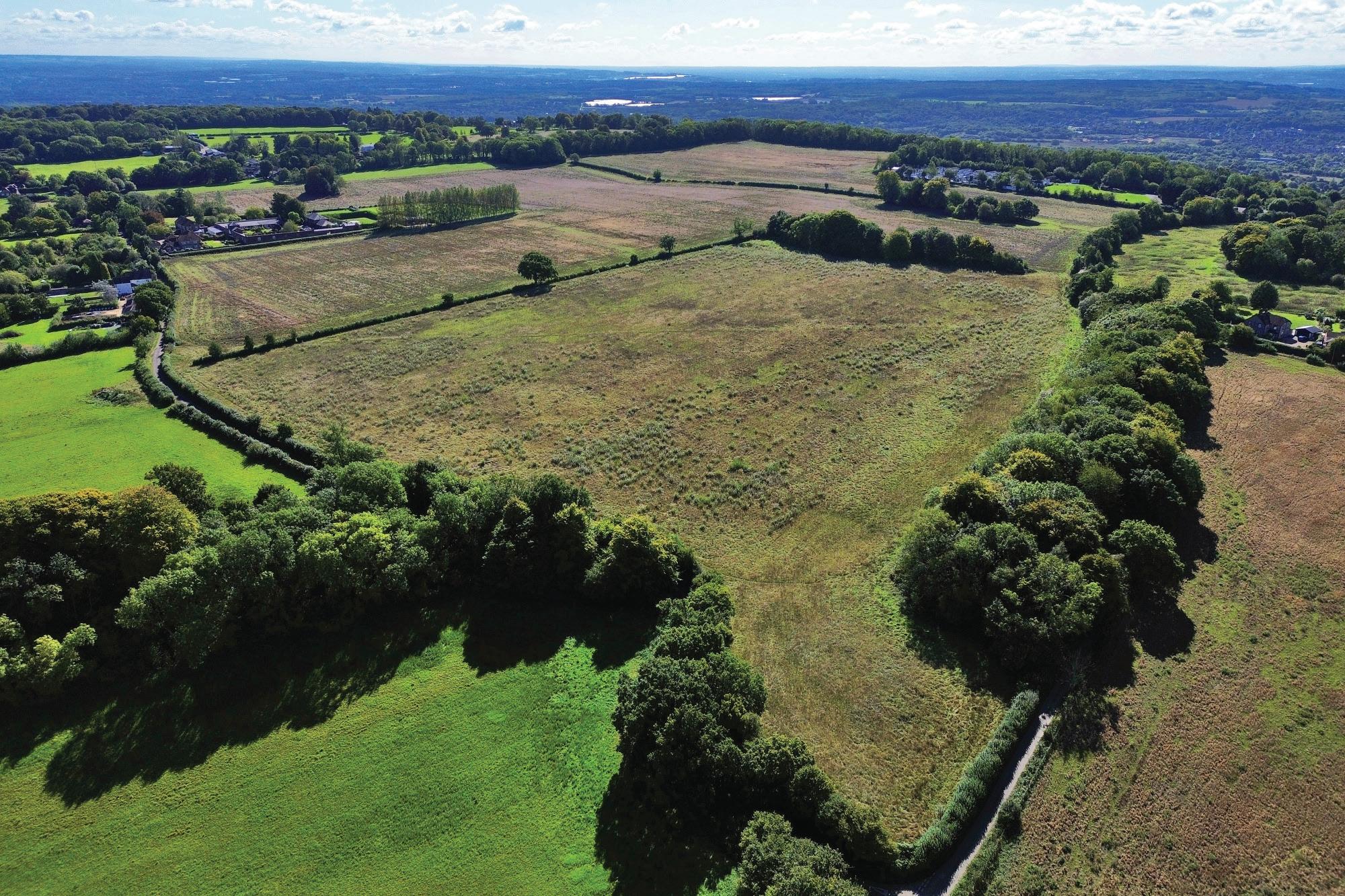


Director Farm Agency
07812 965
cspofforth@savills.com
07967 555 724 hriches@savills.com



• Steel frame buildings
• Sheeting and cladding
• Guttering and repairs
• Groundworks and drainage
• Demolition and asbestos removal
• Refurbishment and change of use
• Concrete frame and steel frame repairs
• Insurance and general repairs
• Concrete floor and block paving
www.gjelgarconstruction.co.uk
For more information contact us:
t: 01233 623739 m: 07860 414227
e: office@gjelgarconstruction.co.uk








Steel-frame buildings for your farm
+ Supply only or supply & erect
+ Construction all over the UK
+ Award winning company
Strength, Security, Style

Shufflebottom Ltd
Cross Hands Business Park, Cross Hands, Llanelli, Carmarthenshire SA14 6RE



























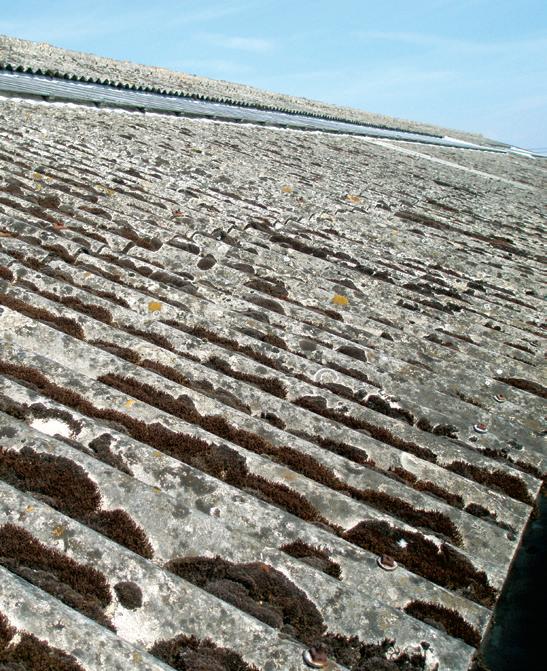

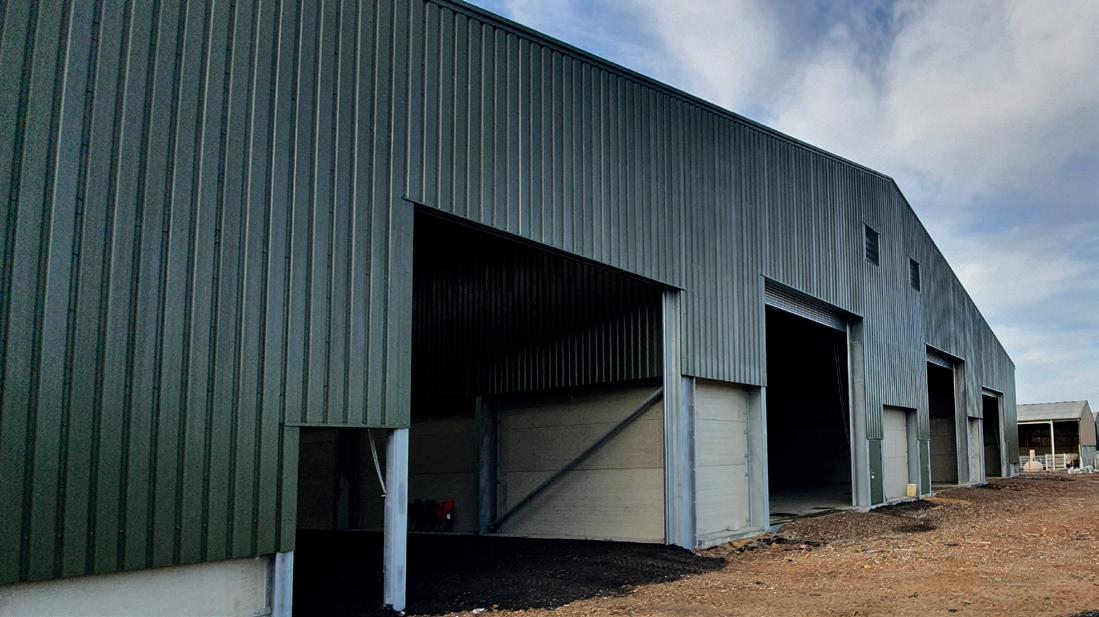













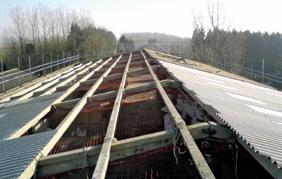


Roofing & Cladding - Strip & Re-sheet - Repairs
Metal Profile - Fibre Cement - Insulated - Timber Boarding
Asbestos Sheet replacements - New Roof lights
New Roofs Projects & Insulated Over-SheetingValley Gutter repairs & Re-lining
Asbestos Stripping & Environmental Waste Disposal
Refurbishments & Extensions to existing buildings
Change of Use & Rental Unit Conversions
Insurance Claim Works for Fire, Flood & Storm Damage
Same Day - Next Day, Site Visit, Inspection Service
Making Building/Premises Safe - Secure
Emergency Clear-Up Operations
Asbestos Stripping & Environmental Waste Disposal
Demolition & Site Clearance Works
Ground Works, Roads, Drives & Drainage Works
Re-Instatement Works
ALL WORKS GUARANTEED




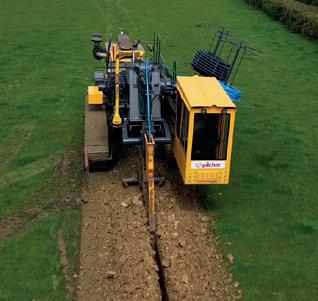








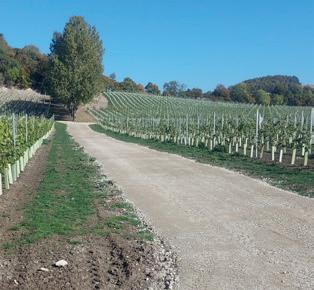
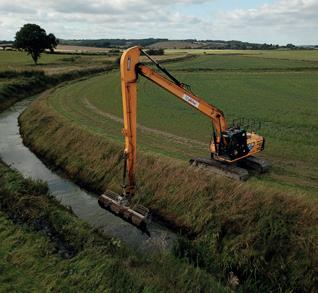
















Fencing
Straining posts
Chestnut
Chestnut fencing








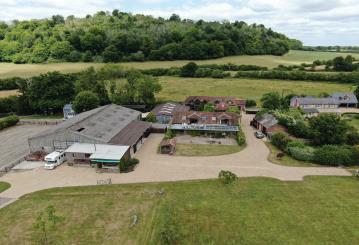









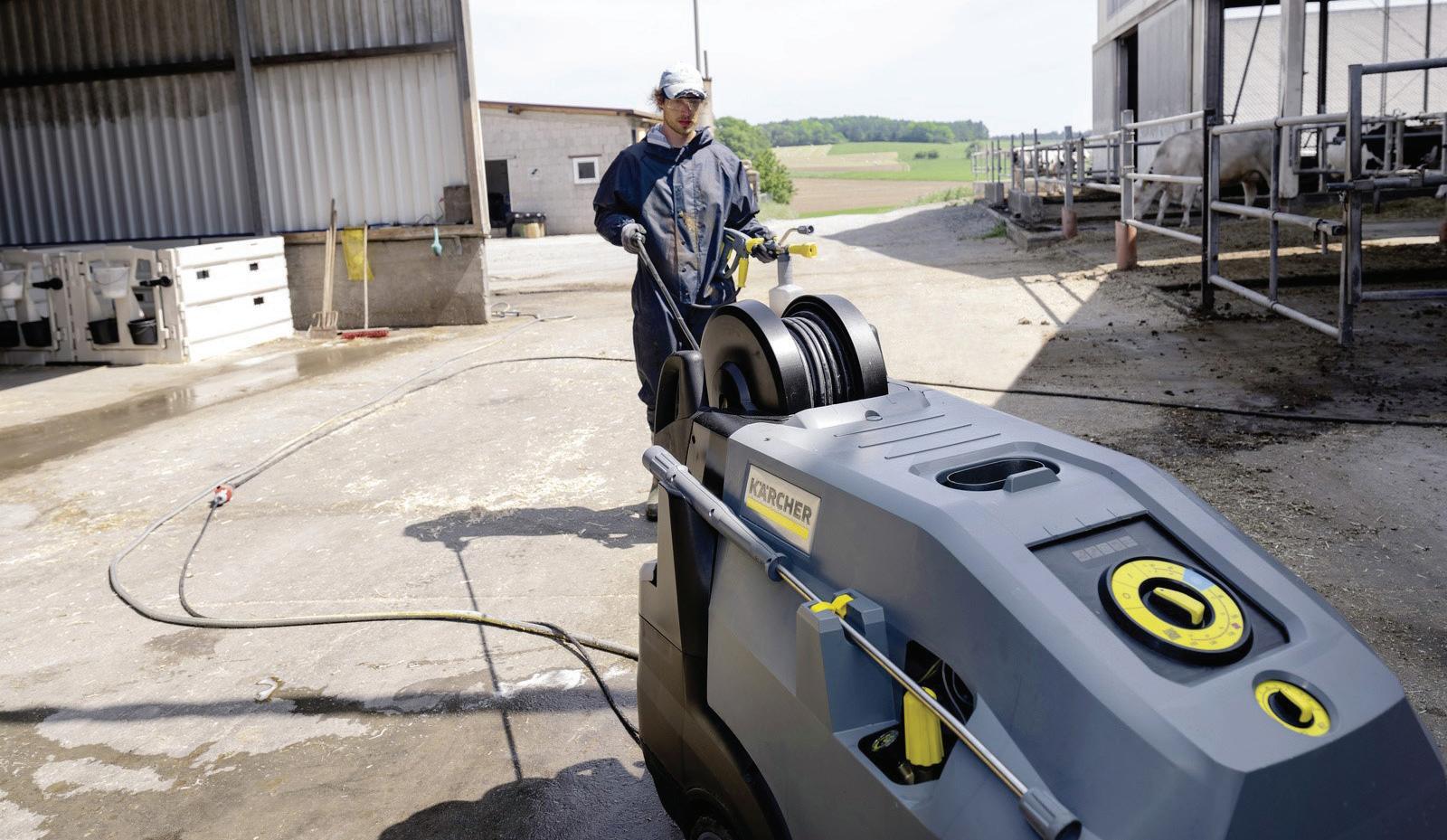










ACROSS
1 Vegetable, a small marrow (9)
5 Pair, couple, duo (5)
8 Hampshire town (7)
9 Frighten (5)
11 Challenge to do something (4)
12 Flowering plant used to flavour sweets (7)
14 Make an effor to remember (4,4,6)
16 Disturb a liquid (7)
18 Something that is likely to cause danger (6)
21 Wound dressing (7)
24 Green, kidney, bared (4)
26 Enclosed outdoor space (9)
27 People who hide intentions (9)
28 Soothe, hush, send to sleep (4)
DOWN
1 Leafy green vegetable (5)
2 Beneath (5)
3 Donate (4)
4 ------- Maple Leafs, ice hockey team (7)
6 Competed against each other (5)
7 Window covering (7)
10 Edge of the pavement (4)
13 Seabird (4)
14 Lengthy, frustrating procedure (9)
15 Uncommon (4)
17 Device to control water flow (3)
18 Patterned part of a tyre that makes contact with the road (5)
19 Brewed drink (3)
20 Plants that germinate, flower and seed in one year (6)
22 Metric unit (5)
23 Body of salt water (3)
24 Herb (5)








LAST MONTH’S ANSWERS:




































For a winter warmer we are offering readers the chance to win two bottles of Monks Delight, two bottles of Special Mead and one bottle of Special Reserve. For more information about the vineyards, please visit www.biddendenvineyards.com or call 01580 291726.
*Subject to availability



